

JUN 24 // COUNTRYROADSMAG.COM 2

// JUN 24 3
The Summer House by James Fox-Smith
NEWS
& NOTEWORTHIES
Remembering Chris Stafford, a threatened turtle’s hiding spot & cicada news.

Go au naturale at outdoor fests, garden workshops, and farm-to-table fare.
32
Understanding the Swallow-tailed Kite and its astonishing migratory journey by Alexandra Kennon Shahin
THE GATOR MAN
Educator Barry Guillot has introduced the wonders of the wetlands to hundreds of St. Charles students by Samantha E. Krieger 35
THE MUSIC OF THE RIVERCANE
Exploring the Indigenous roots of Hill Country Fife and Drum music, and the instrument at its heart by Jeffery Darensbourg and John DePriest
On the Cover
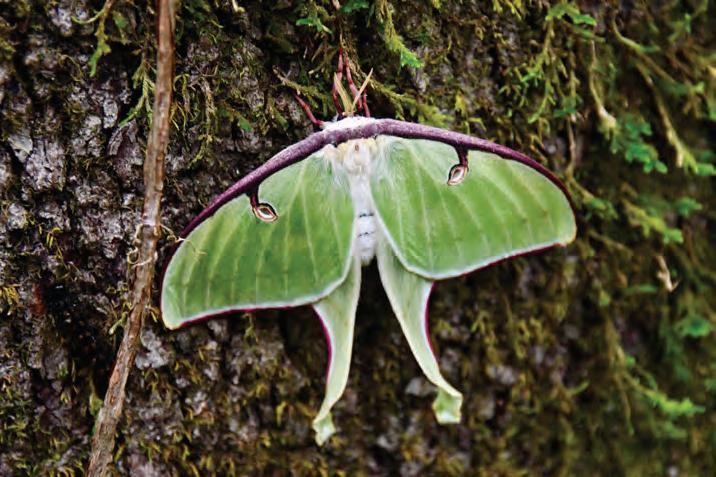
There’s a mystique about the Luna Moth (Actias luna) that stems first from its beauty, but second from its rarity. It is not actually a rare creature to exist (each female lays up to 400 eggs), but they are rarely seen—mysterious in their preference for night flight, and for the brevity of their existence. After six weeks as a caterpillar and three as a pupae, the moth at its most magnificent is a creature whose days are numbered; it doesn’t even eat. To encounter one in the wild is to align perfectly with this ephemeral life cycle among the the billions of life cycles, to be in the exact right place at the right time. Such luck graced our contributor Paul Christiansen on a recent visit to the Louisiana State Arboretum (page 52).
In her edition of “Our Sustainable Garden” this month (page 42), writer Jess Cole describes the benefits and wonder of “moon gardening”—creating environments for nocturnal pollinators such as the Luna Moth. The thing about humans and nature is that it’s not all left up to chance. With care, we can, in fact, cultivate environments for the better. We can draw the moth, briefly, to us.
EAT THE PROBLEM A chef’s mission to control invasives through cuisine by Mimi Greenwood Knight
Preserving the stories of Lafayette’s African American community for generations to come by Jordan LaHaye Fontenot
Hike, kayak & camp your way across the Cajun prairie by Kristy Christiansen
The Feliciana treasure that is Mary Ann Brown Preserve by Kristy Christiansen
What I think will happen when I speak Louisiana French perfectly by Megan Broussard
Through Gyotaku, Holly Garvin brings marine worlds to the surface by Mimi Greenwood Knight
Publisher James Fox-Smith
Associate
Publisher Ashley Fox-Smith
Managing Editor
Jordan LaHaye Fontenot
Arts & Entertainment
Editor Alexandra Kennon Shahin
Creative Director
Kourtney Zimmerman
Contributors:
Megan Broussard, Kristy Christiansen, Paul Christiansen, Jess Cole, Jennifer Coulson, Jeffrey Darensbourg, John DePriest, Mimi Greenwood Knight, Andrew Green, Nikki Krieg, Samantha E. Krieger, Fernando Lopez, Elise Riley, Mac Stone
Cover Artist
Paul Christiansen
Advertising
SALES@COUNTRYROADSMAG.COM
Sales Team
Heather Gammill & Heather Gibbons
Operations Coordinator Camila Castillo
President Dorcas Woods Brown
Country Roads Magazine 758 Saint Charles Street Baton Rouge, LA 70802 Phone (225) 343-3714 Fax (815) 550-2272
EDITORIAL@COUNTRYROADSMAG.COM WWW.COUNTRYROADSMAG.COM
expressed
The
are
of the
or
and do not necessarily reflect the views of the publisher, nor do they constitute an endorsement of products or services herein. Country Roads magazine retains the right to refuse any advertisement. Country Roads cannot be responsible for delays in subscription deliveries due to U.S. Post Office handling of third-class mail.
JUN 24 // COUNTRYROADSMAG.COM 4 Contents VOLUME 41 // ISSUE 6 JUNE 2024
Subscriptions $21.99 for 12 months $39.58 for 24 months ISSN #8756-906X Copyrighted. All rights reserved. No portion of
publication may
reproduced
publisher.
this
be
without permission of the
opinions
in Country Roads magazine
those
authors
columnists
8
Photo by Paul Christiansen
40 Cuisine Culture Events 28
AVIAN ODYSSEY
Escapes
SATIRE
50 A LITTLE GEM
54 SUMMER NIGHTS
11 REFLECTIONS
6 Features Introduction 52 ESCAPE
TO EVANGELINE
58 Perspectives MERMAIDING MEDIUMS
Outdoors OUR SUSTAINABLE GARDEN The night shift by Jess Cole 42 WHERE THE GLASS GOES
work
recycling glass in Louisiana by Samantha E. Krieger 48 SOUPÇON Louisiana food news by Country
Staff 41 MAISON
The
of
Roads
FREETOWN
46 THE CAJUN GRAND SLAM A fisherman’s feat by
Green 44
Andrew
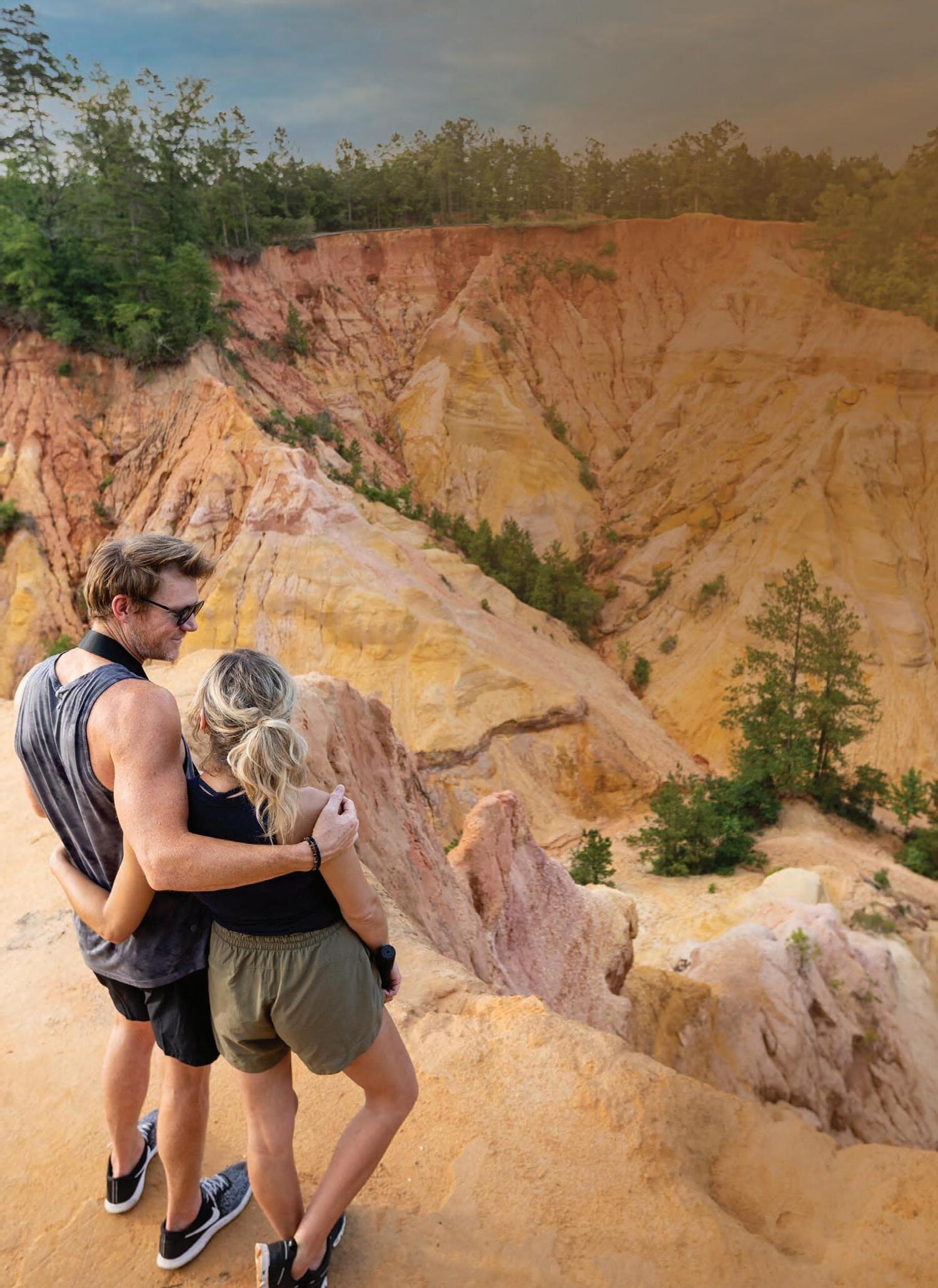
Scattered throughout our state, you’ll find unique and surprising landscapes that will inspire your sense of adventure. Red Bluff, Mississippi’s “Little Grand Canyon,” is just one such place. Here, cliffs were sculpted out of the native red clay soil by eons of erosion, creating stunning views of the Pearl River valley below. Discover this and other travel experiences at VisitMississippi.org/Adventure.
#WanderMS
// JUN 24 5
are places in Mississippi
There
where the clay actually molds you .
Red Bluff | Marion County, Mississippi
Reflections
FROM THE PUBLISHER
Around fifteen years ago, I took a walk with my father. Dad, who didn’t much care hfor physical exercise, had recently surprised everyone by announc ing he’d always wanted to walk across England—from the Irish Sea to the En glish Channel. But with his seventieth birthday approaching, he assumed he’d missed his chance. To her eternal credit, my wife made me promise that I would meet Dad in England and do that walk with him. The following summer, my father and I flew from our respective adopted homelands to Manchester, and for ten days followed the Coast-to-Coast Walk—a long-distance footpath that traverses 190 miles of starkly beautiful English countryside. As we walked, we talked. This was interesting because I had never known my father to talk much. In a stiff-upper-lip English way, Dad was a quiet, somewhat solitary man. But there’s something about putting one foot in front of another that loosens the tongue of even the most reticent conversationalist. During our time on the trail, Dad talked more freely than I had ever known him to do before.

the months following his father’s death he would sometimes be inconsolable. His mother, unable to deal with her little boy’s grief, would lock him in this summer house until he stopped crying, sometimes for hours. Dad remembered sitting alone on the floor, marking the passage of time in the way sunbeams falling through the stained-glass transom advanced across the floor. As he remembered, a single tear slid down his cheek. It’s the only time I ever saw him cry.
He spoke about all sorts of things. Some were funny, some startling, some sad. He talked about his and my moth-
rugged Lake District, his eye-popping ditties about the Bishop of Buckingham revealed the irreverent young man this soft-spoken English gentleman had once been, a side to him I’d never known. Dad also talked about his own father’s sudden death when he, an only child, was just nine years old. During the bleak, disorienting years that followed, his mother packed her lonely, grieving son off to a draconian boarding school on the Isle of Man and commenced her long slide into alcoholism. I was vaguely aware that Dad’s years at that school hadn’t been happy, but beyond explaining his loathing of Latin and institutional foods, it had never occurred to me to wonder what other impact they might have had. As he talked, I began to see why my father might have a hard time expressing emotion.
been born and raised in Manchester, so before setting out on our walk he spent a day showing me around. One afternoon he turned the rental car into a quiet street and parked near a house with a large garden around it. It was where he had lived as a child, and although the original house had been rebuilt, the garden looked much as he remembered it. In it stood a little pavilion of the kind that the English would call a “summer house.”
With a shingle roof, porthole windows, and a stained-glass transom above the door, it was the whimsical sort of structure from which gin and tonics might have been served during the garden parties of England’s postwar years, and in which the lawn chairs and croquet set would be stored in between. Leaning on the garden wall, Dad gazed at the summer house, then described how, in
If you read Country Roads often you’ve probably heard about my father before, since this column usually seems to inevitably turn towards family. Last month my dad died suddenly in Australia, a week before his eighty-fourth birthday. The day the news came, I got a flight and spent two weeks with my mother and siblings, crying, laughing, and remembering while we made arrangements to walk Dad home. As my parents grew older, I thought a lot about how it would feel when the time came to say goodbye. But I had no idea. Does anyone, ever? I suppose there are few experiences more natural than that of burying one’s father, since the responsibility to do so is an inevitable part of growing old. That doesn’t make it easier. So, I want to dedicate this Natural World issue of Country Roads to my father—a kind and gentle man whose quiet presence I will miss, and who I loved very much.
—James Fox-Smith, publisher james@countryroadsmag.com

JUN 24 // COUNTRYROADSMAG.COM 6

// JUN 24 7

Listen Close for the Cicada Concert

and build a parking lot, then you eliminated their food source,” and thus, the entire population in that area.
Hope is not entirely extinguished, though. As of midMay, Carlton said he had noted about half a dozen verifiable records of cicada sightings reported on iNaturalist in North Louisiana. “The problem with a lot of these observations is that there are no comments on them,” he said. “So you don’t know if this is a single cicada, or if there is a chorusing and reproduction event going on.”
AS THE GREAT SOUTHERN BROOD OF CICADAS EMERGES AFTER THIRTEEN YEARS OF SLUMBER, LOUISIANA’S POPULATION POSES QUESTIONS A TEENAGER’S DISCOVERY LEADS TO NEW KNOWLEDGE ABOUT THE RINGED MAP TURTLE
This summer, millions of Americans will get a glimpse at the mysteries beneath the earth’s surface. And that glimpse will be loud.
In a historic overlap of entomological timelines, two broods of periodical cicadas will emerge after over a decade underground—where they have lived most of their lives as nymphs, feeding on sap and tree roots—to mate, sing, lay eggs, and die. Known as Northern Illinois Brood (Brood XIII) and the Great Southern Brood (Brood XIX), the cicadas’ generations cycle through every seventeen and thirteen years, respectively. The last time these two broods emerged simultaneously was 1803.
The Great Southern Brood, which last emerged in 2011, is one of the largest of all periodical cicada broods (as opposed to annual cicadas, which have shorter lifespans, that emerge each year) and occupies a territory ranging from Maryland to Georgia and from Iowa to Oklahoma. The Northern Illinois Brood, which last emerged in 2003, is much smaller—its geographical range limited to areas in Michigan, Indiana, and Ohio.
Historically, the Great Southern Brood’s range has extended somewhat into northeast Louisiana—though this is up for some debate. “The documented records from the northern part of the state are very old—they go back hundreds of years,” explained Dr. Christopher Carlton, an Entomology Diagnostician at the LSU AgCenter and professor at LSU. “And if you look at different maps [of the Great Southern Brood’s distribution], you’ll see some localities in Louisiana, and other maps won’t show any. We’re not really sure of the actual distribution of this brood from the very beginning.”
When the brood last emerged in 2011, no cicadas were sighted here. According to Carlton, this suggests that if there was an active Louisiana population of the Great Southern Brood, it may have gone extinct. He explained that during the cicadas’ growth period, they must have access to viable tree roots. And being relatively immobile, they rely on the place they feed to remain stable for the entire thirteen years they are underground. “So anything that destroys that area during that thirteen year period—which is a long time—if you clear cut the trees
There is still time for more cicadas to crawl up through the northeast Louisiana soils. All citizen-scientist sightings can be reported through iNaturalist or the Cicada Safari App. Cicadas coming from the Great Southern Brood, as opposed to other periodical broods or annual cicadas, will be the only ones singing this summer. “If chorusing and reproduction are observed, that makes them part of Brood XIX by default,” said Carlton.
—Jordan LaHaye Fontenot
The Bogue Falaya’s Secret Species
For over forty years now, the Ringed Map Turtle (Graptemys oculifera)—a small chelonian with yellow accents, including a distinct yellow stripe covering its lower jaw—was believed to have exactly one geographical home in the world: the Pearl River system in Louisiana and Mississippi. Protected as a Threatened species under the Endangered Species Act since 1986, the little turtle faces threats including channelization, dam construction, sedimentation, and river channel erosion— as well as predators and collection for the pet trade.

But this spring, after three years of research, scientists have confirmed something remarkable: the Ringed Map Turtle has existed in another waterway, the Bogue Falaya, this entire time. The findings of the study, “Hiding in plain sight: Federally protected Ringed Map Turtles found in a new river system,” were published in the April 2024 issue of Herpetological Conservation and Biology by U.S. Geological Survey ecologist Brad Glorioso, biologist Will Selman from Millsaps College, and biologist Brian Krieser from the University of Southern Mississippi. Also included as an author on the study was eighteen-year-old Aidan Ford, an amateur nature photographer who discovered the Ringed Map Turtle in Covington, Louisiana in 2021.
Glorioso was browsing the citizen-scientist website iNaturalist when he saw Ford’s photograph in August of that year. Recognizing the threatened turtle in the photo, he reached out to Ford, who was fifteen at the time, and made plans to investigate himself. His biggest question was: were these turtles moved to the area by humans, or did they exist here all along?
“On a basic level, one of the significant facts of this study is how, even in the middle of a city on a well-traveled waterway like the Bogue Falaya, a federally-listed conspicuous basking turtle can go undetected by science for so long,” he said. Ford’s discovery is an example, he noted of how important citizen science work can be to our collective understanding of our ecosystems. “Scientists can only be in very limited places at any time. With public databases like iNaturalist and others, folks can be integral in discovering new populations of rare species or tracking the spread of invasive species, to name a few examples.”
That there are at least two separate populations of the Ringed Map Turtle, in two separate systems, gives the species a better chance at overall survival—since it is less dependent on the success of a single river system that might someday be vulnerable to catastrophic events like natural disasters or devastating pollution.
—Jordan LaHaye
Fontenot
JUN 24 // COUNTRYROADSMAG.COM 8 Noteworthy LOOK CLOSER NEWS, TIMELY TIDBITS, AND ASSORTED
• JUNE 2024
CURIOSITIES
Photo by Katja Schulz. CC BY 2.0 DEED, creativecommons.org/licenses/by/2.0.
Photo courtesy of Brad Glorioso.
In Memoriam: Chris Stafford
REMEMBERING ACADIANA’S MUSIC MAN, WHO WAS SO MUCH MORE THAN HIS MUSIC
On May 2, one of the most important musicians of Acadiana’s contemporary music scene was killed in a car accident at the age of thirty-six. Chris Stafford was a multiinstrumentalist and producer whose talent has been widely recognized since he was eleven years old. He is best known for his role as a founding member of the Grammynominated band Feufollet, but has contributed as fiddler, accordionist, vocalist, guiatrist, and holding various other instruments in performances with dozens of the region’s other major roots bands. His vital contributions to Louisiana’s musical landscape have been well-documented and honored these past few weeks, but in this issue, we asked Chris’s sister Elise Riley to offer a tribute in her own words to who Chris was even beyond the music.

To grieve my brother Chris Stafford is to have experienced a light so bright that its traces remain in every corner of every space he touched. To know Chris was a gift so pure that his presence created an energy within us that will be forever craved. To love “Staff” was to be a part of something bigger than yourself, a part of his everlasting impact that reverberates from the Acadiana community outwards into the larger world. I am so grateful to have loved someone so intensely that their absence is agony.
Chris Stafford was music, but he was more. He was a wonderful son, brother, uncle, partner, friend, and “burb” (my brother Michael’s toddler name for Chris, which stuck). He was a free spirit, and an old soul who carefully curated his life to fit his passions. He was easy to love, and his love was easy to receive. He showed that love through customized nicknames (“Weasel,” mine), through deep conversations on our Mom’s back patio, through smiles sent over the crowd, directly to you, from the stage. He was a total goofball, a side of him the lucky ones could see. He was the glue to so many fundamental connections and elements of our community. A poster child of our culture, who always remained humble through remarkable accomplishment. His impact is not one I can describe in words that will do justice, but we’ll see the remnants of its light everywhere we look, for the rest of our lives. He was simply the best around, one of the greatest characters this life has to offer. I and my family, and so many more, will love him forever, and I’ll forever be looking for a light half as bright.
Photo of Jo-El Sonnier by David Simpson
 —Elise Riley
—Elise Riley
// JUN 24 9
Chris Stafford performing at Festival International de Louisiane in Lafayette in 2018.
Photo by Olivia Perillo
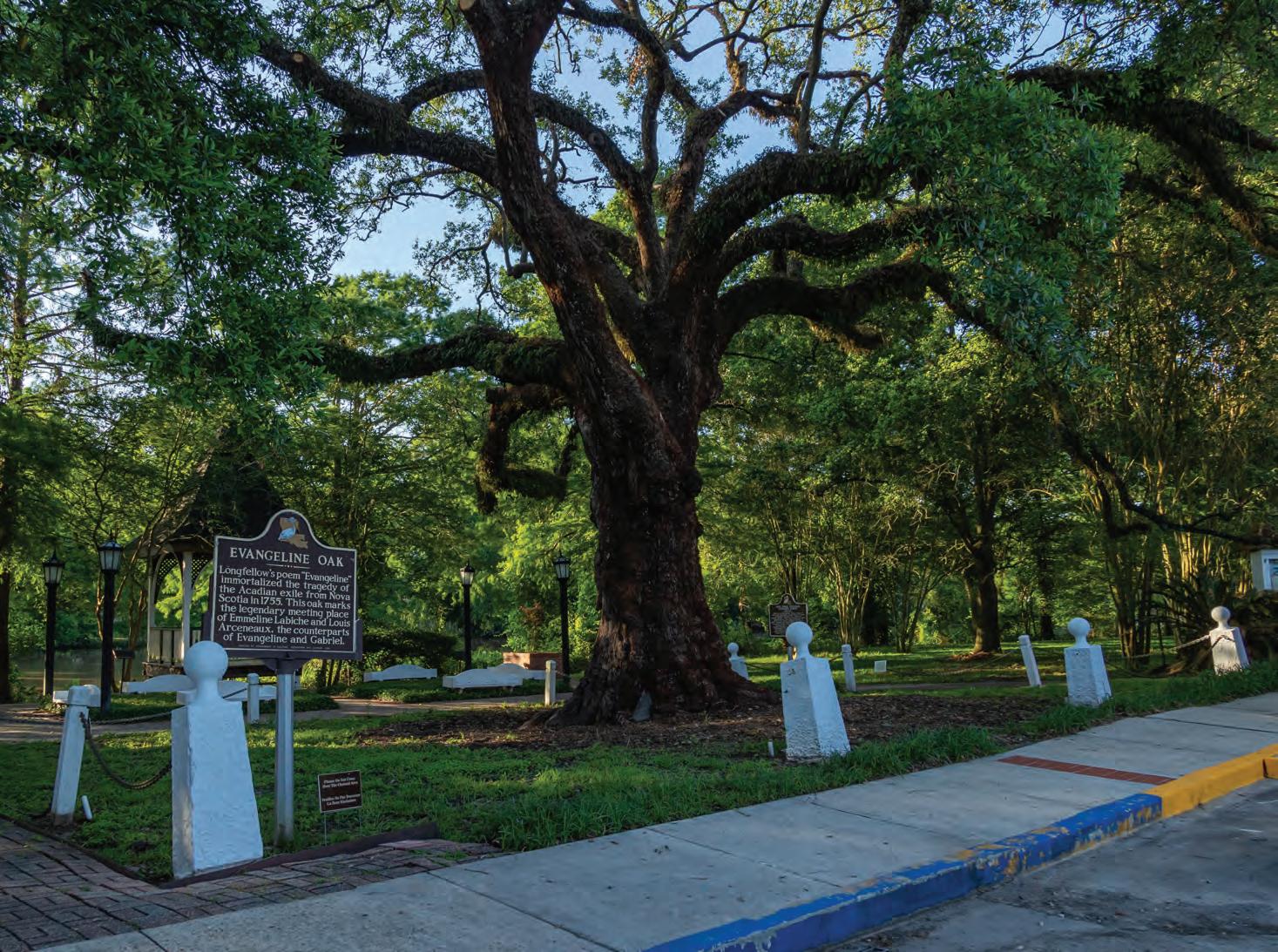
Evangeline
The live oak, the legend, the relic of our deep roots
In the heart of St. Martinville, Louisiana, where the currents of Bayou Teche meander gently by and Spanish moss sways delicately on, the majestic Evangeline Oak stands with roots firmly anchored in the rich soil of Acadian history. Evangeline’s ancient branches reach out, embracing stories of generations past. And its gnarled trunk carries the scars of a deep, lasting resilience.
In 1847, almost a century after le Grand Dérangement, when the Acadians were exiled from Nova Scotia and many found sanctuary in South Louisiana, New England poet Henry Wadsworth Longfellow was moved to write a story of star-crossed lovers, set in the context of
the Acadian diaspora. The resulting work was Evangeline, A Tale of Acadie, an epic poem in which heroine Evangeline Bellefontaine and her beloved Gabriel Lajeunesse are forcibly separated during the expulsion of the Acadian people. In a later adaptation of Evangeline’s story by Felix Voorhies, the Acadian lovers reunite under the live oak tree in St. Martinville. Though both stories are purely fiction, the live oak tree in St. Martinville has become eternally intertwined with Evangeline’s story, serving as a symbol of the fortitude of Acadian people.
The enduring lore surrounding the Evangeline live oak emerges from a profound sense of connection to the land and its people, attracting

thousands of visitors from around the world each year. From the arrival of the first Acadians in St. Martinville to the weekly wedding ceremonies held in the shade of its branches today, the Evangeline Oak stands as a silent witness to the ebb and flow of life along the bayou.
Taking care to preserve the strength and beauty of these living cultural treasures safeguards our stories for generations to come. Each oak tree holds within its branches the echoes of our past and the promise of our future.
JUNE 24 // COUNTRYROADSMAG.COM 10
Bob’s Tree Preservation • (888) 620-TREE (8733) • www.bobstree.com Article Sponsored by Bob’s Tree Preservation
JUNE 2024
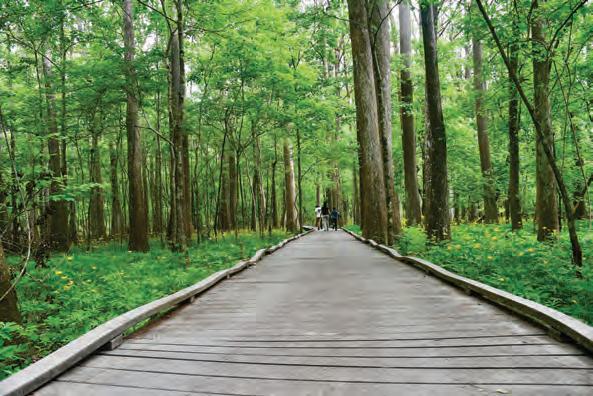
EMBRACE YOUR NATURAL SELF WITH OUTDOOR FESTIVALS, GARDEN WORKSHOPS, ART EXHIBITIONS, AND FARM-TO-TABLE FARE •


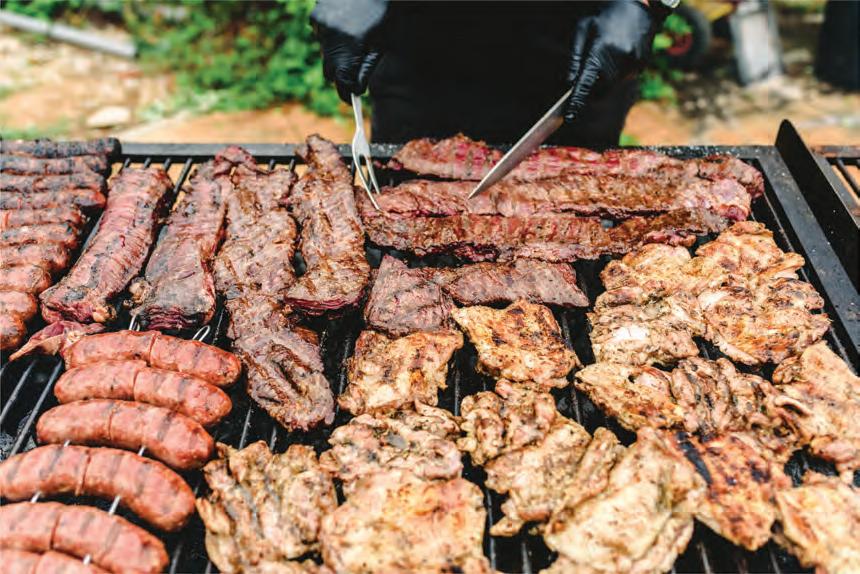
Jazz'n the Vines, Wild Bush Farm + Vineyard's long-running outdoor concert series, wraps up its spring season with a June 1 appearance by the all-female, Gulf coast Americana band, The Krickets. See page 13.
UNTIL DEC 1st
CREOLE ART
MITOLOJI LATANNYÈR/ MYTHOLOGIES LOUISIANAISES
Baton Rouge, Louisiana
In one of the largest public explorations of Louisiana's rich multilingual, multicultural intersections ever—this new exhibition at the Capitol Park Museum features over forty paintings, images, sculptures, and stories with accompanying texts in Louisiana and International French, Kouri-Vini, English, and even Tunica.
Mitoloji Latannyèr/Mythologies Louisianaises is curated by Jonathan "radbwa faroush" Mayers, who collaborated with dozens of Louisiana artists and writers to delve into their cultures' relationships with environmental devastation, social justice, and folklore. louisianastatemuseum.org. •
JUN 1st
GOOD EATS
DONALDSONVILLE WING FEST
Donaldsonville, Louisiana
Fly on over to Crescent Park this
weekend for Wing Fest, hosted by the Donaldsonville Area Chamber of Commerce. There will be competitions, live music by Big Frank Lil Frank, tastings, and the sauces will be practically flying off the grills into visitors' waiting mouths. Competition begins at 1 pm; music lasts from 6 pm–9 pm. For details call the chamber at (225) 473-4814. visitlasweetspot.com. •
JUN 1st
INDEPENDENCE DAY
RED, WHITE & BLUEBERRY FESTIVAL
Ocean Springs, Mississippi
The town of Ocean Springs, Mississippi, sets out to stain downtown streets and festivalgoers' teeth alike blue, during the 19th annual Red, White & Blueberry Festival. In addition to lashings of fresh blueberries, you'll find antiques, crafts, fresh produce, open houses for downtown businesses, and more. Don't miss the free vanilla ice-cream topped with your choice of blueberries or strawberries,
provided by the Ocean Springs Chamber of Commerce. 10 am–2 pm. (228) 8754424 or gulfcoast.org.
JUN 1st
ARTFUL OUTINGS
WHITE LINEN ART WALK
Natchez, Mississippi
The White Linen Art Walk returns to Natchez for its second year of celebrating the culture and arts community of the city. Expect local art, live music, food, and drinks, all amidst a sea of white-clad attendees at 100 N. Commerce St. from 6 pm–8 pm. visitnatchez.org. •
JUN 1st
FINAL BOW AT BATON ROUGE BALLET, A CURTAIN CALL
Baton Rouge, Louisiana
Baton Rouge Ballet Theatre has been synonymous with the names of Molly Buchmann and Sharon Mathews for a long time. During forty-eight years these ground-breaking leaders have built the




// JUNE 24 11
ACT NATURAL
Events
Events
Beginning June 1st
company to become one of Louisiana's most visible, professional, and highly regarded performing arts organizations. Along the way they have launched the careers of dozens of professional dancers, and ignited the passion for classical dance in the lives of many thousands more. Now, as Buchmann and Mathews hang up their pointe shoes for the last time, BRBT invites all dance lovers to join a curtain call celebration at LSU's Lod Cook Alumni Center for food, drinks, live entertainment … and dancing, of course. 7 pm–11 pm at 3838 West Lakeshore Drive. $100. batonrougeballet.org. •
JUN 1st
JUICY FRUIT
LOUISIANA PEACH FESTIVAL Ruston, Louisiana
We know, we know ... Ruston is kind of far. But we also know that most of you can't get enough Ruston peaches when the season rolls around. Make a peach pilgrimage to North Louisiana for this annual festival and its cooking contests, live music, juried handmade arts & craft marketplace, parade, antique cars, and
more. How many pounds of peaches can you eat in two minutes? Enter the peach eating contest to find out, and fill any leftover space with peachy-keen tarts, pies, salads, preserves, and main dishes. 9 am–5 pm. lapeachfest.com. •
JUN 1st
LITERATURE & LIBATIONS
THE WALKER PERCY WEEKEND
St. Francisville, Louisiana
Beloved for blending spirited literary discussion with social events, the ninth annual Walker Percy Weekend fortifies attendees for literary lectures and panel discussions with fine Louisiana food and beverages. The festival invites fans of Southern literature to explore Percy's thought and writing through presentations by renowned scholars, panel discussions, and social and culinary events inspired by the author's most famous works. This year the fest will explore the theme "The Speculative South." Events take place in atmospheric locations around St. Francisville's historic district. Highlights include a Saturday series of lectures and panel discussions on themes explored in Percy's books, a

New Orleans's Longue Vue House and Gardens invites all to celebrate Pride Month and Louisiana's LGBTQ+ community when the historic house museum hosts a free Family Equality Day on June 9. See page 18. Photo courtesy of Longue Vue House & Gardens.
series of catered Book Club Lunches led by featured lecturers, the traditional Saturday-afternoon Progressive FrontPorch Tour and Bourbon Tasting inspired by Percy's essay on drinking "Bourbon, Neat" at several private porches in St. Francisville's historic district. (5 pm–7:30 pm); and a Saturday evening "Taste of Louisiana" Southern supper, presented with a selection of local craft beers and served under the stars on the grounds of Grace Episcopal Church
(7:30 pm–10 pm). This year's featured presenters include writers and thinkers Dr. Jennifer A. Frey, Richard Grant, Bryan Giemza, Olivia Clare Friedman, and M.O. Walsh.
Festival proceeds support the Julius Freyhan Foundation—an organization dedicated to restoring St. Francisville's historic Freyhan School building to serve as a community and cultural center for West Feliciana Parish. $275 for all access ticket at bontempstix.com. •

JUNE 24 // COUNTRYROADSMAG.COM 12
JUN 1st
LIVE MUSIC
THE KRICKETS AT JAZZ'N THE VINES
Bush, Louisiana
Wild Bush Farm + Vineyards' longrunning outdoor concert series, Jazz'n the Vines, wraps up its spring season with an appearance by genre-bending Americana Gulf coast group, The Krickets. With an unforgettable sound built around deep folk-based harmony, The Krickets have captured hearts and accolades, including two IMA Song of the Year awards in both the Folk and Alternative Country categories. 6:30 pm–9 pm at 81250 Highway 1082 (gates open at 5 pm). Bring a picnic blanket, lawn chairs, and bug spray. Wine from Wild Bush Farm + Vineyards and delicious fare from Smokin' Buddha BBQ will be available for sale. $12 adults, $5 teens at bontempstix.com. wildbushfarmandvineyard.com. •
JUN 1st - JUN 8th
LGBTQ+ COMMUNITY
NEW ORLEANS PRIDE
New Orleans, Louisiana
When it comes to LGBTQ+ pride, New Orleans has been going big since the early 1970s. This year is no different, with the New Orleans PrideFest and Parade rolling strong—not to mention a host of
other events throughout the month. It starts at the top, with the New Orleans Pride Gala on June 1 at the LaBranche House—an evening of energy and excess, celebrating diversity and equality in the Crescent City. Dress code is formal rainbow, and guests can expect a silent auction, live music, dinner, and an open bar. Tickets start at $100, which includes a walker pass for the parade later that week; couples are $150. Other
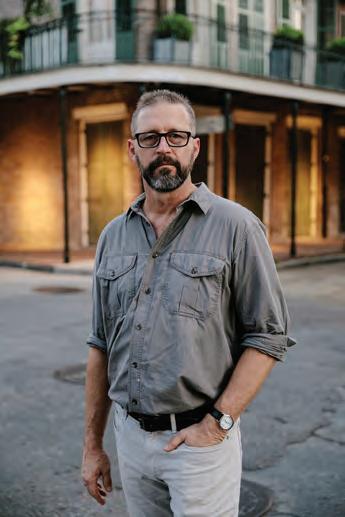
events include a Black Queer Legacy Summit on June 7 at the New Orleans Mariott—featuring workshops, panels, and exhibits centering the city's Black queer community—and a Black Queer Community Fest in Armstrong Park, with music, art, food, and more on June 8. Both of these events are free. June 8 also brings Louisiana's largest LGBTQ+ celebration to the Marigny at North Rampart and Elysian Fields around the Phoenix Bar. Expect arts and crafts vendors, DJs, and live music acts from LGBTQ+ artists starting at 11 am— including headliner Big Freedia. At 7 pm–10 pm, the annual Pride Parade will embark from Pridefest and head towards the Quarter, ending on Bourbon Street between St. Ann and Dumaine. Free. neworleanspride.org and nolapridefest.org. •
JUN 1st - JUN 9th
LOCAL ARTWORK
TREASURES OF POINTE COUPEE
New Roads, Louisiana
To the Julien Poydras Museum comes this fourteenth annual art extravaganza. Artists have been busy creating work inspired by Pointe Coupée Parish, and the results will take over the museum for viewers to peruse over two weekends. Besides the show, the event is completed by additional arts-related activities,
including adult and youth art workshops (for a small charge), an Arts Market, Conversations with the Artist programs, presentations, a silent auction, and more. The opening reception will be held May 31 from 6 pm–9 pm. Find the full schedule and more information at artscouncilofpointecoupee.org. •
JUN 1st - JUN 9th
CARNIVOROUS PLANTS
"LITTLE SHOP OF HORRORS" AT THE SULLIVAN THEATER
Central, Louisiana
Meek flower shop assistant Seymour pines for co-worker Audrey in the Sullivan Theater's production of the horror rock musical comedy. During a total eclipse, Seymour discovers Audrey II (whom he names for his cute coworker); the unusual plant feeds only on human flesh and blood. The growing plant attracts a great deal of business for the previously struggling store. After Seymour feeds Audrey's boyfriend, Orin, to Audrey II after Orin's accidental death, he must come up with more bodies for the increasingly bloodthirsty plant. Add three sassy loudmouth street kids and the owner of Skid Row's worst florist. Thursday–Saturdays at 7:30 pm; Sundays at 2 pm, with one Sunday 7:30 pm show on June 2 featuring an understudy cast. $30. sullivantheater.com. •

For life’s moments, big and small. We’re here with the strength of the cross, the protection of the shield. The Right Card. The Right Care.
// JUNE 24 13
01MK7923 R4/24 messy
English journalist Richard Grant, bestselling author of the non-fiction books Dispatches from Pluto and The Deepest South of All, will deliver a lecture entitled "My Southern Odyssey" at the 2024 Walker Percy Weekend, June 1.
T O B E

Events
Beginning June 1st - June 6th

JUN 4th - JUN 27th
SUMMER FLAVORS
A TASTE OF COVINGTON
Covington, Louisiana
It's the Northshore's favorite feast! "A Taste of Covington" gives St. Tammany Parish locals and visitors alike a golden opportunity to go deep with Covington's vibrant culinary scene.
JUN 1st - AUG 15th
TAKE A LOOK IN A BOOK SUMMER READING AT EBRPL
Baton Rouge, Louisiana
Adventure is always awaiting within the right book, and the East Baton Rouge Public Library is embracing that with their Summer Reading program theme, "Adventure Begins at Your Library!" The jewel of greater literacy is its own reward, but to sweeten the pot, the library will be hosting a vibrant slate of programs, from concerts to workshops and beyond. For specific details for each program ebrpl.com. •
JUN
2nd
RHYME TIME
A POETRY NIGHT IN FOLSOM
Folsom, Louisiana
Join Poet Laureate Alison Pelegrin for a poetry reading at Giddy Up Folsom. Food and beverages will be available for sale. 5:30 pm–7 pm. giddyupfolsom.com. •
JUN 3rd - JUN 8th
STRUT YOUR STUFF MISS MISSISSIPPI COMPETITION AND PARADE Vicksburg, Mississippi
The White Linen Art Walk returns to Natchez June 1, bringing local art, live music, food, drinks, and a sea of white-clad attendees to the streets. See page 11. Visit The Northshore, where the sunshine dances, the music twinkles, easy escapes are shore to be had. VisitTheNorthshore.com
Which accomplished young woman will claim the sparking crown and become Miss Mississippi? Watch it unfold for yourself in historic Vicksburg, starting with a grand parade along Washington Street at 7 pm Monday. The competition heats up Wednesday through Friday at the Vicksburg Convention Center, heading from the preliminary night of pageantry through the final round. It all comes to its conclusion on Saturday with the Miss Mississippi Crowning at the Convention Center. Find the full schedule and tickets at miss-mississippi.com. •
On select dates throughout June, all are invited to partake in special four(or more)-course vintner dinners at beloved local restaurants including Gallagher's Grill, Marcello's, Cured, and others. In addition, don't miss the Festa Del Vino at the St. Tammany Art Association on June 8—a premier wine tasting event featuring a live acoustic jazz performance by Chad Reeves; or other special events like the Father's Day Champagne Brunch on June 16 at Valencia, or the Global Whiskey Tasting and Toga Grand Tasting—both at Bogue Falaya Hall on June 22. All dinners and events require reservations. Details at atasteofcovington.com. •
JUN 5th
VISUAL ART
GALLERY TOURS OF "SITTING WITH RODRIGUE" Lafayette, Louisiana
Get a deeper insight into the Hilliard Art Museum's exhibition Sitting with George Rodrigue —a retrospective of the beloved artist's body of work, with an emphasis on Louisiana iconography. Monthly tours are led by staff from the Rodrigue Studios, home to most of the artist's gallery works. Attendance included in the museum's general admission fee ($7; $6 for seniors sixtytwo and older; $4.50 for students; free for children under five), but guests must RSVP at hilliardmuseum.org. •
JUN 5th - JUN 13th
CHILDREN'S SUMMER APPRENTICE PROGRAM
Baton Rouge, Louisiana
Those looking for an experience that goes beyond the typical summer camp should look no further than LSU Rural Life Museum's Apprentice Program. The week-long summer day camp takes campers back in time to the 1800s to learn traditional skills like blacksmithing, candle making, quill pen calligraphy, weaving, woodworking, and beyond. Open to students entering fourth through eighth grades for the 2024–2025 school year. 8 am–12:30 pm daily. lsu.edu/rurallife. •
JUNE 24 // COUNTRYROADSMAG.COM 14
Delighted SHORE
JUN 6th
GARDEN GIFTS
EBR MASTER GARDENERS ON MEDICINAL PLANTS, BIRDS
Baton Rouge, Louisiana
The East Baton Rouge Master Gardeners greet summertime by bringing combined programs about Medicinal Plants and Attracting Birds to the Central Branch Library.
Medicinal Plants : Master Gardener
Lyn Hakeem and Dr. Margaret Evans will provide a brief history of medicinal plants, with a focus on herbs that Dr. Evans has used in treatment and care of some of her patients. Handson preparations will teach audience member show to prepare medicinal herbs effectively.
Attracting Birds : Want to attract more birds to your yard? Master Gardener
Bob Dillemuth will discuss planning design, plant selection, habitat creation and other enhancements designed to make birds feel welcome in the home landscape. A Master Gardener since 2006, Dillemuth is a past president of the Louisiana Native Plant Society and a certified Louisiana Master Naturalist.
5:30 pm at the Central Library. Free. ebrmg.wildapricot.org. •
JUN 6th
SIGHTS & SOUNDS
QUINTRON AND MISS PUSSYCAT AT YES WE CANNIBAL
Baton Rouge, Louisiana
Multi-instrumentalist, one-band musical act Quintron will perform with his wife, the puppeteer and musician Miss Pussycat, at Yes We Cannibal to kick off their summer tour, accompanied by Acid/ Diamond. 8 pm. Free, but donations are always suggested for touring musicians particularly. yeswecannibal.org. •
JUN 6th - JUN 8th
THEATRE
ACA PRESENTS "MS. WARBUCKS" ORIGINAL MUSICAL
Lafayette, Louisiana
We all know and love Little Orphan Annie, but if you've ever been curious about what became of Annie later in life, The Acadiana Center for the Arts has just the musical for you. The ACA presents Ms. Warbucks, a locally written, produced, all-original musical inspired Harold Gray's original story. This interpretation of Annie's life is set in 1961, and follows the now 39-year-old Annie on a journey of forgiveness and belonging. Written by Caroline Helm Huval and Dr. Bonny McDonald, with music by Johanna Divine & Chas Justus, and directed by

Christy Leichty. 7:30 pm–9:30 pm, with a matinee on Saturday at 2:30 pm. $20–$30. acadianacenterforthearts.org. •
JUN 6th - JUN 9th
CULINARY COMMOTION
NEW ORLEANS WINE & FOOD EXPERIENCE
New Orleans, Louisiana
What began as a one-day meeting-of-theminds between winemakers and chefs a couple decades ago has mushroomed into a grand celebration of wine and food that attracts tens of thousands of people to New Orleans to worship before these
twin deities. This year's Food & Wine Experience offers Wine Dinners hosted by New Orleans area restaurants; Vinola fine wine tastings, the Tournament of Rosés, and culinary seminars which will fill the days and nights with all things culinary and oenological. Combination packages and full experience tickets available. nowfe.com. •
JUN 6th - JUN 22nd
THE BENDING OF THE BARD TULANE SHAKESPEARE FESTIVAL
New Orleans, Louisiana
Founded in 1993 by a handful of Tulane faculty members, the New Orleans Shakespeare Festival at Tulane has become one of the most significant theatre events in the Gulf South. This season the festival is opening with performances of The Complete Works of William Shakespeare (abridged) [revised] [again]. The traditional preview performance will be held June 6, and opening night on June 7—with performances Thursdays–Sundays through June 16 (7:30 pm Thursday–Saturday; 1:30 pm Saturday–Sunday). $40. On June 22, catch a onenight-only performance of (un)prompted Shakespeare: Macbeth —in which actors meet in the morning, rehearse once, and then perform the show that night with the script projected on the stage.


// JUNE 24 15
The designs of iconic fashion designer and Louisiana native Geoffrey Beene are on display at the LSU Textile and Costume Museum through January, 2025. Photo by Michael Mamp.
Events
Beginning June 6th - June 8th
7:30 pm. $25. All events will take place in Tulane's Lupin Theater. neworleansshakespeare.org. •
JUN 7th
LIVE MUSIC
CONCERT WITH PANTS PARTY
Zachary, Louisiana
Join the fun in downtown Zachary, where Pants Party will perform a free concert. Besides live music, there will be food trucks, art vendors, and plenty of dancing. 5 pm–8 pm. Contact ashleigh.mchugh@ cityofzachary.org. •
JUN 7th
CATS & CARS
FIRST FRIDAY FUNDRAISER FOR NORTHSHORE HUMANE SOCIETY
Folsom, Louisiana
Pack a lawn chair and head to the paddock at Giddy Up Folsom for an open-mic night, local art viewing, and food and drinks, all to benefit the Northshore Humane Society. Car lovers will also be in for a cruise, and pets are welcome. 6:30 pm–9 pm. giddyupfolsom.com. •
JUN 7th - JUN 9th
FOOD FESTIVITY
ST. LANDRY BBQ FEST
Opelousas, Louisiana
St. Landry ups the stakes for weekend BBQ, seeing what happens when they combine carnival rides, live music, shopping vendors, a rock-climbing wall, a mechanical bull, and a massive BBQ Cook-Off. It all gets underway Friday with live music by Kevin Naquin, Mike Broussard, and the Chee Weez. Local musicians will continue all weekend long, including Leon Chavis and Lil Nate, Rosie Ledet and Keith Frank. The Cook-Off will feature categories of every sort of pit-friendly feast you can imagine, from beef and seafood to wild game and dessert. Meanwhile, little ones get entertained at the petting zoo. At the Yambilee Building in Opelousas. stlandrybbqfestival.com. •
JUN 7th - JUN 9th
FESTIVAL
CAJUN HERITAGE FESTIVAL
Larose, Louisiana
The art and culture of wood carving is this festival's raison d'être, a celebration
going on for almost fifty years now. There'll be a decoy show and auction, carving demos, duck calling, raffles and more. And with a name like Cajun Heritage, rest assured there'll be plenty of jambalaya and other traditional treats on hand. Inside the Larose Civic Center. Free. Details at the Cajun Heritage Festival Facebook page. •
JUN 7th - JUN 9th
FOOD FEST
BON MANGÉ FESTIVAL
Gheens, Louisiana
Down there in the Lockport neck of the woods, lies the community of Gheens, where good-natured Gheenians have been putting on an annual 'good eats" celebration to mark the end of the spring festival season at the VacherieGheens Community Center, and they'vef been doing it for fifty years and counting. Expect Cajun food, rides, and dancing—and a festival queen, of course. There'll be live music performances by Gary T, Kings of Neon, J.P. Bourgeois Band, Benjamin Bruce and the Acadians, Shorts in December, Pot 2 La, and more. 8 pm–midnight Friday; 11 am–1 am Saturday; 11 am–6 pm Sunday. Free. Details at the Gheens Bon Mangé Festival & Community Center Facebook Page. •
JUN 8th
THE AIR UP THERE
ROCKIN' ON THE RUNWAY
Sunset, Louisiana
Keep your eyes on the skies for this annual Acadiana aerial event, which features stunning aerobatic performances by stunt pilot teams including GhostWriter, Titan Aerobatic Team, SRC Airshows, and Robby Grice. Closer to sea level, live bands Nik-L-Beer and DJ Digital will keep toes tapping, while kids get to enjoy airplane rides and other activities, including a car show. All proceeds support St. Mary's Residential Training School, which provides opportunities for Louisiana children and young adults with developmental disabilities. 4 pm–10:30 pm at Red Oak Landing, 2303 Hwy 178. $20; children younger than twelve get in free. rotr-la.com. •
JUN 8th
LIVE MUSIC
RUSTY YATES BAND AT THE POYDRAS CENTER
New Roads, Louisiana
The Arts Council of Pointe Coupee's annual Performing Arts Series presents high-energy musicians who have been favorites at the French Quarter Festival and Jazz Fest in New Orleans, as well

JUNE 24 // COUNTRYROADSMAG.COM 16

as some strong regional vocalists who have come highly recommended by PAS patrons. This month The Rusty Yates Band comes to rock the Poydras Center in New Roads. Doors at 6 pm; performances from 7 pm. $30; $10 for students. artscouncilofpointecoupee.org. •
JUN 8th
STREET FESTIVAL DUDGEMONA SUMMERFEST
Winnfield, Louisiana
The Dugdemona Summerfest returns to Winnfield's Main Street, delivering an

evening of live music, arts and crafts, and summer fun. This year's lineup features Spencer Brunson, Deep Water Rehab, Josh Love Trio, and LA Roxx.
4 pm–midnight. Free. Details at the Dugdemona Fest Facebook Page. •
JUN 8th
HISTORICAL REENACTMENT
THE DAY THE WAR STOPPED
Saint Francisville, Louisiana
Feliciana Masonic Lodge #31 reprises its annual reenactment of the Masonic burial at Grace Episcopal Church of Union
Lt. Commander John Elliot Hart—a moment during the Civil War when two warring sides laid down arms to honor the fallen. It happened in June, 1863, when the bloody siege of Port Hudson was pitting 30,000 Union troops against 6,800 Confederates, fighting for control of traffic on the Mississippi River. The USS Albatross was patrolling the Mississippi off Bayou Sara when its commander, Lt. Hart of Schenectady, New York, died aboard ship. Unable to obtain a suitable coffin, an ensign was sent ashore to make arrangements for a Masonic burial. Once ashore, officer Theodore DuBois contacted Masons in nearby St. Francisville to request a Masonic service. Word reached Captain William W. Leake, an officer in the Confederacy and the Senior Warden of the Feliciana Lodge, who found it his duty to afford a decent burial for his fellow Masonic brother. Thus were animosities put aside and the war stopped, if only for a few hours. Each year the Lodge and the town gather to commemorate the day with various events, including a play at Grace Episcopal (9:30 am), a burial (10 am) and graveside reenactment at the corner of Prosperity and Ferdinand streets (10:30 am), a jambalaya cookoff along Prosperity Street (11 am–1 pm), dancing and music (12:30 pm–2 pm) at Grace Episcopal, and more. visitstfrancisvillela.com.

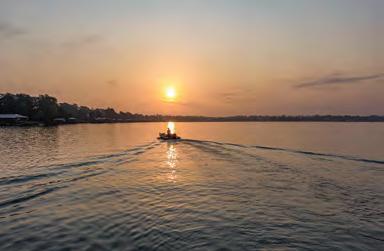



JUN 8th
CONTEMPORARY CLASSICS
DAVID CHO - CELLIST
Cleveland, Mississippi
Cellist David Cho will give an engaging and intimate solo performance in Cleveland's Cotton House lobby from 4:30 pm–6 pm. Free. eventbrite.com. 3
JUN
8th
SUDS
THIBODAUX ON TAP
Thibodaux, Louisiana
Back by popular demand, Lafourche Parish brings back its brand new beer festival, savvily dubbed Thibodaux on Tap, for year two. Meet the brewers downtown for an evening of good eats, live music, and fresh, local beer.
6 pm–10 pm. $40 gets you unlimited two oz. beer samples and a souvenir cup; $5 for designated drivers. thibodaux-mainstreet.ticketleap.com. 3
JUN
8th
SKI BUMS
LA NIGHT JAM
Zachary, Louisiana
Louisiana's sole water sports festival and professional extreme water sports competition returns for a second year. The La Night Jam, presented by



// JUNE 24 17
La Night Jam, Louisiana's summertime extreme water sports competition, presents a thrilling showcase of performances by professional water-skiers at the Tri-Lakes water complex in Zachary, June 8.
Events
Beginning June 8th - June 14th
showcase on the water performed by international professional water skiers. Held at the Tri-Lakes water complex in Zachary, Louisiana, home to Bennett’s Water Ski and Wakeboard School, this event features thrilling spectacles like extreme distance water ski jumping, freestyle ski jumping, slalom skiing, and more, along with food, DJ music, and drinks. Tickets are available for $20 per carload, and the event details can be found at lanightjam.com. •
JUN 8th - JUN 9th
FEAST-IVAL FLAVOR
CREOLE TOMATO FESTIVAL
New Orleans, Louisiana
It's another bright, juicy year ripe for celebrating South Louisiana's favorite summer bounty: fresh Creole tomatoes. Those beloved fruits are set to take over the French Market to mark the official opening of Creole tomato season with a "Ripe and Ready" second line featuring a local jazz band, The Baby Dolls, and the Amelia Earhawts on Saturday at 10:30 am, followed by live music on three stages. Of course, there'll be a wealth of food booths featuring the star of the show: the Creole Tomato. 10 am–7 pm. Free. frenchmarket.org. •
JUN 9th
HERITAGE FESTIVAL
CRÉOLE CULTURE DAY AT VERMILIONVILLE
Lafayette, Louisiana
Créole Culture Day returns this summer at Vermilionville. The event, presented by the venue in partnership with C.R.E.O.L.E. Inc., celebrates Créole heritage and culture with food, history, crafts, dance, and art. Live music will be performed by Wayne Singleton and the Same Ol' Two Step, and visitors can explore their own musical talents at Louisiana Folkroots' "Instrument Petting Zoo". Explore Créolité through artwork by Anne Guillot and poetry by Alex PoeticSoul Johnson. And finally, dive into the local corner of Beyoncé discourse with a discussion led by Jacqueline Jones from Baton Rouge Community College, who will present "The Forgotten Trailblazers: America's Black Cowboys". Come celebrate the Créole traditions that have influenced the contemporary folklife that permeates through the region, for one day only. 10 am–4 pm. Free. bayouvermiliondistrict.org. 3
JUN
9th
PRIDE PARTIES
FAMILY EQUALITY DAY
New Orleans, Louisiana
Celebrate the many contributions LGBTQ+ individuals make to the New Orleans community with a free, familyfriendly celebration at Longue Vue House and Gardens. The program includes a story time, dance performances, fan decorating, a community resource fair, and a children's parade. 10 am–1 pm. longuevue.com. •
JUN 9th - JUL 28th
ART EXHIBIT
PHOTOGRAPHY MEETS
COLLAGE AT NOPA
New Orleans, Louisiana
Although many collages incorporate photographs, the intersection between the two mediums is not often explored. The New Orleans Photo Alliance's new exhibition, Where Photography Meets Collage, showcases artists whose work creatively merges the disciplines of photography and collage—whether by collaging their own photographs, making photomontages, or employing collage-like processes in photography composition or development, further enhancing our understanding of this intersection. Opening reception on June 12 from 5:30 pm–8 pm. neworleansphotoalliance.org. •
JUN 13th
LIVE MUSIC
KID CHARLEROI AT THE ACA Lafayette, Louisiana
Next up in the Acadiana Center for the Arts's NXT Series, Lafayette's own Kid Charleroi—the solo project of Amanda Sphar—takes the stage, performing her 1970s soft-rock ballads rife with nostalgia, and dripping with longing. For this performance, Kid Charleroi will expand on its typical five piece band to include a horn section, more keys, guitars, and harmonies. 7:30 pm. $20. acadianacenterforthearts.org. •
JUN 13th
MOTOR CITY MUSIC
ONSTAGE AT FUHRMANN
AUDITORIUM: TRIBUTE TO MOTOWN Covington, Louisiana
As part of its OnSTAGE concert series, Covington Cultural Arts & Events presents Motown tribute artist Jeff Cryer. An expert of nostalgia able to perfectly recreate that

On June 8, the Rockin on the Runway airshow brings stunning aerobatic performances to the skies above Sunset, Louisiana. Participating stunt teams include the Titan Aerobatic Team, SRC Airshows, and GhostWriter (above). See page 16.
iconic Motown sound, Cryer performs classics from the greatest groups from the era-defining genre. 7 pm–8:30 pm. $20. bontempstix.com. •
JUN 13th - JUN 15th
A SHUCKING GOOD TIME LOUISIANA CORN FESTIVAL Bunkie, Louisiana
Sink your teeth into Avoyelles Parish's most important harvest celebration at this annual festival in downtown Bunkie, where you'll find corn shucking, corn eating, corn-cooking contests, street dancing, arts & crafts vendors, pirogue races, a state-wide softball tournament, a carnival midway, and live music by the likes of Geno Delafose & French Rockin' Boogie and The Chee Weez all weekend long. Come to honor the impact of our local corn farmers, and stay to pack away all the mouth-watering, hot buttered corn you can. And don't miss the city-wide parade, rolling out at 10 am on Saturday. bunkiechamber.org/corn-festival. •
JUN 14th
VOICES RAISED "A JOYFUL NOISE"
JUNETEENTH CONCERT BY HERITAGE AT LSU MOA
Baton Rouge, Louisiana
Honor the day America became a
place of freedom for all by attending a performance at the LSU Museum of Art by local chorale group, Heritage. Founded almost fifty years ago with a mission to preserve negro spirituals like "Oh Holy Lord," and "Ain't-a-That Good News," the group continues to carry these traditions into the next generation. 6:30 pm on the fifth floor of the Shaw Center, downtown. Free. lsumoa.org. •
JUN 14th - JUN 15th FESTIVAL
FRANKLIN SOUL FOOD FESTIVAL
Franklin, Louisiana
Head down to the bayou (the bayou side of Teche Drive, that is) in Franklin to find delicious soul food, live music, and more in celebration of the community. This year's lineup includes music by DJ Fab, Lil Nate and the Zydeco Big Timers, Bunk Johnson Band, Get Cha Sum Band, Kenny Wade Band, Andrew Jackson, and Mr. Hot Topic. Details at the Soul Food Festival page on Facebook. •
JUN 14th - JUN 16th
A CLAMOR FOR CLAWS
HOLLY BEACH CRAB FESTIVAL
Cameron, Louisiana
This sunny festival on the iconic Cajun Riviera goes all in on the delicacy of
JUNE 24 // COUNTRYROADSMAG.COM 18








7–10 PM 6TH FLOOR • SHAW CENTER FOR THE ARTS • DOWNTOWN BATON ROUGE, LA RAIN OR SHINE EVENT / TICKETS REQUIRED / TICKET SALES FINAL / NON-REFUNDABLE T HE BEST VIEW IN BATON ROUGE • FOOD PROVIDED BY TSUNAMI DINNER FIREWORKS MUSIC LIMITED SPACE BUY TICKETS TODAY WWW.LSUMOA.ORG 6TH FLOOR ROOFTOP TICKETS! Buy your tickets today before they sell out! Enjoy food, music, and a stunning fireworks display over the Mississippi River. SCAN TO BUY TICKETS WWW.LSUMOA.ORG ROOFTOP CELEBRATION FRIENDS OF THE LSU MUSEUM OF ART
THURSDAY, JULY 4 •
Events
Beginning June 14th - June 15th
Gulf Blue Crabs, with crab bingo, crab racing, and a crab cookoff—not to mention axe-throwing, a dunking booth, sand castle building lessons, and music by DJ Troy. Not to mention, plenty of opportunities to catch a juicy blue on a line. Along the Creole Nature Trail All-American Road at 2412 Heron Street in Cameron. Free. (409) 3656598. visitlakecharles.org. •
JUN 14th - JUN 30th
THEATRE "CINDERELLA" AT THEATRE BATON ROUGE
Baton Rouge, Louisiana
Will Cinderella find her glass slipper, and live happily ever after with her Prince Charming? We all know the answer, but that doesn't make it any less magical to see it play out live on stage—especially when accompanied by a sparkling and beloved Rogers and Hammerstein score, and directed by Paige Gagliano for the Theatre Baton Rouge stage. 7:30 pm Thursday, Friday, and Saturday; 2 pm Sunday. $40 for adults, $25 for students and children at theatrebr.org.
JUN 15th
BLACK HISTORY
JUNETEENTH MUSIC FESTIVAL
Donaldsonville, Louisiana
For twenty-nine years now Donaldsonville has celebrated freedom as it's meant to be celebrated—with good food, good music, and good company. This year, add good health to that list, as the Juneteenth Music Festival expands to add resources focusing on African American health and wellness. The event kicks off at 11 am with a prayer and history of the day when all enslaved people learned that their freedom had been granted by the Emancipation Proclamation. Festivities continue with live music from Angel of Faith, Total Control Band, the Michael Foster Project, and others. 11 am–7 pm at Louisiana Square. Free. Details on the Juneteenth Music Festival-Donaldsonville, Louisiana Facebook page. •
JUN 15th
ARTS & CRAFTS
SUNFLOWER TRAIL & FESTIVAL
Gilliam, Louisiana
The annual Sunflower Trail and Festival brings art and entertainment to the grounds of the Red River Crossroads

Museum. Visitors will find all sorts of handmade items by heritage crafters and artists for sale, arts and crafts activities for kids, exhibits of local art, a sunflower photography contest exhibit, and more. New are exhibits of local vintage tractors and the unveiling of a mural by artist Diane Long. Food and refreshment vendors will be on-site, or you could visit a local favorite like Main Street Restaurant, James Country Store Restaurant, or D&I Café and Deli. Don't drive all that way without leaving time to explore the Sunflower Trail, which winds through fields planted with sunflowers, and more than a few wildflower meadows. To drive it, turn right at Old Dixie Gin and Sentell Road, and drive the loop around the levee. Sentell Road circles back to Highway 3049 at Cornerstone Baptist Church, just north of Dixie. Festival from 9 am–3 pm. Free. redrivercrossroadshistorical.org. •
JUN 15th
BLACK HISTORY
JUNETEENTH FOLKLIFE CELEBRATION
Opelousas, Louisiana
Step into the rich cultural labyrinth of St. Landry Parish at this Juneteenth celebration centered on the folk art, heritage, and traditions of African Americans on the Cajun prairie.
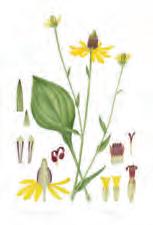
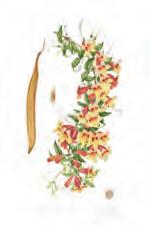
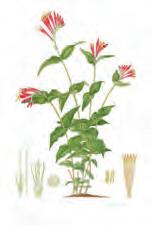
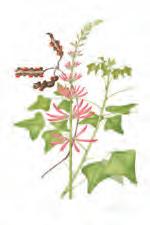
Described as a true celebration of Creole culture, Juneteenth in Opelousas pays tribute to the date in 1865 when enslaved people in Texas first heard news of their emancipation. The event is hosted by Rebecca Henry, artist and owner of the Creole Heritage Folklife Center, and will feature live music and dancing at the Opelousas Farmers Market Pavilion. Free. Noon–5 pm. (337) 945-5064. •
JUN 15th
BLACK HISTORY
JUNETEENTH FREEDOM FESTIVAL
Edgard, Louisiana
The Whitney Plantation Museum in Edgard will commemorate Juneteenth with a family-friendly experience that includes free entrance to the museum and self-guided grounds tours, a dance workshop by Avery Tate with Rhythm Nation Dance Group (10:30 am) and a seminar from keynote speaker Holley Willis (1 pm)—who will also lead a workshop titled "Trauma and Triggers" discussing the journey towards healing and reconciliation. Vendors from St. John the Baptist and other River Parishes will be on-site offering artwork, clothing, crafts, jewelry, food, and drinks. 9:30 am–3 pm. Free. whitneyplantation.org. •
Native Flora of Louisiana
Watercolor Drawings by Margaret Stones
With Botanical Descriptions by Lowell Urbatsch
LIMITED FOLIO EDITION
Praised as one of the most accomplished and celebrated botanical artists of the twentieth century, Margaret Stones established a new standard for botanical illustration during her long career. In 1975, Louisiana State University chancellor Paul W. Murrill commissioned Stones to create a series of drawings of native Louisiana plants and described the project as “a modern-day equivalent of John James Audubon’s Birds of America series.”
Treasured by gardeners, art collectors, and botanists in and out of Louisiana, this contribution to Stones’s oeuvre highlights the impressive diversity of endemic plant species in southeastern North America and on the Gulf Coast specifically. Drawn only from fresh plants gathered under the guidance of LSU professor Lowell Urbatsch, Stones’s detailed and captivating depictions remain a lasting and unprecedented study of the state’s natural beauty.
This folio edition offers, for the first time, a complete collection of Stones’s Louisiana illustrations on archival, acid-free paper with hardcover conservation binding. Paired with botanical descriptions by Urbatsch, these exceptional museum-quality reproductions of the artist’s watercolors provide intimate access to the precision and delicacy that define Stones’s mastery.
AVAILABLE AT: THE CONUNDRUM
11917 Ferdinand Street | St. Francisville, La (225) 245-5025
JUNE 24 // COUNTRYROADSMAG.COM 20
480 pages | 12" x 16" | ISBN 978-0-8071-7023-6
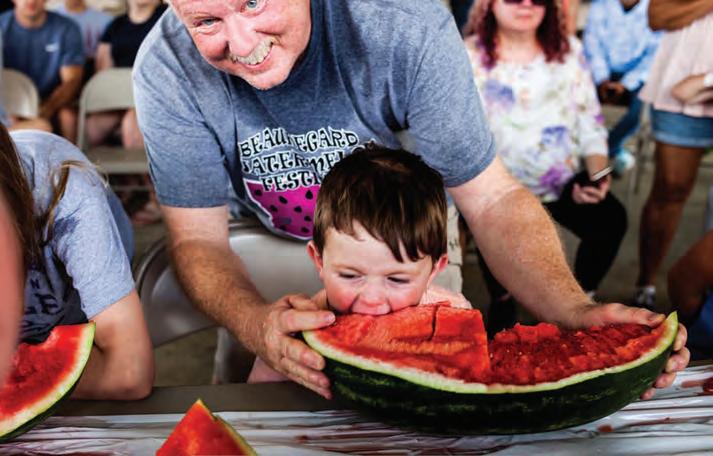
JUN 15th - JUN 16th
POPULAR ARTS
SHOWCASE COMIC CON
Slidell, Louisiana
Slidell's resident comic book and gaming shop brings back its annual convention of Americana, featuring appearances by creatives the likes of special creature performer Spencer Lee Wilding (from Rogue One, Victor Frankenstein, and Men in Black), C.J. Graham (better known as Jason in the sixth installment of Friday the 13th), and Femi Taylor Listen— known for her famous role as Jabba

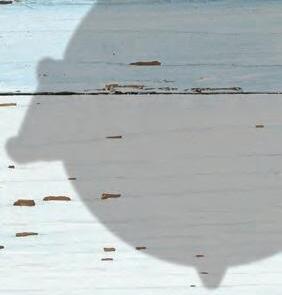
the Hutt's Twi'lek slave dancer Oola in Return of the Jedi. Plus more! 10 am–5 pm at Slidell's Harbor Center. $15. showcasecomiccon.com. •
JUN
16th - JUN 19th
BLACK HISTORY
NEW ORLEANS JUNETEENTH FESTIVAL
New Orleans, Louisiana
Celebrate emancipation in Louis Armstrong Park during the annual New Orleans Juneteenth Festival, hosted by the Louisiana Afro-Indigenous Society.
Festivities kick off on Sunday with a Freedom Gala held at the Tremé Market Branch at 6 pm. The schedule calls for live music, dancing, delicious local food, and the announcement of this year's North Star Award honorees. Tickets start at $60. The main event takes place on Juneteenth itself in historic Congo Square—and brings a full day of live music, artist vendors, children's activities, and more. 2 pm–7 pm. Free. nolajuneteenthfestival.org. 3
JUN 18th - JUN 19th
MUSIC HISTORY
LPO PRESENTS "TREMÉ FOR TREMÉ" HISTORICAL BLACK MUSIC SERIES
New Orleans, Louisiana
In a monumental Juneteenth celebration, Tremé for Tremé, The New Orleans Legacy Project and Louisiana Philharmonic Orchestra collaborate to present the Cultural and Historical Black Music Series, a two-day event honoring the legacy of Black music. The first night honors the musical talent of Free People of Color and enslaved composers of late nineteenth century New Orleans in a concert by Tremé Petit Jazz Museum’s La Programme S.T.E.M. De La Louisianne. Expect to hear classical music scores by Edmond Dédé, Charles Lucien Lambert, Basil
Barre, and more. The following evening's concert, "Music of a Movement: A Symphonic Anthology (1950s-1970s)" features New Orleans's chart-topping artist Deepa Soul and her band the Love Soul Orchestra, who will share the stage with other New Orleans vocalists and musicians. The second concert commemorates the 60th anniversary of the 1964 Civil Rights Act. Guests are encouraged to wear cocktail and/or Afrofuturistic attire. Tickets from $50 for the first night and $65 for the second night. $10 for students. lpomusic.com. 3
JUN 19th
CIVIL RIGHTS CELEBRATIONS FREEDOM SUMMER CELEBRATION AT HRAC
Hammond, Louisiana
At the Hammond Regional Arts Center, celebrate the sixtieth anniversary of Freedom Summer—the 1964 campaign to register Black Americans to vote, which became an important tenant of the Civil Rights Movement as a whole. Artist and speaker Kevin Brown will present "Freedom Summer: Arts & Advocacy," touching on art's role in civil rights and social advocacy. There will be live music by R&B artist Ameal Cameron and performances by Ponchatoula High School Step Team members. Free. hammondarts.org. •







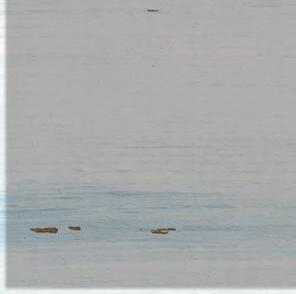

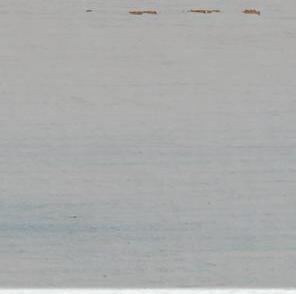





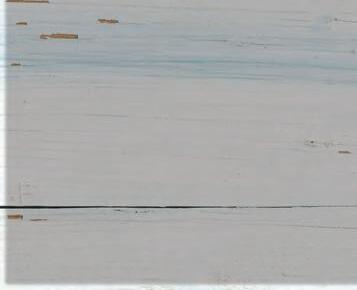
// JUNE 24 21
Delightful Discoveries at every bend RENOVATION COMPLETE Carville Hansen’s Disease Museum has reopened after a 6 month renovation. Open Tuesday-Friday 10am to 4pm. VISITIBERVILLE.COM #Waterways #CarvilleHansensDiseaseMuseum #ClubhouseBistro
June 27–29, DeRidder goes big and juicy during the Beauregard Watermelon Festival. Expect watermelon eating contests, a Melon Voice Singing Contest, seed spitting contests, and so much more. See page 24.
Events
Beginning June 20th - June 22nd
JUN 20th
GARDENING
PLANT PROPAGATION WITH CHERI FASY
Baton Rouge, Louisiana
If you've ever wanted to take a plant cutting from your mom’s yard (or your neighbor’s, or the side of the road), to see if you could get it to grow, this one's for you. The East Baton Rouge Master Gardeners' Cheri Fasy brings a program to the Jones Creek Regional Library that will describe the methods by which plants can be propagated. As she explains, fellow Master Gardeners will demonstrate the processes. Attendees will learn about different techniques, and may be able to try their hand at propagating a plant or two. 6:30 pm at 6222 Jones Creek Road. Free and open to all. ebrmg. wildapricot.org. 3
JUN 20th
LIVE MUSIC FEDERALES FEST: "OUT ON PAROLE" WITH THE HOWDIES
Baton Rouge, Louisiana
The same crew that brings Baton Rouge Federales Fest each October is already gearing up for the 2024 main event by presenting this "Out on Parole" music series, which brings live concerts to Red Stick in the leadup to the festival. This month at Baton Rouge Music Studios, catch a set by The Howdies, with the kids of the Baton Rouge Music Studios opening. 7:30 pm. $15 in advance, $20 at the door. brmusicstudios.com. •
JUN 20th
ART EXHIBIT
VINYL & VINO
Baton Rouge, Louisiana
Curator Keidrick Alford and Afrofuturist illustrator Nathaniel Landry collaborate to present Vinyl & Vino, an abstract art exhibition featuring reinterpreted vintage album covers, to be showcased for one night only at Blend Wine Bar. Landry's unique pieces, inspired by iconic album covers, offer a fresh perspective on music and visual art. Attendees will enjoy a VIP Wine Tasting during which five of Landry's artworks will be paired with selected wines by Blend owner Scott Higgins, followed by a general admission social. Limited tickets are available for the VIP Wine Tasting portion of the event for $100. 6 pm–10 pm. ellemnop.art. 3
JUN 20th - JUN 22nd
SPORTING CHANCES
LOUISIANA SPORTS HALL OF FAME INDUCTION WEEKEND
Natchitoches, Louisiana
Head to Natchitoches to watch history in the making as the 2024 class of Louisiana's most acclaimed athletes take their places in the Louisiana Sports Hall of Fame. From MMA fighter Daniel Cormier, to LSU basketball star Seimone Augustus, to the mighty Drew Brees, this year marks a particularly diverse and exciting batch of inductees. The program begins with a welcome reception Friday; continues on Saturday with events including a Bowling
the South with its Let the Good Times Roll Festival—a rousing testament to the life and freedom of the city's African American communities. Presented by Rho Omega & Friends, Inc. in downtown Shreveport's Festival Plaza, the event will bring non-stop live music, arts and crafts vendors, regional food vendors, and more. letthegoodtimesrollfestival.com. •
JUN
21st - JUN 23rd
PREHISTORIC PARTY
JURASSIC QUEST
Gonzales, Louisiana
Step back into a chapter of Earth's story that captivates the imagination with its ancient wonders and mysteries, when giant reptiles ruled the land, at Jurassic Quest, the largest dinosaur event in North America. This three-

Jurassic Quest—the largest dinosaur-themed traveling exhibition in North America— promises dinosaur fans of all ages an immersive journey through 165 million years of ancient Earth history when it lands at the Lamar-Dixon Expo Center, June 21–23.
Bash, Taste of Tailgating, and Rockin' River Fest; and concludes Sunday with a junior training camp, a lunch, and the induction ceremony itself. Find the full schedule and tickets at lasportshall.com. •
JUN 21st
BLUES LEGENDS
KENNY ACOSTA AT THE WEST BATON ROUGE MUSEUM
Port Allen, Louisiana
This month's Historical Happy Hour at the West Baton Rouge Museum features a solo performance by Louisiana blues legend Kenny Acosta. 6 pm–8 pm. Free. westbatonrougemuseum.com. •
JUN 21st
SUMMER FESTIVAL
LET THE GOOD TIMES ROLL
FESTIVAL
Shreveport, Louisiana
For almost forty years now, Shreveport has celebrated the abolition of slavery in
Culture at The Historic New Orleans Collection celebrates the richness of this life, outlining what is at stake as well as the many environmental threats coastal ecosystems—and the communities that depend on it—face. Among items on display will be a rare Audubon Birds of America folio, and an array of handcrafted duck decoys from the Stephens Family Collection. hnoc.org. •
JUN 22nd
PREHISTORIC PETS
DINO DAY AT LASM
Baton Rouge, Louisiana
Anyone who's been to the Louisiana Art and Science Museum will be familiar with Jason, the resident Triceratops. This Saturday at the museum is dedicated to Jason and all his prehistoric brethren. Kids get to explore dinosaurs and their prehistoric world through interactive activities. In addition to hands-on stations and guest presenters, kids get to discover recent additions to the Solar System Gallery, where Jason resides. In the planetarium, dig into a dinosaurthemed show. 10 am–2 pm. lasm.org. 3
JUN 22nd
FLORAL FESTIVITIES NORTHSHORE ARTS FOUNDATION: “BLOOMED”
Hammondl, Louisiana
day prehistoric extravaganza comes to Lamar-Dixon Expo Center, promising families an immersive journey through 165 million years of dinosaur history as they experience lifelike exhibits, live shows, interactive activities, and virtual resources for year-round dinosaur fun at home. New attractions include Raptor Run races and Rope-a-Raptor. Tickets available online and on-site, with options for general admission starting at $22. jurassicquest.com. •
JUN 21st - JUN 30th
COASTAL CONVERSATION "A VANISHING BOUNTY: LOUISIANA'S COASTAL ENVIRONMENT AND CULTURE"
New Orleans, Louisiana
We who live along the Gulf Coast— particularly in Louisiana—are aware that we coexist with a teeming ecosystem of birds, reptiles, and marine life. A new exhibition titled A Vanishing Bounty: Louisiana's Coastal Environment and
Attendees will get a Chopped -style competition with a floral spin at "Bloomed," the Northshore Arts Foundation's live floral design competition coming to the Hammond Regional Arts Center. See four top-notch florists onstage competing through multiple rounds until one remains to take the title of "People's Choice," which comes with a $100 cash prize. Enjoy music, food, and drinks while witnessing the artistry unfold. 6 pm. $25 per guest. hammondarts.org. •
JUN 22nd
SUDS
TWISTED BEER FEST AND HOMEBREW COMPETITION
Mandeville, Louisiana
Time to get twisted at the tenth annual Larry Hartzog Twisted Beer Fest and Homebrew Competition at Mandeville's Castine Center. Roam a Beer Garden featuring more than two hundred beer samplings, from commercial breweries to homebrewers—featuring the newest and top selling brews of the year. Attendees also get local eats, live music, and chances to weigh in on a People's Choice Award. Proceeds benefit the Northshore Humane Society, so dogs (leashed) are welcome. 4 pm–7 pm. General Admission is $40 ($50 at the door); $50
JUNE 24 // COUNTRYROADSMAG.COM 22



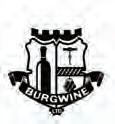












































// JUNE 24 23

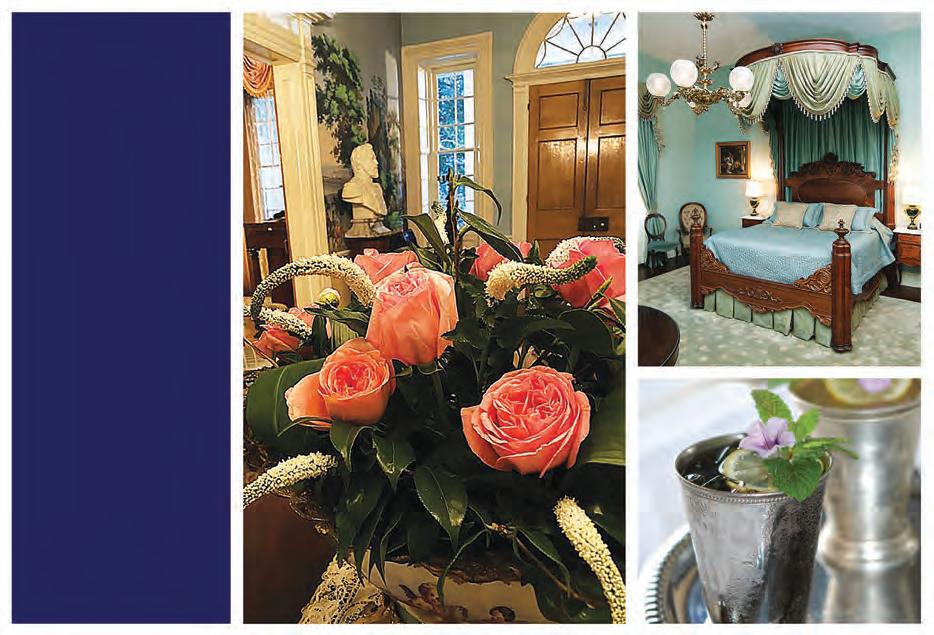





Events
Beginning June 22nd - June 30th
($60 at the door) early entry tickets allow entry at 3 pm and the opportunity to meet brewmasters in person; discounted designated driver tickets also available. Details at louisiananorthshore.com. 3
JUN
27th
ART OF MUSIC
J-S.A.N.D. AT THE ACADIANA CENTER FOR THE ARTS Lafayette, Louisiana
Acadiana's own multi-media artist
J-S.A.N.D.—known as a rising talent in music as well as for his work in graphic design and film—takes the stage for a live, interactive hip-hop performance that reaches deep. Described as a "musical TED Talk"—the event will explore, through lyricism and wordplay, issues like relationships, grief, joy, disappointment, pride, and more. 7:30 pm. $20. acadianacenterforthearts.org. •
JUN 27th - JUN 29th
SUMMER FESTIVAL
BEAUREGARD WATERMELON FESTIVAL
DeRidder, Louisiana

With six percent sugar and ninety percent water, there's no better fruit to pay homage to in June than the juicy, thirst-quenching, life-giving watermelon. DeRidder has figured out that if anything can draw out the crowds this month, it'll be the promise of salted watermelon, watermelon-infused cocktails, and more. Held at the Beauregard Parish Fairgrounds, expect one-of-a-kind events like the Melon Voice Singing Competition, an antique tractor show and parade, a truck show (awards for best lifted, best lowered, best semi, and more), a pig scramble, and watermelon craft exhibits. Plus all the predictable festival fare: music, kids stuff, food, amusement rides, etc. Starts at 5 pm Thursday; noon Friday; and 10 am Saturday. $5; free for children three and younger and for military. All the juicy details at beauregardwatermelonfestival.com. •
JUN 27th - JUN 30th
MUSIC LESSONS
SONGBIRD MUSIC SCHOOL
Saint Francisville, Louisiana
Calling all musicians, beginners all the way through seasoned professionals: BirdMan Coffeehouse is undergoing its seasonal transformation from coffeehouse to music studio for musicians looking to hone their skills, or pick up new ones. The annual Songbird Music School returns as part of Arts for All, offering the following:
June 27–28:
• Songwriting Class with Eric Schmitt and Heather Feierabend.
June 29–30:
• Guitar playing for songwriters with Clay Parker.
• Voice with Heather Feierabend.
• Ukelele with Kat Carlson.
• Cabin Orchestra for beginners with David Hinson (form a band and learn beginning guitar or bass).
• Percussion class with Melissa Wilson
• Jam Camp with Adrian Percy and Michael Holmes.
Events take place in the 3V Tourist Court cabins and BirdMan Coffeehouse.
9 am–4 pm, includes breakfast and lunch. $250 per class; $225 for seniors over sixtyfive; $450 for all weekend. Register at bontempstix.com or email Lynn for more information at birdmancoffeeshop@gmail.com. •
JUN 28th - JUN 29th
SUMMER FEAST
ST. ROSE BLUES AND BBQ FESTIVAL
Bay Saint Louis, Mississippi
Let the mouthwatering aromas of meat smoking and soulful sounds of blues music draw you to the 98th annual St. Rose Blues & BBQ Festival. Besides food and music that's so good people have been returning to this festival for nearly a century, the event gathers over thirty craft and food vendors all along the grounds of the St. Rose de Lima Church, located at 301 S Necaise Ave. (228) 467-7347. 3
JUN 29th
DANCE
MONTHLY CONTRA DANCE
Baton Rouge, Louisiana
Contra dance has been around since the American Revolution—it's similar to square dancing, with simple, fun steps performed in a line flowing in different directions so that everyone has an opportunity to dance with new partners. Each month a contra dance is held at common hall in St. Alban's Chapel on LSU's campus, accompanied by live music. Couples and singles are welcome, as partners change for each dance. Contra dance is fun opportunity to get a gentle workout, meet new friends and dance partners, and practice coordination. Newcomer orientation begins at 3:45 pm, and the dance goes from 4 pm–6:30 pm. $7, free for first-timers.
louisianacontrasandsquares.com. •
JUNE 24 // COUNTRYROADSMAG.COM 24

In a monumental Juneteenth celebration, Tremé for Tremé, The New Orleans Legacy Project and Louisiana Philharmonic Orchestra collaborate to present the Cultural and Historical Black Music Series, a two-day event honoring the legacy of Black music on June 18 & 19. See page 21. Image courtesy of LPO.
JUN 29th
FESTIVAL
SLIDELL HERITAGE FESTIVAL
Slidell, Louisiana
The 26th-annual Slidell Heritage Festival returns to Heritage Park featuring live music, food, arts and crafts, and fireworks. Gates open at 4:30 pm, with music from 5:30 pm. Stay for fireworks at 9 pm. $15 for ages thirteen and older. slidellheritagefest.org. •
JUN 29th
COMMUNITY FESTIVAL BR PRIDE FEST
Baton Rouge, Louisiana
Established to foster a sense of community among Baton Rouge's LGBTQIA+ community and its allies, Baton Rouge Pride Fest has grown to one of Louisiana's largest Pride celebrations, attracting thousands each year. The festival centers around a Community Resource Fair showcasing the Baton Rouge area's non-profits and socialservices organizations—with a special designated LGBTQIA+ marketplace called the "Queerative Market," presented in partnership with the arts initiative LEUR. Plenty of entertainment will be provided by local performers and drag queens, including A'Keria Davenport, Eureka O'Hara, and Taylor Dayne. It all takes place at the Raising Cane's River Center's Exhibition Halls, River View Room, and Galleria. Noon–7 pm. Free. brpride.org. •
JUN 30th
JULY 4-EVER STARS & STRIPES: A MUSICAL CELEBRATION
New Iberia, Louisiana
The Acadiana Symphony Orchestra and the Iberia Parish Community Concert Band join forces for this performance of patriotic music at the Sugar Cane Festival
Building. They'll honor military veterans with music selections from the World War II era, among many others. 3 pm–5 pm. Free. (337) 967-2018 or iberiacultural.org. •
JUN 30th
LIVE MUSIC
ACADIANA WIND SYMPHONY PRESENTS: UNCHARTED JOURNEY
Lafayette, Louisiana
Celebrating thirty years of professional wind and percussion performance in the region, the Acadiana Wind Symphony will present a concert at the Acadiana Center for the Arts showcasing many of its members' favorite masterworks, including Dmitri Shostakovich's "Festive Overture" and pieces by Warren Barker, Johan de Meij, and Louisiana native Frank Ticheli. The show will also feature the world premier of local composer Andrew Morgan Smith's tour de force "Uncharted Territory". 3:30 pm. $20. acadianacenterforthearts.org. 3

For our full list of June events, including those we couldn’t fit in print, point your phone camera here or visit countryroadsmag. com/events-andfestivals.

// JUNE 24 25

JUNE 24 // COUNTRYROADSMAG.COM 26

// JUNE 24 27

WONDERS OF THE WETLANDS
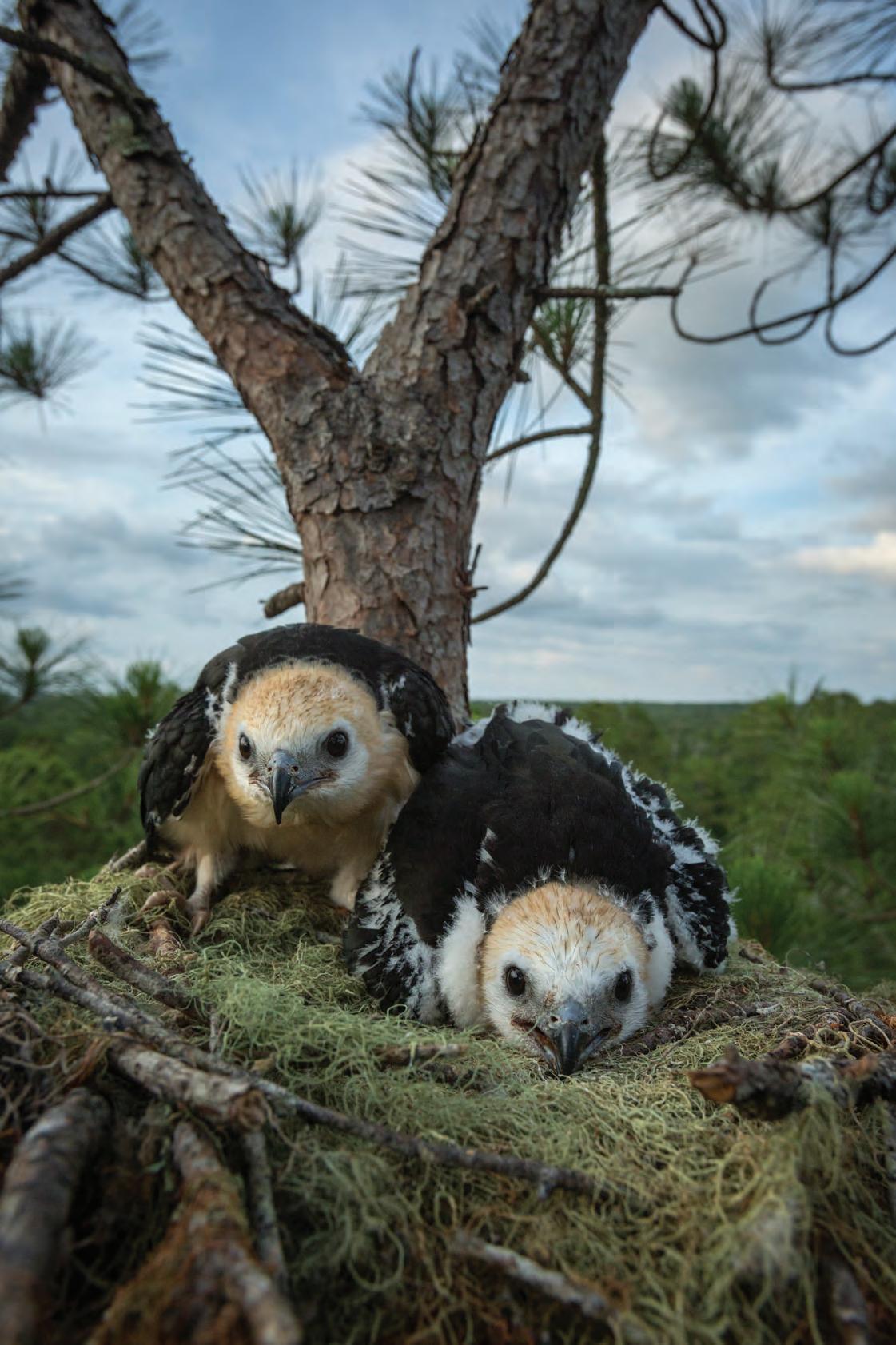
On September 12 1997, Dr. hJennifer Coulson, a scientist studying Swallow-tailed Kites for the Orleans Audubon Society, received a call that a kite had landed on a fisherman’s pogie (menhaden) boat three miles south of Morgan City in the Gulf of Mexico. The kite was severely emaciated and exhausted, barely able to lift its wings, let alone fly.
After intercepting the bird from the fisherman, Coulson spent weeks working to rebuild its strength through hydration and feedings. Once it had recovered sufficiently, she treated it for parasites with help from veterinarians. Kites, with their broad wingspans and long tail feathers, are notoriously difficult to manage in captivity. “We were at our wits end, to try to keep him from hurting himself,” she said. “He didn't break any feathers. But usually that is a problem in captivity.” Coulson noted that whenever she hears of a rehabilitator having captured a kite, she hurries to offer advice. “They are prone to breaking their long wing and tail feathers.”
Coulson, who is also a falconer, would take the kite, which she named Pogie, into an open field to exercise him. She tethered him to a long cord used in falconry called a creance. “I actually put weights on there so that it would build his flight muscles faster, because I needed to get him gone so that he wouldn't miss migration,” Coulson explained. “It was an intense rehabilitation, but he did fantastic. And when I let him go in the Honey Island Swamp, he actually took off like, straight up, and was out of sight in no time. I'm like, ‘Wow, I guess you needed to be rid of me.’ ”
Pogie’s story is only one among many remarkable experiences Coulson has had while working to conserve this rare species over the past three decades. Dramatic in appearance and lifestyle—the Swallow-tailed Kite nests in the forested wetlands of the Southeastern United States, and each year embarks on a grueling migratory journey to South America for the winter, before returning to its North American roost to breed.
The birds' imposing four-foot wingspans have given them a fearsome reputation; many people assume they are dangerous to housepets like small dogs and rabbits. But the Swallow-tailed
JUN 24 // COUNTRYROADSMAG.COM 28
SWALLOW-TAILED
BARRY GUILLOT BRINGS
BEYOND
TEXTBOOK
MUSIC
THE RIVERCANE JUNE 2024 Features
28 TALES OF THE
KITE // 32
CONSERVATION EDUCATION
THE
// 35 THE
OF
"Marian Anderson singing 'Ave Maria'" by Baton Rouge artist Malaika Favorite.
CONSERVATION
UNDERSTANDING THE SWALLOW-TAILED KITE, AND ITS ASTONISHING MIGRATORY JOURNEY
Avian Odyssey
Story by Alexandra Kennon Shahin • Photos by Mac Stone
Kite’s main diet is made up of smaller targets: insects, lizards, frogs, and small, arboreal snakes. Such misconceptions once resulted in widespread poaching—a threat compounded by extensive habitat loss spurred by the Timber Act of 1873. The treacherous nature of the kites’ annual migration across or around the Gulf of Mexico has impacted their numbers, too. This combination of factors led to a dramatic crash in the kites’ population between 1880 and 1940, particularly before the Migratory Bird Treaty Act of 1918 was passed to aid in their protection. Previously, Swallow-tailed Kites could be found nesting in twenty-one states, but by 1940, they were only present in the five Gulf Coastal states, Georgia, and South Carolina— and those populations were greatly reduced. Today, they are known to nest in eight states: Texas, Louisiana, Mississippi, Alabama, Florida, Georgia, South Carolina, and North Carolina; with an occasional nest sighted in Arkansas. Dr. Ken Meyer of the Avian Research and Conservation Institute estimates there are probably between 15,000 and 25,000 kites remaining in the wild—enough to keep them off the Endangered or Threatened Species list, though they continue to be rare and in need of conservation.
In her role as President of the Orleans Audubon Society, Coulson has led the charge in Louisiana to conserve these remarkable birds and to better understand the factors holding them back from reclaiming their former range across the country.
The birds’ distinctive appearance— they are large and stark white and black against the sky, with recognizable forked tails, lacking the fierce brow shared by most birds of prey, but with an almost dove-like face—makes the Swallow-tailed Kite a charismatic subject for conservation outreach as a whole, particularly since it focuses attention on large tracts of forested wetland, Coulson pointed out. “When we conserve Swallow-tailed Kite breeding habitat, we conserve an entire community of other plants and animals that depend on forested wetlands to survive, from Prothonotary Warblers and Ringed Map Turtles to green-fly orchids.”
A major tenet of Coulson’s work entails equipping Swallow-tailed Kites with GPS tracking devices, which help Coulson and her colleagues better understand the birds’ behavior and migratory patterns. She first started banding kites in 1993 while working for the Louisiana Nature & Science Center in New Orleans. Though Coulson requested sighting reports from the public, she only found two nests that first year—one in Pearlington, Mississippi; and another in Pearl River, Louisiana, where she banded her first two nestlings. In 1995, while teaching at Nunez Community College, she began
outfitting kites with tracking devices operated by radio telemetry, then switched to GPS-enabled tracking devices in 2011. Today, she has found and monitored 736 nests, and counting.
In 1996, Coulson joined the Board of Directors of the Orleans Audubon Society (OAS) and became President in 1999.
Since 2023, the Barataria-Terrebonne National Estuary Program (BTNEP) has funded Coulson’s and the OAS’s Kite research in the Barataria-Terrebonne Basin, along with many other conservation projects protecting wildlife and habitat in the Basin as part of its Comprehensive Conservation Management Plan. Because Swallow-tailed Kites nest in forested wetlands—one of the defining characteristics of the Estuary Program’s range—the project is of particular importance for BTNEP, which works in tandem with Audubon to protect kites as well as their habitats.
“With the Swallow-tailed Kite, it's such an iconic species, especially for the southeastern part of the United States where we find them now,” said Natalie Waters, Wildlife Conservation Coordinator for BTNEP. “It's one of those species that will literally stop you in your tracks whenever you see them. They’re such a graceful bird, they have that black and white contrast against the sky with their long, forked tail. And it's become like a flagship species for the southeastern United States.”
One of the kites Coulson is currently tracking is a bird she named “Belle River,” for its nesting location in St. Martin Parish. She first encountered the bird on July 7, 2023, after receiving a call from Rebecka and Zach Miller, residents of Bayou Pigeon, a small, unincorporated community in Iberville Parish. While out in the Atchafalaya Basin crawfishing and looking for sinker cypress, the Millers reported having discovered a roost of around a dozen kites nesting in cypress trees.
Coulson’s research depends on community members like the Millers to report sightings of the birds and their nests. Kites are often spotted soaring above forested wetland areas, or feeding on insects in flocks above a field (particularly when bush-hogging or haying are underway). Or, someone might spot a kite in the middle of the day, miles from any nesting site, hunting in a suburban backyard in the middle of a subdivision. If a kite is seen to be carrying food or nest material, Coulson requests that witnesses note the direction the bird is heading, to aid in locating the nest. Kites typically build their nests higher up than other birds of prey. The nest is usually close to the top of the tree, and constructed of lichen-covered twigs, bunch lichens, and Spanish moss. So, if you see a kite with moss in its talons, odds are likely the bird is heading to its nest, and that Coulson and her team want to hear about it. You can report sightings by calling




For more info and a full list of participating retailers please visit
//JUN 24 29
•••• 2024 •••• • • • 3-9 PM • • • TICKETS INCLUDE T-Shirt, Tote Bag, Meal Voucher and Discount Coupons for 25 local retailers ON SALE NOW! $20
visitbrookhavenms.com
or texting (504) 717-3544 or emailing jacoulson@aol.com; or by using a citizen scientist application like iNaturalist or eBird.
“We've gotten some just amazing, amazing responses from the community science outreach,” Coulson said. “Some people have become volunteers, or they become interns, or work for the project over the years through this community science component.”
After receiving the Millers’ tip,
Coulson accompanied them to the roost. Up to her knees in mud, she set up nets, then disembarked a Great Horned Owl on a tether. The owl, a rescue bird for which Coulson holds permits to use for educational programs, cannot be released back into the wild. But as a natural predator of kite chicks, it serves as an effective lure. Belle River flew from her roost to defend it against the owl, and within minutes, she had flown into Coulson’s nets. The Millers
assisted Coulson in setting nets and taking them down, and with placing a GPS-tracking device on Belle River so her movements could be monitored.
During the following several weeks, the device, which is powered by solar panels, sent Coulson and her team eight accurate GPS locations daily, plus information about Belle River’s altitude and speed. After raising two fledglings, the kite went on what Coulson chucklingly refers to as a “walkabout,”

exploring her home territory of the Barataria-Terrebonne Basin—perhaps, Coulson posits, to prepare for her migration. On July 26, things got interesting—at around 2 pm, Belle River flew around twenty-two miles south to just above the Atchafalaya River’s delta. She crossed the river and continued flying southeast into Terrebonne Parish, and from there continued due south, flying nonstop day and night across the Gulf of Mexico.
The route directly over the Gulf is the most dangerous route kites take to reach South America, since it offers nowhere to land if birds become exhausted or injured. When migrants encounter adverse weather conditions, such as a spring cold front, a kite might battle a strong headwind for days, which can result in death. Longer, but safer, paths take them over land through Texas and Mexico or Florida (also relatively dangerous, as the kites must still cross a stretch of open water). All night Belle River flew above the rolling Gulf waters, veering sharply west at 4 am the following morning on July 27. Coulson thought she may have changed her mind, and decided to head west to fly over land—but at 9 am, Belle River corrected her path, and resumed her flight south, eventually arriving in Mato Grosso do Sul in Southwestern Brazil on November 9, where she spent the winter. (The writer also prefers when a rough stretch of air travel is
Who’s Ready for Spring?




JUN 24 // COUNTRYROADSMAG.COM 30
6110 Main Street, Suite B 225-658-4070 • LaneRMC.org At Lane Pediatrics, we are here to help you and your children get the most out of spring. From wellness exams to seasonal allergies and illnesses, we’ve got your springtime wellness covered. Our team is experienced in caring for newborns, toddlers and teens. So enjoy the outdoors and trust Lane Pediatrics to keep your little ones healthy.
Photo by Jennifer Coulson
Our Services • Newborn Wellness Checks • Well-baby Exams • Developmental Screenings • Preventative Checkups • Immunizations • School & Sports Physicals • Primary Care Services • Flu Shots • On-site Laboratory Testing Springtime awakens the child in all of us! It brings longer and warmer days with more time to spend outdoors. It also brings seasonal allergies.
Dr. Heintz Dr. Tijani Dr. Sapkota
followed with a tropical vacation. Who would have thought a rare raptor could be so relatable?)
In the spring, when the time came for Belle River to return to her nest in St. Martin Parish to mate, Coulson wondered which path she would choose to navigate the Gulf. “So, it's kind of fun, we're at a crossroads there to see, what's the kite going to do? And she did the trans-Gulf route coming back,” Coulson said. “And that's what kites often want to do in the spring, because they want to get back to the breeding grounds and make sure nobody else gets their territory, you know, as soon as they can.” The stakes are high: if a kite arrives home too late, it’s possible another kite might have stolen their nest, or even their mate along with it. Coulson referenced a past instance where one kite had trouble on her return crossing the Gulf and turned back, taking a longer route through Mexico. By the time she made it back to her breeding grounds late spring, another female was on her nest, incubating eggs. “She was alarm-calling over her nest. You could see her, like, shaking in the air. She was so mad,” Coulson recalled.
Belle River’s boldness and perseverance paid off, and she again successfully crossed the Gulf from the Yucatan Peninsula to Biloxi—which took her around twenty-seven hours at roughly twenty-four miles-per-hour, totaling 636 miles.
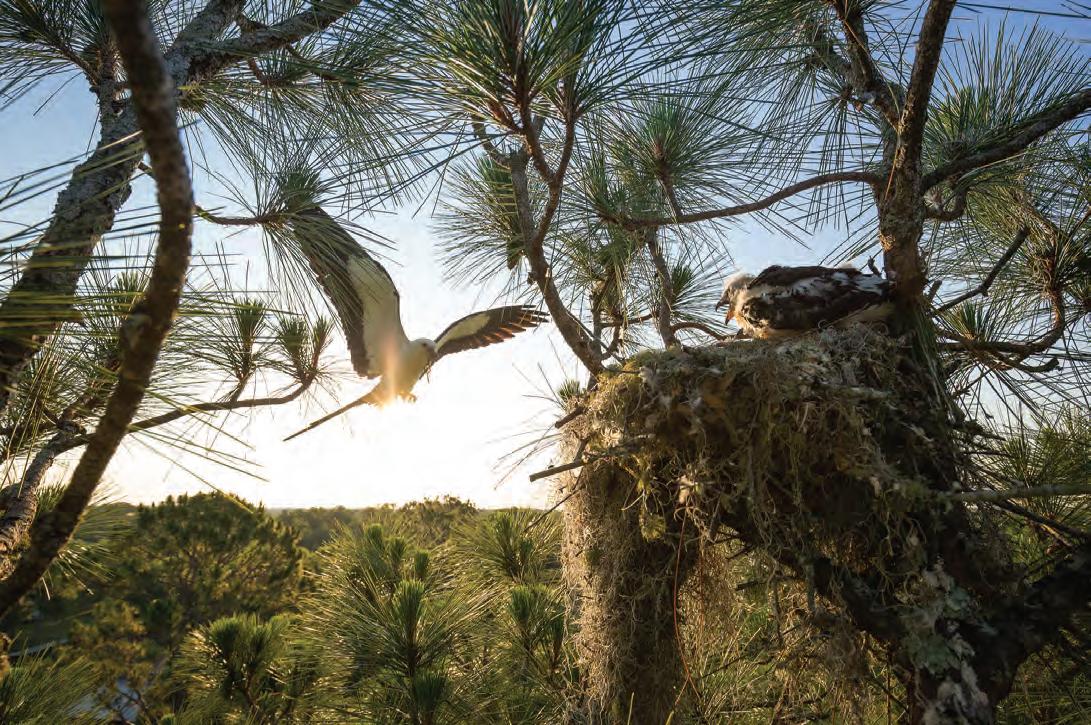
Success stories like Belle River’s offer opportunities for the public to become invested in the larger conservation efforts by Audubon and BTNEP. “By telling her story, the public gets to follow along on her journey as she migrates and cheer her on when she reaches her wintering grounds, or when she returns to a breeding grounds in the spring right here in South Louisiana,” said Waters. “And people protect what they care about.” •
Learn more about the OAS's efforts, including the Swallow-tailed Kite Project, and report kite sightings at jjaudubon.net. Keep up with Belle River and watch videos by Coulson documenting her migratory journey at youtube.com/@orleansaudubonsociety2410. You can also learn more about the Kite project and other conservation efforts supported by BTNEP at btnep.org.

//JUN 24 31
The Gator Man
BARRY
GUILLOT
HAS INTRODUCED THE WONDERS OF THE WETLANDS TO THOUSANDS OF ST. CHARLES STUDENTS
Story by Samantha E. Krieger • Photo by Alexandra Kennon Shahin

Over the course of a two-hour conversation with Barry Guillot at the St. Charles Parish East Regional Library—twenty people, including colleagues, parents, and students, gleefully interrupted us to say hello and get their bear hug. The conservationist and educator’s recent retirement from the public school system closes a thirty-year legacy of immersive, ecology-focused teaching at Hurst Middle School in St. Charles Parish, but Guillot’s impact reverberates far beyond the physical classroom. And though he’s retiring, he still has plenty of work to do.
Guillot’s connection to Louisiana’s natural world emerged early in his life. “My dad and my grandfather always loved going fishing, so we spent a lot of time out there in the big canal behind my house, go[ing] crawfishing all the time,” Guillot recalled. “We’d go down to Lafitte and watch the swamp tour boats pass.”
These adventures culminated in spectacular stories Guillot still loves telling: “Did you hear about how I got chased by an alligator? That definitely put me in love with alligators.” That Guillot is in love with alligators is an understatement: his right bicep bears a tough-looking tattoo of a snarling one. The animal's drawn lips reveal his teeth as he glares at onlookers, fist raised, flexing his own muscular bicep.
This particular tale is set in a flatboat just north of Slidell, when a pre-teen Guillot and a friend stopped to
photograph a nest of baby alligators. “All of a sudden we heard—it sounded like a dog growling—and we looked around and the marsh started parting! The only way I can describe it is like in Jurassic Park, when the velociraptors were running and started coming.” From that moment on, Guillot wanted to learn everything he could about the Louisiana alligator. He found the library’s dusty old books about the ancient creatures to be less exciting than experiencing the angry mama gator in real life. So Guillot allowed his curiosity to lead him more frequently into the wild, as well as into conversations with his elders about the way the land used to be.
He recalls his grandfather-in-law gesturing out across the fishing ponds in Bayou Gauche, asking him to imagine their past lives as cattle pastures, where he and his friends played baseball. These lost pastures are a casualty to subsidence and flooding in the area. Guillot also recalled a comical story watching his grandfather-in-law hunt pouldeau from his back porch in Terrytown. Shotgun in hand, he would wait for the birds to fly over. When they did, he would take his shot, then run through his house to the other side as they flew overhead, and catch them in front of the house, too. These stories and experiences in the fresh air did more for Guillot than the traditional desk-bound learning, as he would later learn was also true for other students.
Guillot started college in 1985 at the University of New Orleans and embarked on National Guard train-
ing. He worked as a bouncer and bartender, with an eye on entering the tourism industry—until he tried his hand at substitute teaching, where he earned the monikers ‘Kindergarten Cop’ and ‘Father Goose,’ because kids would follow him around school. The satisfaction he felt in the classroom inspired him to switch his major to education. He served for six years as a soldier in the National Guard before working his way up to army sergeant. He completed his education degree in 1991 and started working as a full-time teacher in Jefferson Parish public schools that year.
It didn’t take long for Guillot’s school administrators to recognize his immersive teaching style. “By the end of [that first] year, I had fifteen aquariums in the [class] room, and the kids would [observe animals] with clipboards [to] take quizzes and tests,” he said.
At the time, he was also working as a volunteer at the Audubon Aquarium in New Orleans, developing education programs such as “ZZZ’s in the Seas,” during which families would participate in a variety of activities and sleep overnight at the aquarium, and “Breakfast with the Fishes,” which served families breakfast in the Gulf of Mexico gallery while viewing the sharks, then took them on a behind-the-scenes tour of the facility. Curator of Education Laura Maloney and Assistant of Education Chuck Remington eventually convinced Guillot to write educational programming for the aquarium full-time. He did this for a period before
JUN 24 // COUNTRYROADSMAG.COM 32 INTO THE SWAMP
ultimately returning to the classroom, leaving Jefferson Parish for St. Charles. “It was a fantastic job where I could really think out of the box and create adventures for thousands of aquarium members,” Guillot said.
Guillot’s two most famous programs, though, were the LaBranche Wetland Watchers and Swamp School—both initiatives directed towards fostering an appreciation of and interaction with local wetlands for area youth. “How do we get the kids out of school, disconnected from technology? How do we get [them into] really hands-on stuff?” Guillot asked. “Here we are reading about wetlands, and we have this place where we can go feel it, stick our hands in the mud and be a part of it.”
Guillot started the LaBranche Wetland Watchers in 1997 after being introduced to service learning by UNO’s Dinah Maygarden and the Lake Ponchartrain Basin Foundation, where he met environmentalist Milton Cambre. “After seeing some of the things Mr. Milton was trying to do in the LaBranche Wetlands, I wanted to bring all my students out there so they could experience the lessons. I wanted them to go get their hands muddy and be able to see wildlife in real time instead of on video.” Almost thirty years later, the LaBranche Wetland Watchers continues to operate as an internationally recognized service-learning project for sixth through eighth grade students of St. Charles Parish and beyond. Guillot guides his Watchers, using the scientific method in real time, as they learn how to analyze data from their water quality monitoring in the Wetland Watchers Park in Norco, before returning to class to report their findings. He also instructs his Watchers on how to handle exotic animals that they’re studying, and gets on the ground with them to plant trees or conduct cleanups in wetland protection efforts. Every October, the group also hosts a live theater fundraiser for the park’s ongoing maintenance called the
Haunted History Hike, where guests learn about the people who called the swamps home. Guillot’s Watchers are responsible not only for regularly presenting their knowledge and research at schools, festivals, and conferences, but also for training the younger students entering the program after them.
Guillot started Swamp School in 2011 with educator Craig Howat. While there is some crossover between the LaBranche Wetland Watchers and Swamp School, the latter functions more as a summer camp. Today with the partnership of St. Charles Parish Parks and Recreation, the camp embraces students across the U.S., at one point boasting kids from seven different states. In fact, Swamp School is so popular that recently the difficulty of securing a spot was compared to snagging a Taylor Swift Era’s Tour ticket. Guillot and Howat, donning large hats, slathered-on bug spray, and sunscreen, invite kids into all the inexpensive regional recreation available in the area: fishing, crabbing, tree-planting, canoeing, net casting, archery, and hiking.
“One of the most rewarding things is to be in Walmart and to see the kids in front of me with cast nets, and they say, ‘Mr. Gator Man! Mr. Gator Man!’” said Guillot. “Sometimes the parents or grandparents will text pictures of them throwing cast nets at Grand Isle, or of their kids holding fish that they caught. We hope that they're going to teach their kids these skills [because] these were skills that we learned just from hanging out with our friends.”
Through these programs, Guillot and volunteers have devoted over 250,000 hours of service to the LaBranche Wetlands. Over 45,000 students have benefitted from the programs, and have had the opportunity to make an impact, planting over 15,000 trees and plants and collecting over 10,000 bags of trash.
In addition to his on-the-ground work in conservation and education, Guillot also reaches youth through
his 2019 book, Who Lives in Louisiana Wetlands? The story presents children with a bilingual guide for learning to count. When published, it was the only book written in both English and Niihau (pronounced NEEah-HOW), an endangered Hawaiian language and dialect. In collaborating with a Niihau charter school in Hawaii, Guillot realized that this was more than just a book: it was an opportunity to bond over shared values like family and cuisine, as well as environmental appreciation and protection.
Guillot’s countless accolades, which include being a four-time recipient of the Louisiana Wildlife Federation Conservation Educator of the Year Award, are even more impressive in light of his ongoing battle with Guillain-Barre Syndrome, a diagnosis he received in 2018. Confronting Guillot’s drop foot and paralyzed leg, doctors confirmed the rare, incurable, and sometimes fatal disorder in which the body’s immune system attacks the nervous system. It was while he was learning how to walk again post-paralysis that he got his alligator tattoo, a reminder to stay resilient and to keep fighting. “I just love how powerful and beautiful they are,” he said of his muse.
During his retirement Guillot plans to spend time visiting natural history museums, taking his family on fossil hunting trips across the U.S., and facilitating Wetland Watchers through St. Charles Parish Schools as a volunteer, as well as co-facilitating Swamp School summer camps. He’ll also continue to operate his business, Reptile Krewe LLC: Animal Encounters, through which he and his former students bring reptiles—snakes, bearded dragons, turtles, tegus, iguanas, tortoises—to events, ranging from children’s parties to weddings.
“It’s been a really, really rewarding life,” Guillot reflected. “I’m just so thankful that I’ve been in a position to… have that kind of impact on so many people.” •

//JUN 24 33

JUN 24 // COUNTRYROADSMAG.COM 34
The Music of the Rivercane
EXPLORING THE INDIGENOUS ORIGINS OF HILL COUNTRY FIFE AND DRUM MUSIC, AND THE INSTRUMENT AT ITS HEART
Story by Jeffery Darensbourg and John DePriest • Photos by Fernando Lopez

CLindsay tells a story about the origin of rivercane flutes. At one point in the distant past, a man lost his lover and, feeling dejected, went and sat by the river’s edge. The wind was blowing, and after a while, he saw a woodpecker come and peck holes in rivercane looking for bugs. As the wind blew, the cane made music, a gift from the Creator.
As members of the Choctaw (DePriest) and Atakapa-Ishak (Darensbourg) nations and scholars on Native cultures, our journey with rivercane flutes began with our love of North Mississippi Hill Country Fife and Drum music, and the realization that it certainly had an Indigenous influence.
How could it not? The fife that the performers play is made of rivercane, Arundinaria gigantea, and these flutes closely resemble those made by Gulf South Native Americans for millennia. The slinky, slithering style of dance associated with Hill Country performers even resembles the Choctaw snake
dance, with elements of the friendship dance of the Chickasaws, on whose land present day North Mississippi is located.
This music features booming marching band drums, with rhythms loud and rap id, accompanying a single flute, whose melodies are heard over it all.
Of course, the practice of making flutes out of hollow materials is common around the world and has been for a long time. The flute is one of humanity’s old est instruments. There are also fife and drum traditions in Africa, in Europe, and elsewhere in the Americas.
As for the Hill Country Fife and Drum style in particular, most origin sto ries claim it is descended from military bands that marched during the Revolu tionary War. While this claim is hard to definitively disprove, it seems unlikely that the only remnant of these martial bands almost 250 years later is in an iso lated African-American community in North Mississippi.
According to Shardé Thomas, the granddaughter of the legendary fife per former Otha Turner and present-day
leader of the Rising Stars Fife and Drum band, “the fife and drum came from Africa.” In a 2013 interview, she is quoted as saying that in Africa today, “[t]hey play it in different styles; it’s totally different than how we do it now” in Mississippi.
Many traditions associated with African Americans of the Gulf South, from food (red beans and cornbread), to forms of zydeco dancing that derive from the Native stomp dances, have Indigenous roots. These histories, after all, were intertwined. Native and African peoples were enslaved together across the Gulf South. They had families together and struggled for liberation side by side.
It seems likely that what differentiates the Hill Country style developed in place, from people who have ancestors from both Africa and local Indigenous communities, or at least influence from both. Such a mixture in American music is common. Prominent musicians of both African and Native American ancestry include classic artists such as Jimi Hendrix, Charley Patton, James Brown, Kid Ory, Howlin’ Wolf, and Fernest Arceneaux, as well as contemporary performers Cedric Watson, Radmilla Cody, Martha Redbone, and on and on. The Native American influences on both blues and rock and roll are deftly examined in the 2017 documentary Rumble: the Indians Who Rocked the World Zydeco, another southern musical form, has origins in both African American and Native American cultures of southwest Louisiana and southeast Texas. The most distinct feature of the Hill Country Fife & Drum genre however, is its instru-
mentation—and especially its flute.
The oldest known rivercane flute was found in Arkansas. Known as the Breckenridge flute, it’s likely around 1,000 years old, but Native people in the southeast have been playing flutes of various materials for much longer. Over time, rivercane flutes, like other organic materials, dry out, crack, and turn to dust, to be replenished with each new crop and each new generation.
Thanks to filmmakers Bill Ferris, David Evans, and Judy Peiser, there is documentation of Otha Turner, the master craftsman of fife and drum flutes, making an instrument from start to finish. He begins by collecting thick culms of rivercane. After sidling back to his farm at Gravel Springs, he trims the cane to prepare the flute. His measurements are exact and finely tuned from years of practice; he uses only his hands and experience to determine where the finger holes belong, and a knife to mark them for later burning. Once the holes are marked, he heats up a metal rod to clear them out, making them the proper width for playing while strengthening their edges through charring.
It’s important to note that unlike most traditional Native flutes, Turner’s flutes, or fifes, are transverse, meaning that they are played across the opening like a classical flute, rather than end-blown like a penny whistle or a recorder. For this reason, these flutes are more difficult for a novice to pick up and play. But once a sound comes out, the tone is rich and powerful.
In a typical fife and drum ensemble,
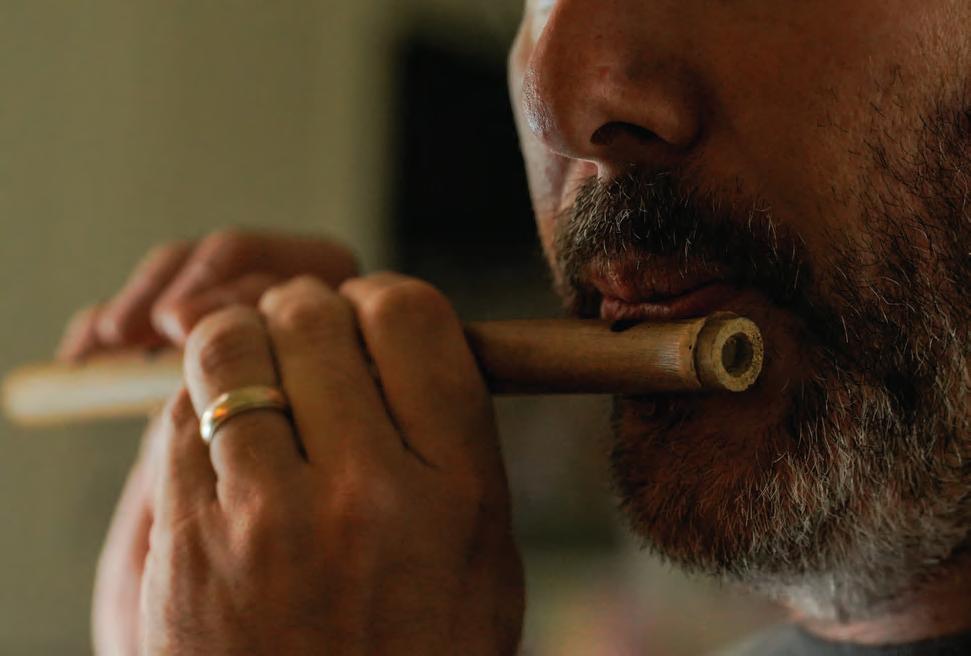
//JUN 24 35 NATURAL HISTORY
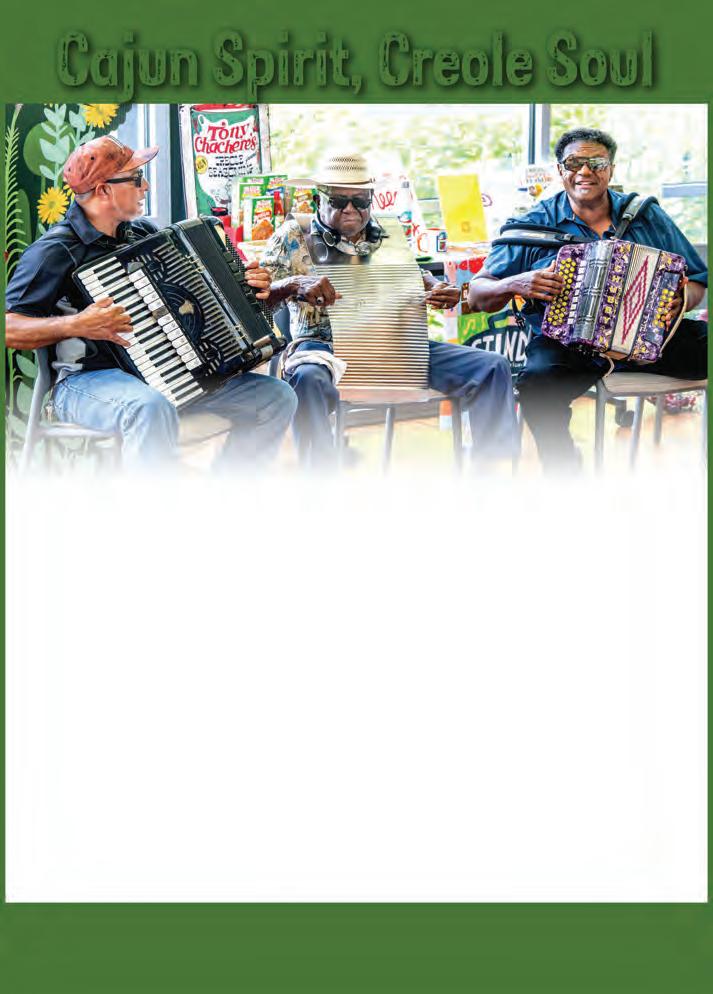
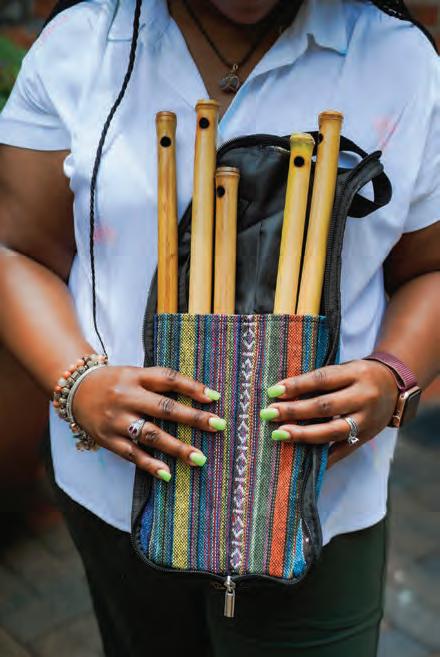





there is only one fifer and three drummers: these flutes are loud. Turner talks about hearing the music coming from Hill Country “picnics” from up to six miles away. In case your neighbors didn’t get the word that you’re having a flute party ahead of time, they’ll know when it begins. These picnics still happen, with a major one annually, the GOAT Picnic, held in honor of Otha Turner in Coldwater, Mississippi on Labor Day Weekend. Hoping to find cane to craft our own flutes in the spring of 2023, we sent a message to “Mr. Tom” Colvin, a community elder for Indigenous people of Louisiana, who has worked with the plant for decades. We wondered if he knew of any secret canebrakes up on the northshore of Lake Pontchartrain. While waiting for his reply, we drove to our own secret spot in southern Mississippi— where the cane is thinly spread on the banks of an obscure stream bed, mostly small, but interspersed with a few larger
culms big enough for a decent flute. We gathered some, listening for the warning of sinthollo, the diamond-back rattlesnake, who let us pass unhindered that day.
On the way back, we noted how odd our Native ancestors would have found it to have to travel so far to find cane. We drove an hour and a half from Bulbancha, as our Indigenous ancestors have called it, “The Place of Other Languages,” otherwise known as "New Orleans" in popular parlance. The French Quarter, where one of us lives, was once a canebrake, and on March 7, 1699, when Iberville and his crew rounded a turn in the river, becoming the first Europeans to see that place, they witnessed bison napping on the shore, and a group of Biloxi people working a controlled burn of a field of rivercane. Iberville described the scene as follows: “Both banks of the river … are so thickly covered with canes of every size… that one cannot walk through them…

JUN 24 // COUNTRYROADSMAG.COM 36
Cool Water, hot Thrills Fun for the whole family all summer long! Purchase your tickets online today libertylagoon.com
Shardé Thomas, lead vocalist and fife player for the Rising Star Fife and Drum Band, holding her set of flutes (left) and playing the flute at a live performance at the New Orleans Jazz National Historical Park (right).
Left: Rivercane next to a body of water at The Honey Island Swamp. Top right: John DePriest holding a harvested stalk of rivercane. Bottom right: Rivercane flutes and tools to make them.

when set on fire they burn readily and, when burning, make as loud a report as a pistol shot.”
Three centuries later, we can’t just stroll over to the riverwalk and harvest it. Rivercane is a leftover, volunteer domestic crop. Native Americans transformed the lands of the Americas with sophisticated land management and agricultural engineering, producing some of the world’s most noteworthy foods, including corn, tomatoes, and chocolate. Rivercane is a similarly engineered plant, adapted to human tending. According to the USDA, rivercane has lost over 98% of its historical range, largely due to grazing and erosion, but also due to another aspect of modern American life: the suppression of controlled wildfires, a principal method of tending the cane. Rivercane needs fire. Fire burns the dead culms and clears out the surrounding underbrush to help the cane spread. Suppress the fire; suppress the rivercane.
Flutes aren’t the only objects crafted from rivercane. Basket weaving is a long-standing tradition still practiced by many Native people in the Gulf South, including members of the Bayou Lacombe and Jena Choctaw communities, as well as Chitimacha artisans around Charenton and Tunica-Biloxi culture bearers in Marksville. Blow guns are still made with rivercane, too, including by Houma craftspeople, some of whom are teaching their craft to the younger generation. There is now even an annual Rivercane Gathering, a collaboration between Southeastern Native communities and the US Forest Service attempting to turn the tide of rivercane endangerment.
On the way back from Mississippi, we heard from Colvin, checked his recommended spot, and sure enough, found the cane right away, much closer to the city. Still, the point remains: rivercane is hard to find.
Searching for how to make rivercane flutes online, one will quickly
stumble across Blue Bear Flutes, founded by Cherokee flute maker Charlie Mato-Toyela. Based out of Dothan, Alabama, Mato-Toyela has been cutting or cultivating cane ever since he was a child. For much of that time, he’s also been crafting flutes—using techniques he learned from his grandfather.
Today, he has made many thousands of these flutes.
Generous with his knowledge, he dedicates a substantial amount of time to creating educational videos about the flute making process, using both wood, rivercane, and some less traditional materials, including PVC. He often sends flutes to tribal members who are interested in connecting with this cultural tradition.
“There’s a lot of things that are gonna be gone,” he said. “If you find out there’s a part of your culture that you haven’t seen in years, you really want to see it. It’s really valuable to you.” And, he added, it keeps people buying flutes, even from other flute makers. “And it helps people grow. I’ve had people tell me that when they started making flutes, it gave them some control over some aspect of their




//JUN 24 37
life, and that has made it all worth it.”
Mato-Toyela’s process is only slight ly different from Turner’s. “Most flutes are a copy of a copy of a copy”, he says, referring to using patterns and measure ments from existing flutes to make new ones. But when, as a child, he asked his grandfather about where to make the holes; his grandfather responded that they could go wherever Charlie wanted. Eventually this led to a greater sense of freedom in Mato-Toyela's flute making and a sense that he could be more cre ative with the process.
Using a heated metal dowel rod, he reams out the finger holes. The main difference between his process and Turner’s is that Mato-Toyela clears a track to direct the air. These are endblown flutes, and while generally not as loud, they have the same amount of expressive range as the Hill Country flutes.
It turns out that these two styles of flute—the Hill Country fife and the tra ditional Native flute—are quite similar. There are similar numbers of holes (most often five), and the material is the same, as is much of the process.
In the fall of 2023, we caught word that Blue Bear Flutes had stopped sell ing rivercane flutes commercially. We figured that it must be due to its declining abundance and availability. However, when we called Mato-Toyela to ask, he said “No, I still know a few spots where I can find it. The problem is that


people don’t take care of them.” He went on to explain that despite the level of care, tradition, and craftsmanship he infuses into making the rivercane flutes, people don’t seem to value them or take care of them as well as they would flutes made of other materials. “I would just be spending all of my time repairing flutes that people






didn’t properly take care of.”
The undervaluing of important Native traditions such as flute making is nothing new.
But despite a previous waning of this tradition across the Southeast, these days there are an ever-growing number of artisans and craftspeople who are building
and playing flutes—inspiring younger musicians to do the same.
Our own forays into rivercane harvesting and flute making are inspired by a mutual desire to preserve these ancient traditions for our own cultural descendants.
And we are just getting started. •

JUN 24 // COUNTRYROADSMAG.COM 38
John DePriest burning holes in a piece of rivercane to create a flute at his home in Bulbancha, or New Orleans.
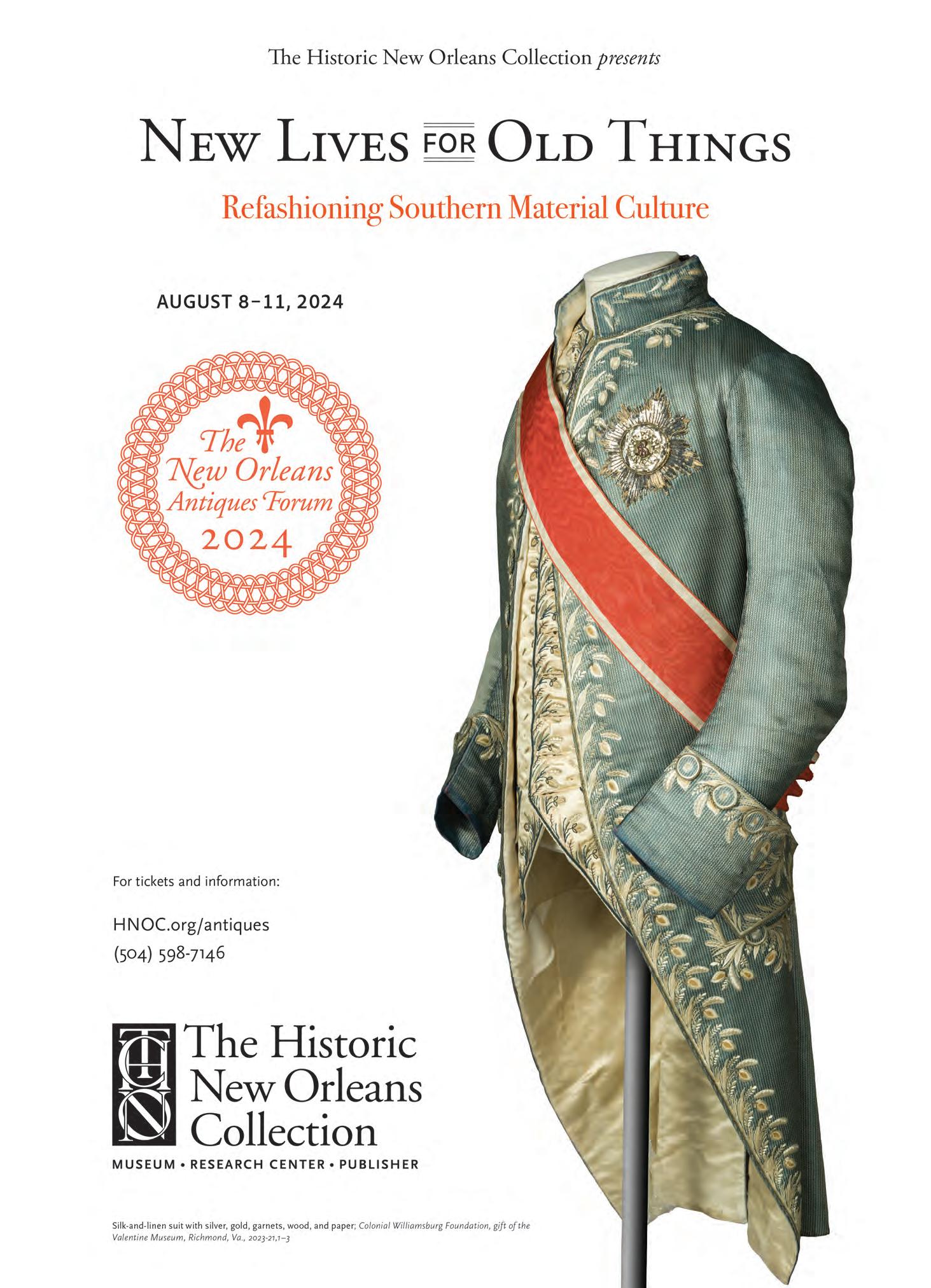
//JUN 24 39

FOODWAYS
Can't Beat 'Em, Eat 'Em
CHEF PHILIPPE PAROLA'S MISSION TO (DELICIOUSLY) INTRODUCE INVASIVE SPECIES INTO OUR DIET
Story by Mimi Greenwood Knight
If the audience recently crowding the main branch of the Baton Rouge library is any indication, the time for Chef Philippe Parola's message has hcome. “Invasive species like wild boar, nutria, and Asian carp have become a major environmental and economic issue in our state,” he told the standing-room only crowd attending his “How to Cook and Eat
For the French chef, it’s more than a gimmick. It’s a call to arms. He points out that the subtropical climate of Louisiana’s “Sportsman’s Paradise” is an ideal environment in which these species can thrive. The most harmful of them have cost the state up to $120 million each year, decimating native species in their wake.
His simple solution? “Stop the waste. Eat the problem.”
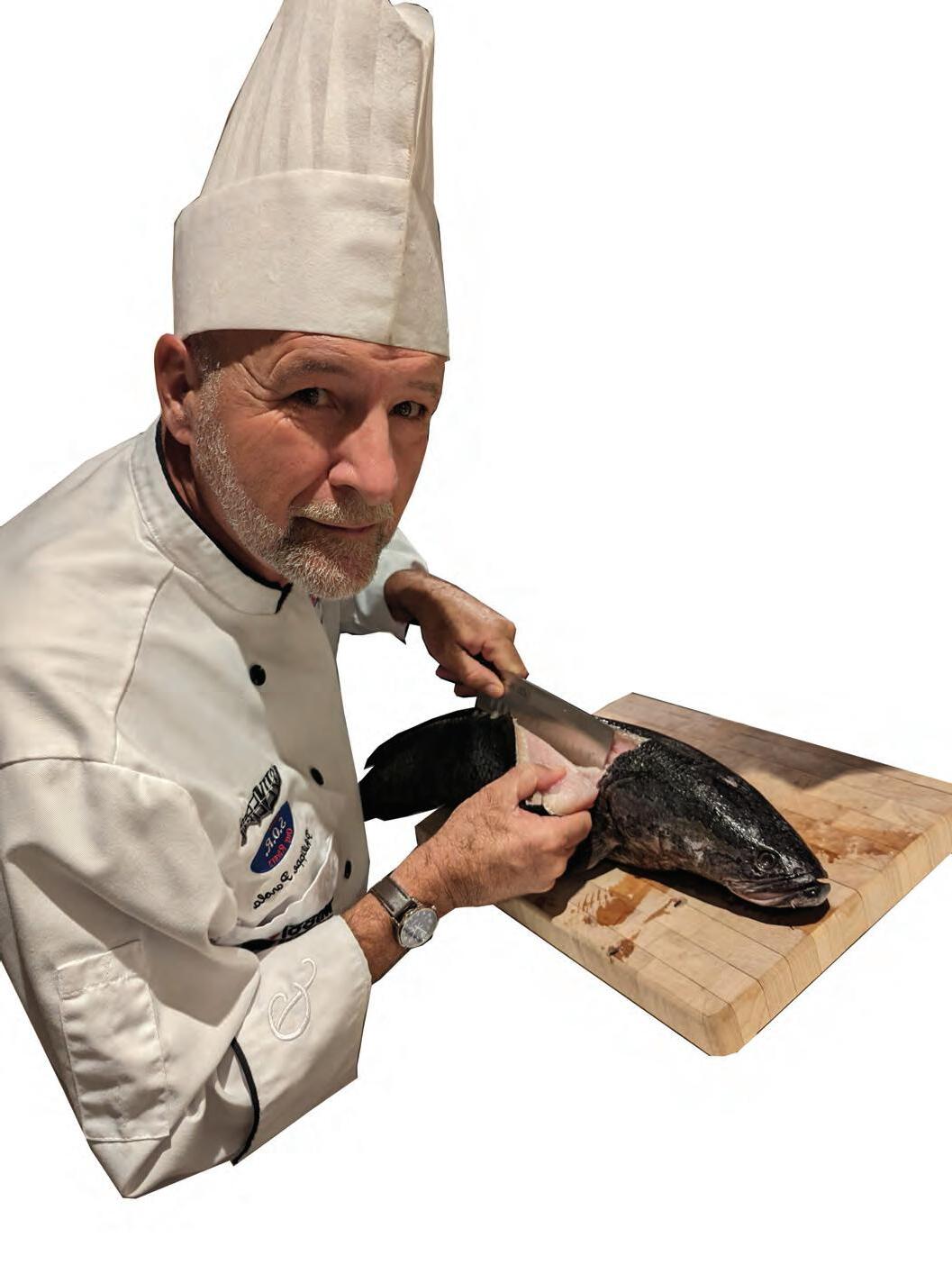
With a growing world population and a diminishing food supply, Parola argues we shouldn’t waste the often-delicious protein that exists in abundance, and at the
For the past ten years, Chef Parola has made his way around the state speaking to anyone who will listen, serving up recipes such as nutria tacos, fox squirrel ravigote, and pigeon stew. His take on jambalaya, called “invasalaya”, includes a trio of nutria hind quarters, wild boar backstrap, and Canada goose breast. And it’s not just invasive animals he’d like to see on our Louisiana plates. His books includes such recipes as dandelion salad, kudzu pie, and knotweed garlic butter.
Parola’s work with invasive species dates back to the 1980s when the Department of Wildlife and Fisheries’ efforts twenty years prior to restore the diminishing alligator population were a little too successful. There were so many gators in the waterways that they had become a nuisance. “Managing their population without a commercial market for hides meant killing animals purely for population control,” Parola said. “Yet, even when the alligator hide was used, I realized the alligator meat had gone to waste. That made me mad.”
Parola accepted a challenge from a fellow chef to create recipes that featured alligator meat as a delicacy. He did just that but struggled in those pre-Internet days to get the word out to other chefs and restaurants. Eventually though, others took up his cause and alligator rose to the stardom on Louisiana restaurant menus it enjoys today. Currently, there are reportedly over two million alligators in Louisiana native habitats and another million on managed farms. Alligator meat is a multi-million dollar business in Louisiana, Florida, and other states and alligator populations are under
control. “The same can happen with nutria, wild boar, apple snail, and Asian carp,” Parola said.
Parola’s relationship to food as a natural resource goes back even further, though—to his childhood in the French countryside during the 1960s. Orphaned at a young age and placed with a foster family on a farm, Parola grew up harvesting produce and game from the surrounding woods and waterways to bring home for the family table.
“What you have to realize is that France was still rebuilding from World War II,” he said. “We didn’t have grocery stores, just one grocery truck that came around once a week. We’d buy flour and other necessities, but the majority of what we ate, we had to hunt, fish, trap, and forage.”
Parola recalls spending many happy hours cooking with his foster mother and grandmother. At the age of fourteen he became a chef apprentice, and by seventeen he was completing gourmet internships. Drawn to the United States where there was a high-paying demand for French chefs, he made his way to New Orleans where he worked at the historic restaurant, La Louisiane.
Having worked in restaurants throughout Paris, Parola immediately took to the Crescent City’s big-city pace. Later, when he accepted a job in Baton Rouge, the state capitol felt like a little country town. He was already planning his next move, this time to Japan—where there was a French cuisine movement underway—when he discovered Louisiana fishing and hunting, and knew he wasn’t going anywhere.
What followed was over forty years of culinary success, including cooking for two U.S. presidents, owning his own restaurant and culinary school in Baton Rouge, Philippe's, working as a restaurant consultant, and making many appearances on national television and in national and international magazines. “I’ve enjoyed such a rich life in Louisiana that I feel like I owe it to the state to make a difference where I can,” Parola said.
To illustrate the impact chefs and foodways can have on the Louisiana environment, Parola turns to the historic effects of Paul Prudhomme’s blackened redfish. “The demand for redfish was suddenly so great that they were almost wiped out—with that one recipe. Now, imagine if nutria was in as big a demand.”
Nutria, he points out, is a highly undervalued protein here in Louisiana, with a taste he describes as similar to that of dark meat turkey. “They’re strictly vegetarian and because they live off the stems and roots of plants, they contain some of the highest protein of any red meat.”
Another major Louisiana invasive species is the South American apple snail, which first appeared in Louisiana waterways in 2006, believed to have been washed
EAT THE PROBLEM 40 HOW TO PREPARE APPLE SNAIL PROVEN ALE // 49 SOUPÇON: TASTY TIDBITS FOR LOUISIANA FOODIES • JUNE 2024 Cuisine
Image courtesy of Chef Parola.
Cajun-Style Black Carp
Serves 8 Ingredients
4 lbs. black carp fillets
4 tomatoes, sliced
2 onions, sliced
4 garlic cloves, chopped
1/2 cup of white wine
2 oz. lemon juice
4 oz. unsalted butter
1/4 cup parmesan cheese, grated
Steamed rice, to taste
Cajun seasoning, to taste
Instructions
Preheat oven to 325° F. Season fillets to taste, and place them in a baking pan with butter. Bake for 5 minutes, remove pan. Add white wine and lemon juice over fillets. Evenly place onion, garlic, sliced tomatoes, and parmesan cheese. Bake for 10 minutes. Serve over steamed rice.
out of home aquariums during Hurricane Katrina. Reproducing at a rapid pace, apple snails are now taking over swamps, rivers, ponds, and lakes in thirty Louisiana parishes, decimating native vegetation, and leaving nothing for native species to eat. “And when they die, their shells cover the soil at the bottom of the river, so the vegetation dies down there too,” Parola said.
But that same snail is a delicacy in many countries. His solution, which he outlines in his book as well as on popular YouTube videos, is to go out into the waterways where apple snails can be easily removed from vegetation, brought home, and cooked. His recipe, Apple Snail Provençale, includes chicken broth, tomato sauce, Italian breadcrumbs, onion, garlic, butter, and parmesan cheese. “In a couple hours, you go from the invasive apple snail to the gourmet apple snail,” Parola said.
Then there is the case of Louisiana’s out-of-control wild boar population. Parola thinks the government’s current solutions to the problem are a regrettable waste of resources. These solutions include sharpshooting the boars from government helicopters and leaving them to rot where they fall or placing poisoned cubes of Jello for the boars to eat, which also poisons other wildlife in the vicinity.
“We live in a state where thousands of hunters and trappers know how to kill and process animals,” he said. “They can be killing those delicious and nutritious wild boar and processing them into sausage and bacon. Wild boar on any restaurant menu would be a hit. We could create ongoing jobs for hunters and trappers, a new food source for local populations, improvement to local economies, and get these invasive species under control.”
In the meantime, one chef continues his crusade to get the message out. “We’ll never eradicate these species,” he said. “But we can control them so they can live in harmony with our native wildlife by turning them into food, and maybe medicine, that can be good for humanity. •
Learn more about Chef Parola and his message at cantbeatemeatem.us.
LATEST IN TASTE Soupçon
A DASH OF DINING NEWS
By CR Editorial Staff

New Desserts at Arnaud’s
When it comes to culinary and cultural legacy, there exists a precarious balance between commitment to tradition and evolving with the ever-so-quickly changing times. Over the last century, Arnaud’s in New Orleans has often leaned backwards in this regard, holding fast to its long reputation of culinary excellence and ensuring that each and every generation’s experience of the Creole institution is consistently to die for. Last year, though, a shockwave of change rippled through Arnaud's storied dining rooms when the restaurant hired on a new pastry chef, Megan Sewell—who recently, for the first time in years, preented a brand new Arnaud's pastry menu. Some of Sewell’s additions include a Semolina Orange Cake with whipped Greek yogurt and basil-olive oil syrup and a Praline Bar, made with flourless chocolate cake topped with Praline Bavarian, served with chocolate Feuilletine and apple caramel sauce. The old favorites are still there, too (there would be riots in the street if they removed the Bananas Foster), but guests can expect some fresh plating pizzazz from Chef Sewell there too. arnaudsrestaurant.com.
Hot Stuff
If there is something to be expected from New Orleans Chef Mason Hereford, it’s an unexpected take on a classic. Turkey and the Wolf’s newest restaurant sibling, which opened on May 13 on Maple Street, is reimagining the plate lunch, or the "meat-n-three," as they call it in Hereford's home state of Alabama. Opened in partnership with Nate Barfliend, Hot Stuff’s counter service, rotating menu will feature Southern cozy classics, with a twist: hamburger steaks (au poivre), green beans (with miso), and a secret fried chicken recipe described on Instagram as “potpeye’s cajun spackle, thunder dust, angel crust, trucker speed, gregarious grit,” etc. etc. Expect vintage regalia and poppy interiors, per Hereford’s signature style. And a DIY drink menu featuring liquor pours + a soda fountain. hotstuffneworleans.com.
Jim Deggy’s
Four years empty, Downtown Lafayette’s iconic space at the corner of Jefferson and Cypress—formerly home of Dat Dog—is finally open again, now as Jim Deggy’s Brick Oven Pizza & Brewery. The new pizzeria opened in early May, joining the vibrant business community of Downtown Lafayette and filling a conspicuous gap in the neighbor-
hood. Jim Deggy’s comes out of its original Pineville location, offering hand-kneaded and tossed, 96-hour fermented pizza dough adorned in various regionally-inspired combinations like the Couchon Doux, with candied bacon and prosciutto; the POP—pepperoni, boudin, and pepper jack; and the Swamp Monster, with pesto, fresh mozz, sun dried tomatoes, goat cheese, bacon, and balsamic. The restaurant will also bring a small in-house beer selection, making it Lafayette’s second working brewery, and the only one operating downtown. jimdeggys.com.
Afro Freedom Afro Feast
In honor of Juneteenth this month, Dakar NOLA’s Chef Serigne Mbaye is partnering with a slate of New Orleans’s best Black chefs to present a next-level culinary experience paying homage to the region’s African American ancestors. The menu will feature flavors from across the African diaspora, prepared by Chefs Mbaye, Charly Pierre (Fritai), Prince Lobo (Addis NOLA), Nina Compton (Compère Lapin and BABs), Martha Wiggins (Café Reconcile), Shonda Cross (Chef Shonda’s Fine Dining To-Go), and Kaitlin Guerin (Lagniappe Bakehouse). Held at Grow Dat Youth Farm in New Orleans City Park, a place historically farmed by African Americans that today hosts youth leadership and agricultural programs, the event promises to draw influence from local history, agriculture, food, nature, and community. The event will take place from 3 pm–8 pm on June 16. $200 per person. afrofreedomafrofeast. com.
The Colonel’s Club
Designed and constructed by entrepreneur and pilot Jess "Colonel" Sheppard in 1936, the iconic Baton Rouge building that has been home to the restaurants Chelsea's and Kalurah Street Grill is re-opening as Jordan Piazza's new restaurant concept, inspired by the Perkins Road Overpass neighborhood's rich history. Called The Colonel’s Club, the elevated dining spot will bear tribute to the private club from the 1960s by the same name— which was known as the hub of the area music scene. Later, a second iteration was opened in 1990 as a restaurant and bar, featuring marble allegedly left over from the State Capitol’s construction in 1932. In its latest iteration, set to open this summer, The Colonel’s club will serve a classic American menu with international influence, featuring a lounge, a full bar, and live music. Stay up to date @the.colonels.club on Instagram.
Beloved Food Trucks Making it Big
Two Louisiana food truck favorites are making their mark with new brick-and-mortar establishments, bringing their signature dishes from the window ledge to the table.
In Baton Rouge, Big Cheezy expands from its Tigerland roots with a new restaurant on West Chimes Street. Expect new menu items like fried mac n’ cheese eggrolls, and other efforts to reconceptualize the versatility of melted cheese deliciousness. Follow @bigcheezybr on Instagram.
Meanwhile, Bonafried, known for their award–winning, twice-fried chicken sandwich, has garnered a devoted following among New Orleans locals for over a decade. Owners Stephan Maher and Rebecca English Hollingsworth are now transforming their truck into a sit-down diner off Esplanade Avenue, set to open in time for Jazz Fest 2025, and poised to become a must-visit destination for those exploring the Crescent City. Follow @bonafriedtruck on Instagram.
//JUN 24 41
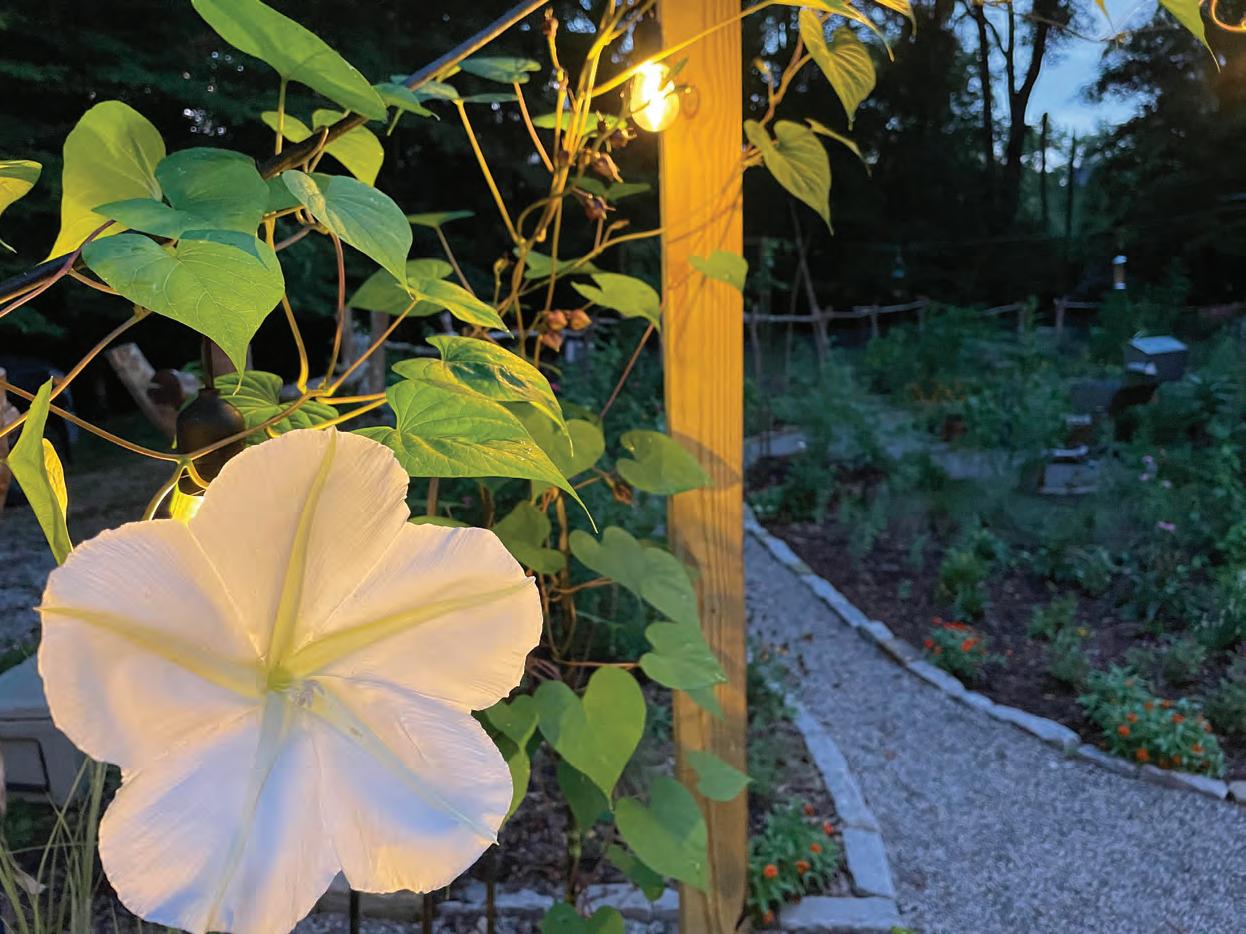

Louisiana summers come quick, and they come on strong. My little family and I look forward to these days. Though intense, they offer a certain sense of magic. During June, we are out and about in the morning and at dusk. Summer evenings in South Louisiana bring with them remarkable sensations. In this heat that causes humanity to pause, a new shift of life takes over. And it is not a quiet affair whatsoever. Our favorite summer pastime is cooking over the fire outside and sipping rosé past sunset while we listen to the cacophony of frogs and crickets. And while they burst into song, the moths, beetles, nocturnal bees and bats begin their night's work. We sit for hours to listen and watch. We grow moon vines (Ipomoea alba) on our porch and arches for the sole reason that we plan to sit
OUR SUSTAINABLE GARDEN
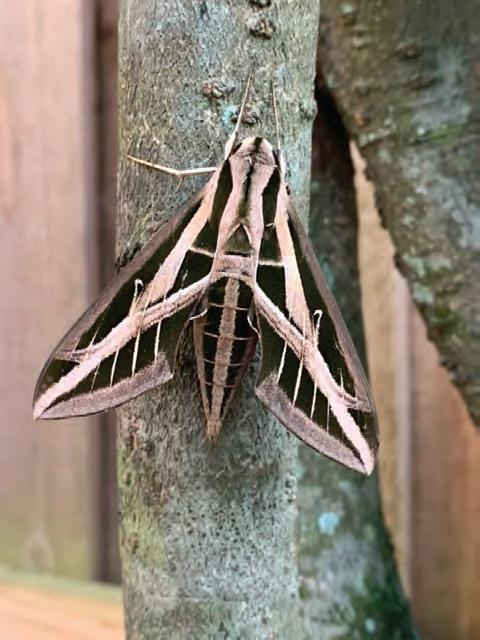
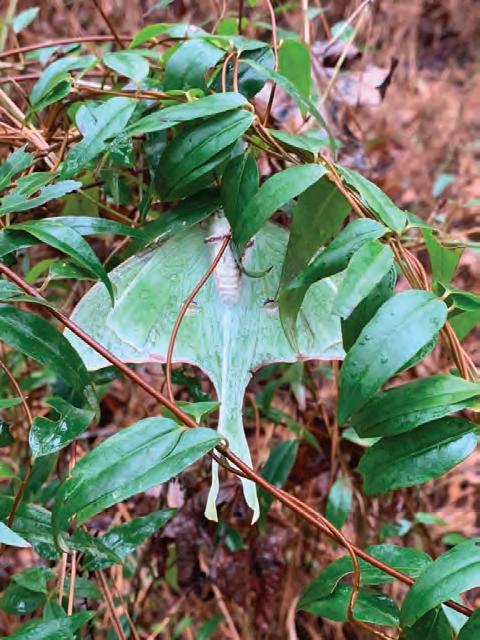
The Night Shift
beneath their display and watch the sphinx moths and bats visit each flower, doing the work they were born for. Every year I swear I will never again plant so many moon vines and each successive year I plant more than the previous.
Back in April, I encountered the oddest three minutes of my life. My family found our home and greenhouses in the actual heart of a tornado. We watched our woods drop around our frail and questionably-designed old cottage. It was the sort of thing that makes you question the happenings behind the mask of the cosmic sky. We are lucky to be alive.
Weeks later, the effect we most ponder is the loss of our forest and tree line. We bought this place for the cathedral of trees surrounding the cottage. We built our greenhouse based
on that treeline. I spent three years attempting to perfect my perennial shade garden for it to now be a fullsun garden.
At the same time, with this magnificent loss of trees comes a more visible moon and broader night sky, with excellent viewing of all astral happenings, and all of the pollinator traffic, too. Night pollinators rely on highly fragrant flowers, as well as pale/ white flowers that reflect moonlight. We can plant entire gardens that cater to these nocturnal needs. Though moonflowers are our favorite, we also plant night blooming jasmine, various gingers, bananas, angel's trumpet, Louisiana yucca, and crinum for this same purpose. There is no display, in sound nor sight, like moths and bats en masse surrounding flowers under the dark sky. Some like to call this interaction of white flowers and flutter-
ing creatures a “moon garden”. I love that name. It evokes the night dance, a nocturnal exchange happening all around, while our eyes are usually closed.
Some studies, such as those done by the Xerces Society and Butterfly Conservation, claim that as much pollination occurs at night as during the day, and with even greater efficiency after dark. Moths are masters of time and work faster than their diurnal bee comrades—visiting high quantities of flowers at a frequency perhaps unrivaled. Bats can travel farther than most other pollinators. Up until recently most research on pollination has been done solely on diurnal (active during the day) insects—resulting in an overall lack of understanding around nocturnal pollination. But with each new study, their importance is emphasized more and more.
JUN 24 // COUNTRYROADSMAG.COM 42 42 WHY YOU SHOULD PLANT A MOON GARDEN // 44 WHERE THE SALTWATER CATCH MEETS THE FRESH JUNE 2024
Outdoors
AN ODE TO THE NOCTURNAL POLLINATORS
Story by Jess Cole • Photos by Nikki Krieg
Types of Night Pollinators
Bats
Bats in particular are responsible for pollinating a lot of our foods, especially our tropical fruit and nuts. Among these are bananas, avocados, cashews, coconut, berries, and agave. Yes, you can thank bats for your margaritas!
(While on the subject of bat praise I would like to also note that they are excellent to have around your home for insect control. If you don’t want mosquitoes lingering around your porch at night, be thankful for bats and encourage their habitat when possible. A tiny bat is capable of eating over 1000 insects in one quick moonlit hour.)
Moths
Studies have also found that moths play a great role in the pollination of strawberries and stone fruit—plants not previously associated with nocturnal pollinators. Stone fruits have single hard seeds surrounded by thick soft flesh; these include: mangos, peaches, cherries, avocados, plums, and more. Even raspberries are technically tiny stone fruits. Moths pollinate more species of plants than bees and butterflies do and are able to access a lot of flowers that bees and butterflies often miss. I see them as the backup crew. When dusk falls, they continue their work. They visit my gardenias, flower tobacco, morning glories, crinums and more.
Beetles
These especially overlooked pollinators are often the first bug to interact with a new flower. One of our most diverse and large animal groups, beetles are ancient insects and were in fact our first pollinators. To this day beetles have a beautiful symbiotic relationship, and pollinate some of our most ancient plants, including our lovely native magnolias. •
June Plant Spotlight: Moon Vine (Ipomoea alba)
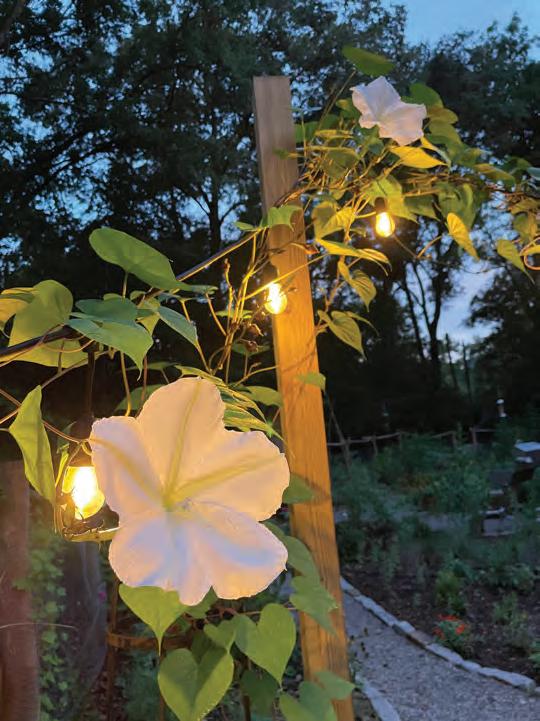

An annual tropical vine in the morning glory family, Moon Vine is a sight to behold. It is a fast grower, presenting inches in growth each day. It usually reseeds readily each year. Its giant white seeds are pretty faithful and usually sprout from the ground within days if kept well watered. I add one of these vines wherever I can! The dramatic white blooms open at dusk. Sit and watch, and before long you will see sphinx moths coming for a visit. It is absolutely one of the most joyous things about Louisiana summer, to me. The moon vine is a pollinator powerhouse and an excellent reason to stay outdoors once the brutal summer sun has fallen.

//JUN 24 43
The Cajun Grand Slam
ATTEMPTING A FISHERMAN'S FEAT ONLY POSSIBLE IN LOUISIANA
Story and photos by Andrew Green
The erosion of Louisiana’s coastline is a well-known and well-documented environmental crisis. Ample resources have been poured into slowing and reversing the negative effects of an over-engineered river. One the most effective and promising efforts thus far are diversion canals that allow fresh water to enter tidal marshes that have become saltier over the years. These diversions were not made with the kayak
angler in mind, but we certainly have benefitted from them.
During the past ten years, as I have traveled the southeast as a competitive kayak angler, no environment has captivated my imagination quite like the areas of our coast where these manmade stop-gaps have created a shallow water fishing paradise. In areas like this, it is possible to achieve the coveted Cajun Grand Slam—to catch four of our state’s most popular game fish on the same day. In early May, I endeavored to perform this feat from a little plastic boat using only a paddle and a handful of gear.

After all these years, the first few moments of any kayak fishing trip still puts my stomach into a not unpleasant knot. Anticipation, expectation, concern, and uncertainty com-

bine to form an emotional cocktail that I consider worth getting out of bed at 4 am and driving two and a half hours for. This day’s order, though, was a tall one. Local and federal efforts have created amazing habitat, but as I mentally went over the areas, techniques, timing, and miles that would be required for success—it all started to feel a bit daunting. All there was to do was paddle to the first spot and see how this played out.
The largemouth bass was the first mark—the one true freshwater species on the list. The vast majority of my time in a kayak has been spent chasing bass in various waters around the country, and I’ve always felt a special affinity for them over any other species. Less than one hundred yards from my launch site, a little drain in the marsh provided a steady outflow of fresher water into the brackish bay. A few casts later, and I was able to check Species One off the list. Not a giant specimen, but fun and scrappy nonetheless. On to the next.
The Red Drum or redfish is considered by many to be the king of the Louisiana marsh. Our coast draws angling tourists from across the nation to chase these brutes in the shallow tidal ponds of the Delta. They are known for powerful runs, aggressive strikes, and a less-than-discerning palate. In theory, these attributes should make for another layup. I was feeling
confident as I paddled into the clear, skinny backwaters where the bronze beauties are known to hang out. One effect that freshwater influx has had is an abundance of submerged or rooted vegetation in the marsh. Aquatic plants such as milfoil and coontail act as natural filters, clearing sediment from the water and increasing visibility—making sight fishing much easier. Even with the wind, I was able to quickly spot a few fish. First an alligator gar, then a bowfin, and then … a red. My first cast landed a bit too far ahead. The second, though, dropped exactly where I wanted it, and as the lure swam two feet in front of the predator’s path I braced for the bite and what would surely be a long tussle. The brace was in vain. Apparently, this particular fish was blind or not hungry. He proceeded to disappear into a clump of vegetation. The search continued for two more hours without another glimpse of the quarry. On to the next.
Now it was time for table fare. Flounder may not be the sportiest of sport fish, but they are some of the tastiest—so much so that recent regulatory changes have protected them during the fall season. A long paddle to the east with the wind at my back gave me a bit of time to rest and take in the scenery. My destination was a deep pinch point, or bottle neck, in the marsh, where tidal movement has

JUN 24 // COUNTRYROADSMAG.COM 44 GONE FISHING
dredged out an area much deeper than the surrounding flats. Flounder prefer to lay on the bottom, ambushing any tasty morsel that happens to swim above them. As I hopped a small fauxshrimp gently along them bottom in this deep area, I was rewarded with a slight tick-tick sensation. After a few turns of the reel handle, a flounder was flopping in the deck of the kayak. The little guy went about ten inches long, so instead of coming home for dinner, he went back in for a swim. Check number two. Now, it was trout time
Speckled Trout live a fairly nomadic life—they travel long distances to saltier habitats for their late spring spawning rituals, and I had feared I may be a bit late to still find a few hanging around here. Gulls and diving birds are the trout chaser’s best friend. They will often feed on shrimp and small fish in open water, and diving birds are a dead giveaway as to what is going on subsurface. After a couple of hours paddling and scanning the shorelines and grass beds, there were no birds, and no trout. The day was winding down and so were my arms. I decided to give the redfish one more shot. Three out of four wasn’t half bad! By this time, the wind had picked up, and the angle of the setting sun was making visibility in the marsh ponds more difficult. The solution to this was blind casting in likely areas— hardly the most efficient approach, but
better than giving up. Finally, with forty-five minutes of daylight remaining, one of those random casts hit the mark—two feet to the left of my kayak. A behemoth of a redfish had followed my lure to the boat without my notice and engulfed the offering at the last moment. The result was a violent pinning of the rod underneath the kayak as the red surged for deeper water. The drag system of the reel did its job of letting line out, but in my rush to get control of the sticky situation, I held my thumb to the spool for added pressure—a hasty move that promptly snapped the line, along with any chance of putting an exclamation mark on the end of the trip.
Be it on land or water, I’m a minimalist. I often find myself toeing the line between Taoist-like simplicity and unpreparedness. A quick glance over my kayak at the end of the day as it sat motionless in the calm waters of the roadside coulee “ditch” would easily confirm this. On the deck were four rods tattered from constant use, five squeaky reels that I had gotten my money’s worth out of three seasons ago, a few small boxes of lures just as tattered as the rods, but with more teeth marks. Could I have gotten four out of four with more equipment and a heavier reliance on modern equipment such as a motor? Possibly. Would it have been as much fun?
Not a chance. •

“FISHING IS A CONVERGENCE—ART AND SPORT; TECHNIQUE AND LUCK; SEEMINGLY ENDLESS STRETCHES OF BOREDOM PUNCTUATED WITH EPHEMERAL FLASHES OF HEART THUMPING-THUMPING THRILL.”
—IZAAK WALTON
Louisana’s coast is a magical place. To find out more about the work being done to protect the resource check out organizations such as Voice of the Wetlands and the Costal Conservation Association (CCA). You can follow more of my fishing exploits via my youtube channel: ‘Yakhead’.
SUMMER EXHIBITIONS


//JUN 24 45
Located in Downtown Baton Rouge, LA • Learn more at lsumoa.org ON VIEW AUGUST 22–NOVEMBER 17, 2024 Featuring over 75 artworks, tracing the evolution of American Impressionism and its unique style, encompassing precursor, contemporary, and subsequent movements in the reinterpretation of American landscape painting. This exhibition is made possible through the Bank of America Art in our Communities® program. Artwork: Childe Hassam (American,1859–1935), Old House, East Hampton, 1917. Oil on linen. Bank of America Collection. IN A NEW LIGHT American Impressionism 1870–1940 Works from the Bank of America Collection
JULY
ON VIEW
11–OCTOBER 13, 2024 Featuring art by Clementine Hunter from the collections of the LSU Museum of Art, LSU Rural Life Museum, Alexandria Museum of Art, private collectors, and the artist’s family. This exhibition is supported by the Traditional Fine Arts Organization and Taylor Porter Law Firm.
Artwork (detail): Clementine Hunter, Untitled (Baptism Scene), c. 1950. Oil on canvas. Gift of Mr. Joe Armstrong, Transfer from Special Collections, LSU Libraries.
CHERISHED
The Art of Clementine Hunter
Culture
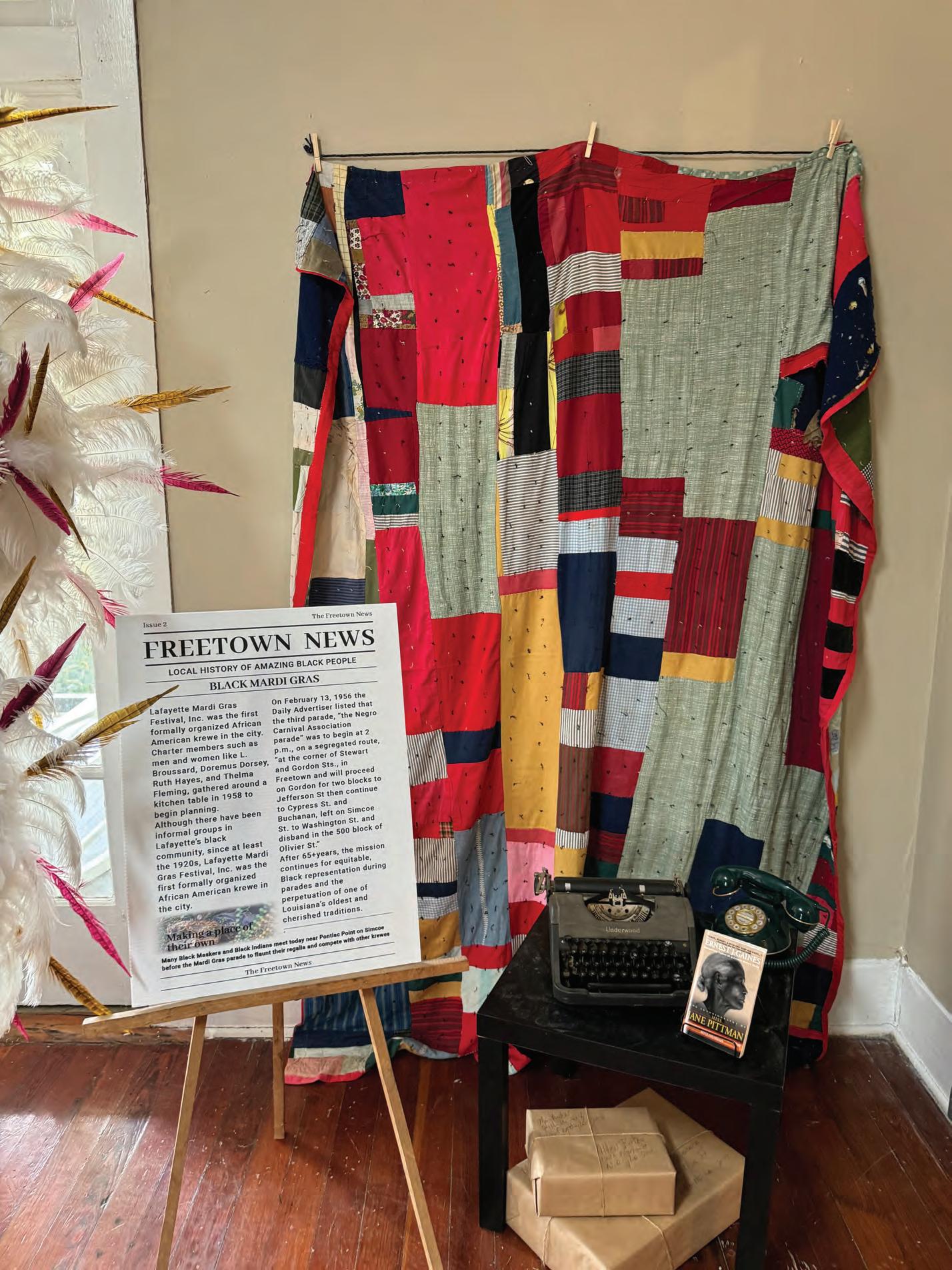
THROUGH A LOOKING
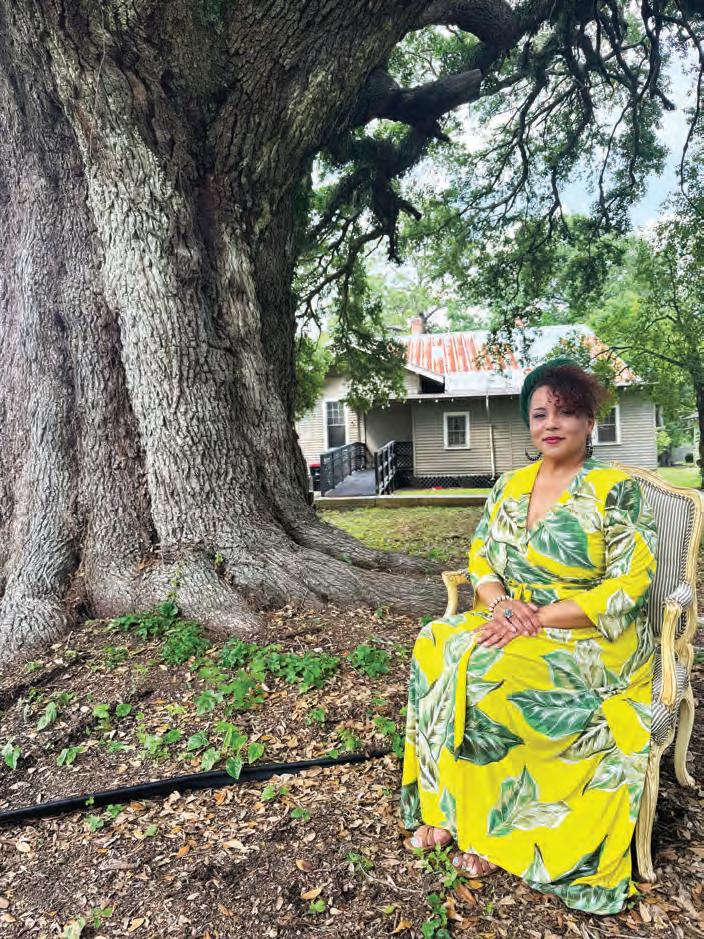
BLACK HISTORY
Maison Freetown
WHERE THE STORIES OF LAFAYETTE'S AFRICAN AMERICAN COMMUNITY WILL BE PRESERVED FOR GENERATIONS TO COME
Story and photo by Jordan LaHaye Fontenot
The property on which La Maison Creole de Freetown museum sits is shared by an oak tree that wears the magnificence of centuries. The canopy extends over the block of Lafayette’s historic Freetown neighborhood, situated on property that was once part of Louisiana Governor Alexandre Mouton’s Ile Copal sugar plantation, and just around the corner from Good Hope Hall—a Black-only gathering place and venue during the Jim Crow era, where Louis Armstrong performed dozens of times, while white audiences listened outside.
“A lot of times when I’m on the prop-
erty, I think of the many lives [the tree has] seen,” said Maison Freetown Founder and Executive Director Erica Melancon Fox in a December 2023 interview with Sara Barkouli at StoryCorps. “I just wonder about all the stories it has seen and experienced and knows, and the secrets it holds.”
Fox opened La Maison Creole de Freetown, or “Maison Freetown” as it has come to be known, in 2022 after years of promoting the idea of a cultural center/museum focused on Lafayette’s African American history to various civic entities. “It just never really landed or went anywhere,” she said in an interview in May. “People would say it’s part
of the ten-year plan, on their radar. But then ten years passed, and I’m looking around, like, ‘where is this?’”
A professional vocalist who found success on the West Coast, Fox had been inspired by the celebrations of diversity there, and the institutions in place to explore those identities and histories. “And I would come home,” a place she knew was rife with rich and complicated histories, “and just be left looking for that.”
In 2021, Fox opened a consignment shop in downtown Lafayette with a focus on cultural intersections and inclusivity, elevating the artisanship of local people of color. Called Attakapas Collective, the store’s culture was designed to replicate that of Lafayette’s past life as an Indigenous trading post called “Pinsahuk”—which brought together various tribes, as well as French, English, and Spanish traders. “As more and more people patronized the shop, I saw that people were thirsty for the knowledge beneath the surface,” she said, describing how after someone would buy a piece of jewelry, they’d stick around for thirty minutes discussing the history of Lafayette, asking about the origins of the word “Attakapas”—which refers to the Indigenous Attakapa-Ishak people who have historically called the region home. “It was just this beautiful breeding ground for conversation around topics of heritage and culture, and it kind of emboldened me to say, ‘You know what, this museum needs to happen.’” And she decided she would do it herself, if she had to.
Fox started looking around town for a larger space—envisioning somewhere she could move the Collective, and build her museum around it. Then one day, after driving down from where her shop stood on E. Vermilion, all the way to the end of the street in the heart of the historically Black Freetown neighborhood, she found the circa-1920s home beneath the oak tree, for sale.
Fox describes Freetown as a place where the history is screaming from the pavement, hoping someone will listen. “If you walk through the neighborhood, you’ll see these hints of the past, little rings on the sidewalk where they used to tie up their horses. People who have written their names in the concrete.”
Many of the people who live in Freetown today are descendants of the 120 individuals who were enslaved by Alexandre Mouton at Ile Copale. But even before the Civil War, the area was home to many of Louisiana’s first free people
of color; an 1850 census record numbers them at 149. By the time the war was over, “Freetown” was heralded as a safe haven for the formerly enslaved—who came together and built a thriving residential subdivision with specialty shops, churches, a hospital, restaurants, and recreational spaces before such organized infrastructure existed in most places in Louisiana except New Orleans. Alongside the neighborhood’s Black families lived, mostly in harmony, people of various other cultures including Cajuns, Jews, Lebanese, and Spanish residents— making Freetown one of Louisiana’s only integrated communities in the Jim Crow era.
Fox’s own family has connections to Freetown. Her mother grew up there, and it’s where her parents met. “So, I guess if there wasn’t a Freetown, I might not be here,” she laughed. She remembers hearing her grandfather tell stories about helping to build the railroad that runs through the neighborhood, and how he traveled the world even though he couldn’t read or write. In her journal from when she was seven years old, there is an entry regarding something her grandmother told her, something that sparked her interest. “She would say, ‘We’re really Moutons, but at the time you couldn’t take the name of a white man.’” Decades later, Fox would discover her own lineage’s connection to Alexandre Mouton’s family—some of whom lived in the very home where she now operates Maison Freetown.
“I believe in a higher source,” Fox told Barkouli in December. “And I feel like the ancestors, and some other source, want this work to be done. Even down to the placement of where [the museum ended up], that was not my decision. I just listen.”
Setting her cultural center and museum in Freetown gave Fox a profound opportunity to directly engage, in real time and place, with the impact that community has had, and continues to have, on the history of Lafayette and Louisiana as a whole. “We saw that there were a lot of hidden histories tied to that community, those unheard voices of people that not only worked on the plantation but then later became workers on the railroad, as well as many of the entrepreneurs and businesspeople who worked to build that community up,” said Fox. Landing where she did, she says she “couldn’t have written a better story.”
To tie an even stronger knot between the threads of the neighborhood’s past
JUN 24 // COUNTRYROADSMAG.COM 46
GLASS
Maison Freetown founder Erica Melancon Fox, pictured beneath the ancient oak tree at the museum.
and present, Fox re-established the True Friends Society—an organization originally founded as a benevolence group in Freetown in the 1880s. “They were established to help formerly enslaved people adapt to new life as free people,” explained Fox. In addition to helping fund things like burials and funerals, or raising money through fish fries and cook-offs when someone was behind on rent, the Society developed a remarkable system of thwarting violence and terrorism by organizations like the KKK. “We had a very ugly time in Lafayette, unfortunately,” said Fox. The True Friends Society would anticipate planned attacks, and gather at the homes of targeted families with farm tools and other weapons in hand. “It was because of these Friends being neighbors that people were able to sustain themselves through some of those difficult, challenging times.”
Today, Fox’s iteration of the True Friend Association, which operates as a 501(c)(3) nonprofit, holds fast to these traditions of uplifting one’s community by “continuing that legacy of just helping each other in whatever way we can” and acting as administrative “keepers” of Maison Freetown.
Inside the museum, visitors can wander through the historic home, with its rooms featuring changing exhibits such as an elaborate display of Lafayette’s Mardi Gras Indian costumes or a tribute to iconic Creole musicians, interspersed with work by local artists of color. The hallway at the home’s center acts as a dedicated gallery space, with a quarterly rotation of artworks provided by local arts collective Basin Arts through their Bare Walls Program. And one room acts as the continuation of Fox’s Attakapas Collective, a marketplace of artisan goods—from jewelry, to soap, to hot sauce—by almost thirty Louisiana makers of color.
Extending the museum’s offerings to the little building next door, Fox partnered last spring with Dr. Lindsay Gary of the Houston-based Afrikanah Book Club to open a bookstore carrying exclusively books written by Black women authors from around the globe. “Everything we do is very intentional,” said Fox. “That was something we could not do at one time—we (Black women) weren’t allowed to read, much less write, books. So we’re now elevating those voices.”
More than a museum, though, Maison Freetown has become an established gathering place in the Lafayette community, a place where artists and culture bearers have shared meals to brainstorm new initiatives, where traiteurs have presented reflections on healing, where folks come and sit on the porch to listen to local musicians jam it out, and where people come to speak the nearly-lost languages with each other at weekly French and Kouri Vini tables.
Without funding from the state or local governments as of now, Fox operates
Maison Freetown entirely from volunteer hours and donations—with some of the cost offset by the bed and breakfast hosted on the museum’s second floor. “Passion overrides any obstacles,” she said. “For the last three years, we’ve sustained within our own will and our own power. Just making it happen.”
Besides the exhibitions and community initiatives, though, the heart of Fox’s work at Maison Freetown lies in her vision for the space as a repository of Lafayette history, especially its Black history.
“Archiving is so important to what Maison Freetown is,” she said. Shortly after opening the museum in 2022, Fox was awarded funding at that year’s 24 Hour Citizen Project event to pursue her “Freetown Community Sound Lab” Project—which established a space in the museum dedicated to preserving field recordings and oral histories collected by Fox and other community members, including archeologist Sadie Whitehurst, culture bearer Kelsie LaFontaine, and journalist Ruth Foote, who grew up blocks away from Maison Freetown.
“So we’ve been going out into the community and documenting oral stories of citizens and neighbors, particularly those over eighty,” said Fox. “It’s not easy for African Americans to do research, because there’s so much missing. And we’re working hard to kind of fill in those gaps.”
So far, Fox and her partners have collected over four hundred stories—many of them through a recent partnership with KRVS and the oral history nonprofit StoryCorps, which set up a recording pop-up at Maison Freetown in November and December, 2023 as part of its Mobile Tour. An ongoing project is the creation of an interactive mobile map of Freetown, which would facilitate a virtual tour with guides to historically-significant spots. “And what we’re working on now,” said Fox, “is to embed some of these voices and the conversations we’ve had into that map, so you can hear the voices of the people as you walk through the neighborhood.”
Fox describes her role at Maison Freetown as a “reluctant curator”. In her December interview with Barkouli, Fox said that if she was living the dream she’d always envisioned “I’d be off singing, being Beyonce,” she laughed. “She’s living my life.” But she feels deeply that she’s been brought back to Freetown for a reason. “I feel it in my core that these unvoiced people, they want to be heard.” •
In honor of Juneteenth later this month, Maison Freetown will unveil a new exhibition focusing on Black history in Lafayette Parish’s school system— particularly at the circa-1896 Paul Breaux School, one of the first schools in the area opened for African American students. Learn more about Maison Freetown at maisonfreetown.org.

Great Band LIneup!
Friday, June 14, 2024
5 pm – DJ Fab 8 pm – Lil Nate and the Zydeco Big Timers
9 pm – DJ Fab Saturday, June 15, 2024
5 pm – Bunk Johnson Band
6 pm – DJ Fab 7 pm – Get Cha Sum Band








//JUN 24 47
8 pm – Kenny
8:30 pm
9 pm – Andrew Jackson 9:30 pm – Mr. Hot Topic 10 pm –
Fab CAPTIVATING HISTORY, MESMERIZING FOODWAYS, MAGICAL MEMORIES EXPERIENCE THE SOUL FOOD FESTIVAL M ystically B eautiful . c ajun c oast ! Come
community
more
see the full music
(800) 256-2931 | CajunCoast.com | #cajuncoast PAPERWHITE STATIONARY BOUTIQUE 18303 PERKINS RD E SUITE 303, BATON ROUGE BAUBLES BY BELLA BELLA 5720 CORPORATE BLVD, BATON ROUGE 680 Jefferson Highway, BR, LA 70806 • 225-924-6437 • Elizabethangallery.com
Wade Band
– DJ Fab
DJ
out June 14-15 for food, music,
&
at Parc Sur La Teche, Franklin, LA. Find out more,
lineup and get your tickets now at CajunCoast.com/SoulFood!
Than Just
ONE DAY FRAMING AVAILABLE
Elizabethan Gallery More
A Frame Shop
THE BEST GIFTS COME IN FRAMES
Preserve your favorite photos and memories with Dad.
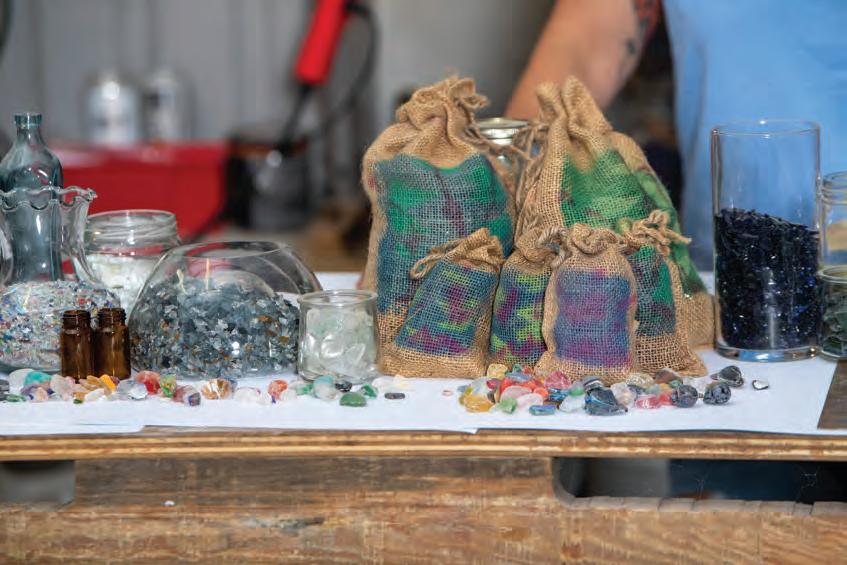

Where the Glass Goes
3 LOUISIANA ORGANIZATIONS FACILITATING NEW USES FOR RECYCLED BOTTLES
By Samantha E. Krieger
Between Mardi Gras and festival season— not to mention Louisiana’s general propen hsity for booze-fueled good times—myriad glass items find their way into our local landfills each year, contributing to the nation’s billions of bottles already calling them home. According to a recent report, Louisiana ranks at the bottom of states that recycle, with rates in the single digits, about 2-6% depending on the material. In New Orleans alone, only 2% of the city’s waste is recycled, well below the national average of 30%, according to New Orleans reporter Tristan Baurick. Often, cities refuse glass recycling because the material is heavy and breakable and can contaminate other recyclables. For these reasons, the glass recycling process is costly and labor-intensive. While some cities in Louisiana offer an opt-in curbside recycling bin program, more places have few to no resources. Alerted to this issue, organizations have assembled across the state to radically
ter-prone Louisiana. GHF’s partner ReCoast uses the material to facilitate coastal restoration projects. Gravel, on the other hand, is valuable for road beds, eco-construction, and rain gardens. In addition, through a partnership with glass artists Travis Laurendine and Andrew Barrows, GHF recycles glass to create limited edition, hand-crafted jewelry and Mardi Gras beads through the business Nola Alchemy.
Later in 2021, Trautmann founded the 501(c)(3) Glassroots, which focuses on accessibility, education, and outreach regarding Glass Half Full’s recycling operations. The nonprofit aspires to increase access to and raise awareness of the impact of glass recycling through initiatives like a community library of resources (available at the GHF warehouse), and the development of strategic partnerships with local businesses and organizations. Glassroots also presents educational programs on the environment and recycling at schools, for organizations, and through social media. In addition, the nonprofit is building an interactive map of recycling, reuse, composting, and donation sites throughout New Orleans—accessible through their website.

Glass Half Full and Glassroots
Co-Founders Franziska Trautmann and Max Steitz started Glass Half Full (GHF) in 2020 with a shared bottle of wine, contemplating its ultimate fate in a landfill. Soon they were collecting glass in their community and crushing it in their backyard.
Today, GHF operates as an L3C, or low-profit LLC, and social enterprise. From its 40,000- square-foot recycling warehouse New Orleans's Bywater neighborhood, Glass Half Full transforms donated recyclable glass into three products: powder, sand, and gravel. The absorbant qualities of powder and sand make them helpful solutions for flood control in natural disas-
Together, the organizations facilitate free glass drop-offs at the GHF warehouse (Mondays, Wednesdays, Saturdays), at New Orleans libraries, and at the Red Stick Farmers Market in Baton Rouge (on the last Saturday of the month).
“There’s a ton of opportunity for what we can do,” said Glassroots Outreach and Engagement Coordinator Mags Kassel. “Because there’s this lack of infrastructure as a recycling community, we’ve had to come up with creative solutions that are kind of double the benefit in my mind… both reducing waste in a landfill and building back our environment.”
Volunteers operate the glass drop-off sites, fill sandbags for coastal restoration, assist in clean-up projects, and install rain gardens. They also help to manage the monthly community events Glassroots holds that include trivia nights, documentary screenings at the University of New Orleans, and recycling bin enclosure announcement parties with music and yard games. “The goal is to keep on having more events [so] that people are just able to have fun with the glass recycling process and able to see the joy in the work,” Kassel said. glasshalffull.co ; weareglassroots.org.
Glass Act Recycling
In the 1970s, founder Annie Collins’s parents reared her with an early focus on sustainability, and it felt natural for her to carry this way of life to Alexandria where other like-minded community members were rallying to recycle. She started Glass Act Recycling, a 501(c)(3), with a single-bottle crusher at small pop-up parties in 2021. That same year, her organization was selected as the Montessori Educational Center’s project of the year, which gave Collins the opportunity to educate students about the importance of recycling.
Since then, Glass Act has grown into a full-fledged recycling center where glass is collected, crushed, and repurposed in-house. Volunteers sort glass, maintain the facilities, and assist in pick-up and drop-off services. Though Alexandria residents are invited to drop off their glass for free at the recycling center on Fridays and Saturdays, Glass Act also operates a paid yellow bin glass pick-up initiative currently serving the Alexandria area. Collins is hopeful that she and her team will soon service neighboring communities such as Pineville, too. True to its origins at the Montessori school, Glass Act draws in area students with service hour opportunities. Collins said that her team currently works with student volunteers from every high school in Rapides Parish. “It’s their generation,” she said. “We do it for them."
Glass Act has also cultivated a beneficial partnership with Ewing Pools & Spa, one of the largest pool suppliers in the region. The company has committed to use Glass Act’s sand in 100% of its swimming pool filtration systems. Recycled glass filtration has been proven to be more effective than traditional silica sand, and lasts two to three times longer.
Additionally, sandblasting companies have partnered with Glass Act to use the organization’s OSHA-approved product—which, in addition to being more effective, is a safer alternative for workers, alleviating the damage crystalline silica can cause to the lungs. “Glass has been heated and melted. When it’s crushed down, the particles are rounder on edge, so you breathe it in, you cough it up, and it’s an annoyance, not a hazard,” explained Collins.
Glass Act also sells glass to artists to use in their studios. “We keep the blue because it’s just gorgeous, and I don’t want to see us waste that beautiful glass.”
Going forward, Collins is focusing on reducing Glass Act’s carbon footprint to zero with the development of a new, more efficient glass crusher. She also dreams of someday adding a glass art studio in the recycling center. But right now, she is feeling grateful for how far Glass Act has come. “The greatest reward, without fail, is working on the center and the volunteers and the people who come for the first time.”
glassactrecycling.com.
JUN 24 // COUNTRYROADSMAG.COM 48 RECYCLING
Volunteers pictured at the Glass Half Full warehouse. Photo by Zachary Kanzler.
Recycled glass at BackYard Sapphire. Photo by Thomas Benoit.
Glass recycled into sand at Glass Act Recycling. Photo by Elliott Racca.

BackYard Sapphire
Partners and Co-Founders Tina Crapsi and Dawn Vin cent—now President and PR Chief, respectively—start ed BackYard Sapphire as an LLC in 2021 when they saw an unmet need in Lafayette. After the local government stopped recycling glass in 2017, the couple’s hoarded bottles were piling up. Recently, BackYard Sapphire achieved 501(c)(3) status.
Originally a metal worker, fabricator, and blacksmith by trade, Crapsi built her own glass crusher with a gum bo pot, which she monikered “The Annihilator” for its capacity to crush nine wine bottles in seconds. Three years later, through a partnership with Bottle Crusher US, Crapsi and Vincent purchased Louisiana’s largest glass-crushing machine, the AFS Maxi glass bottle crusher. “It can crush twenty tons in eight hours… it could crush our two existing machines!” Crapsi said.

Besides ties with organizations like Keep Louisiana Beautiful, Love The Boot, and the Bayou Vermilion Preservation Association, BackYard Sapphire also partners with Lafayette Consolidated Government’s “Build Your Own Sandbags” program and facilitates paid glass drop-off stations on Tuesdays and Saturdays at Fightingville Fresh Farmers Market. “My goal is to recycle all the glass for Lafayette,” Crapsi said. “I just kind of want to go and fill the potholes with our sand.”
“Life is set up so that it’s very challenging to really just live a sustainable life: even if you go out of your way, the cards are stacked against you,” Crapsi went on. For example, she explained, if liquor stores accepted customers’ empty bottles and shipped them back to the factory for refill, BackYard Sapphire would have that much less glass to crush, recycle, and repurpose.
One way to draw more people into the mission of glass recycling, Crapsi and Vincent have found, is by capi-
talizing on people’s interest in specialty items. “Being environmentally conscious is not trendy yet, but being unique and having unique things is very trendy,” Vincent said. In addition to creating sand and mulch for landscaping projects, Backyard Sapphire also promotes use of its products in potted plants and fishbowls, as well as in art products like coasters, snifters, cork keychains, and lapel pins. backyardsapphire.com. •
You can support these organizations via community participation, donations, and volunteering. Each offers its own version of glass pick-up services for both residential and commercial customers for a fee. Some even offer other mixed recycling pick-up services to include cardboard, paper, aluminum, and specific plastics. See each organization’s website for more






//JUN 24 49
[
Glass Act Recycling Center (left) and donated bottles to be recycled at Glass Act Recycling (right). Photos by Elliott Racca.


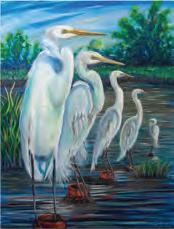





What I Think Will Happen When I Speak Louisiana French Perfectly
HOW I USED LANGUAGE TO BREAK THE CRAWFISH CURSE
By Megan Broussard
“Pardon, monsieur, you said 'crevette,' but did you mean 'chevrette' ?” I ask sheepishly so as not to embarrass my Louisiana French teacher.
The room goes silent.
“What did you say?”
His body is still facing the blackboard, chalk mid-air.
“I—I wondered…if um…you meant—”
“Say it!”
“'Chevrette' is the Louisiana French word for 'shrimp.' Not 'crevette' ! 'Crevette' is 'shrimp' in Standard French!!!”
I slap my hands over my mouth as if overtaken by some invisible force. He whirls around—lip snarled, jaw clenched, eyes burning. I brace myself for his cruelty.
Instead, he slow-claps.
“At last, T-grasshopper!,” he says. “Chevrette vs. Crevette was your final test. You have proven yourself ready for your mission!”
“Who, moi ? Non, non , you must have the wrong fille. I’m just an average Joe! Err, Joséphine, I mean”.
Then, a golden fiddle drops from the ceiling. I pick it up and somehow have the power to play all of Lost Bayou Ramblers’ entire discography. My classmates cheer and hoist me up in the air. My teacher ushers me to the front of the room, handing me a gilded bow.
“This will come in handy later,” he says. “But first, follow me.”

He tugs a tattered copy of A Cajun Night Before Christmas from his bookshelf, revealing a secret room. In it, more ancient Louisiana texts: the Marquis’s diaries, the first map of the Territory of Orleans, and the original blueberry cheesecake recipe from Don’s Seafood in Lafayette.
“How shocked are you?,” he asks. Scale of un to dix ?”
“Wow, yeah,” I say. “Not like beaucoup shocked because I always had this weird affinity for National Treasure, plus a psychic in the French Quarter once told me I had ‘a gift’ but then again she said that to everyone else in the bachelorette party so–”
“Arrêt! We don’t have much time.”
I snap to attention. He unfolds a charred roll of papyrus covered in olde-man cursive.
“Megan Elizabeth Broussard,” he reads. “Your impeccable pronunciation and unmatched comprehension of the Louisiana French language has awoken the ancestors from their slumber, and they need your help. Follow the clues into the depths of the bayou to unlock a hidden chest that, once opened, will release La Louisiane from its curse. If you fail, our people will never again see crawfish below $15 per pound.”
JUN 24 // COUNTRYROADSMAG.COM 50 SATIRE
I shudder.
“Do you accept this mission?”
“Yes! I mean, oui .”
I make a note to email him later, explaining that I totally meant to say “oui” first, but just got thrown off when he asked me the question in English.
I’m shaken from my thoughts when a hot bayou version of Austin Butler enters.
“Meet your guide!” my teacher says. “Austain Butte-LeFleur, born and raised by a family of egrets. He’ll take you where you need to go. The rest is up to you!”
We jump in hot Austain’s hot skiff and set out on the dark, murky water until we reach a ghostly cypress. Austain flashes a light inside its hallowed trunk. There, scratched into its bark, is a riddle:
Ma tête est rouge.
Ma bouche est ivoire.
Call on me, you!
Le tchoc perdu!
(Asteur monsieur.)
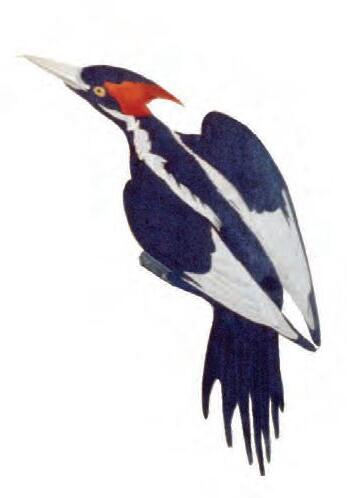
“Any idea what this means?” Austain asks.
“I love you,” I blurt.
“Huh?”
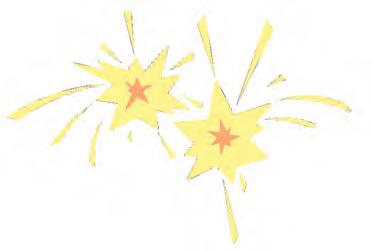
“Sorry, uh, it says you need to call a lost bird? One with a red head and an ivory mouth? It’s gibberish, it doesn’t make any sen–”
“The Ivory-Billed Woodpecker!” Austain exclaims. “It is lost. Well, it’s supposedly extinct. The last confirmed sighting was in 2005.”
Austain lets out a woodpecker rap.
I swoon. He turns to me and mouths: “I love you, too.”
Our amour is interrupted by an Ivory-Billed Woodpecker in the sky. He raises a wing and beckons us to follow. We pull up to an embankment, unsure where to go next. Until the woodpecker poops.
“That’s the spot!” Austain shouts. “Dig!”
“Ew, um…” I start.
Just then, a congregation of albino cocodries surrounds us.
“What do we do now?” I yell, hoping Austain will say 'To hell with these gators, let’s elope to Cabo! ' Instead, he yells, “Listen to the woodpecker!”
The woodpecker calls out something familiar, something ethereal, a melody that sounds like…a Lost Bayou Ramblers banger.
“It’s the ‘Côte Claire Waltz’ ,” I exclaim. “He wants me to play the Côte Claire Waltz !”
I whip out my fiddle and begin to play, until finally the super pale alligators go do-do. We tip-toe onto land.
Austain and I survive several more perilous traps: flesh-eating ghost-pirates, shapeshifting beasts, and my ex-bestie from high school’s MLM pitch. All of it only strengthens my bond with Austain.
And, then. There it is! I can hardly believe it! The flip flop I lost on Kappa Delta Bus Trip ‘08! —Oh, and the cursed chest we’ve been looking to unlock this entire time! We’ve done it! I crack it open.
The curse is lifted. Peace is restored, Ivory-Billed Woodpeckers come out of hiding, and Louisiana families never again have to convince themselves that boiled chevrettes are just as good—if not better than—boiled crawfish.
The state gives me prize money and honors Austain and me with a parade. Upon learning his favorite throws are plastic cups, instead of the obviously-superior jester hats, I realize we are too different to sustain a relationship in the real world. We agree to keep the sexual tension going, just in case they make a movie franchise about us, you know, for publicity purposes.
I buy myself a cozy little mansion on Avery Island and wait by the phone. The secret service in France and Quebec are sure to call next. •





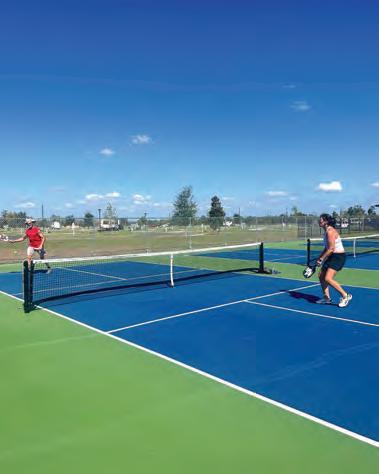

//JUN 24 51
Ivory-Billed Woodpecker art from John James Audubon's "The Birds of America: Plate LXVI," 1829.
Escapes
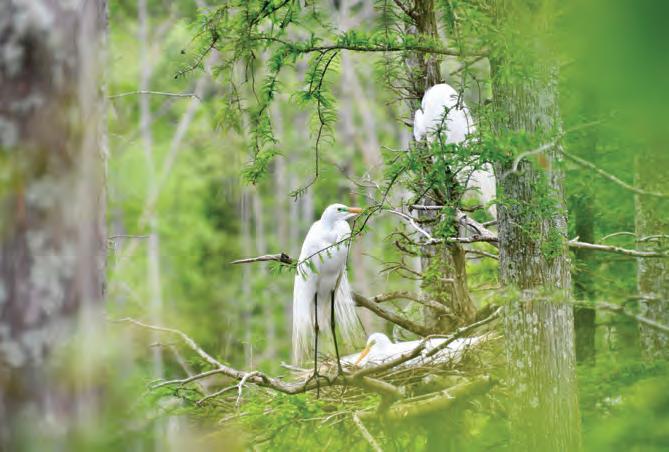
INTO THE FOREST
Escape to Evangeline
HIKE, KAYAK, AND CAMP YOUR WAY ACROSS THE CAJUN PRAIRIE
Story by Kristy Christiansen • Photos by Paul Christiansen
Beneath the mid-morning sun on the first day of spring break, we piled the family into the car and headed out of the city to Louisiana’s coun tryside, passing through Lafayette and steering northwest to Evange line Parish. Named for Longfellow’s famous heroine, Evangeline is a land of crawfish ponds, rice fields, and wide-open pastures. It’s a haven for hunt ing and fishing, a veritable resort for nesting egrets and Roseate Spoonbills, and within its borders lie some of the state’s largest and most scenic parks.
Early French and Spanish settlers used this prairie land for grazing cattle, and while there are significantly more homes on the horizon now, it’s not hard to pic ture the scene that greeted these European homesteaders. The parish seat, Ville Platte, sits west of I-49 and is famous for its smoked meats and Swamp Pop mu sic. Meaning “flat town,” Ville Platte is the point where the land levels off below the hillier landscape to the north.

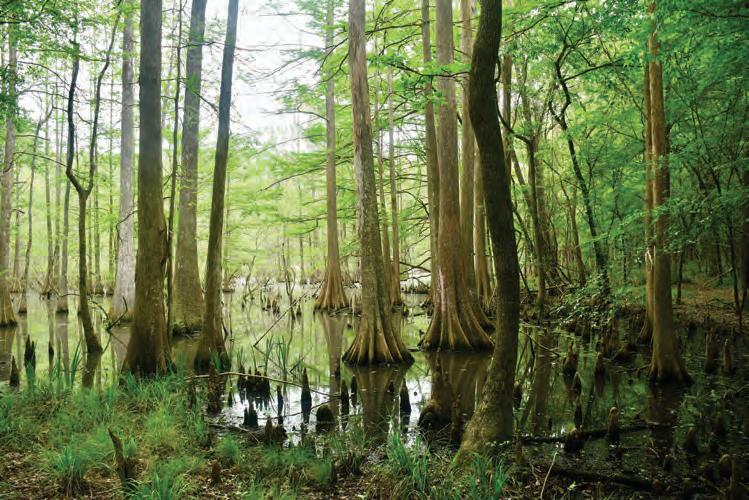
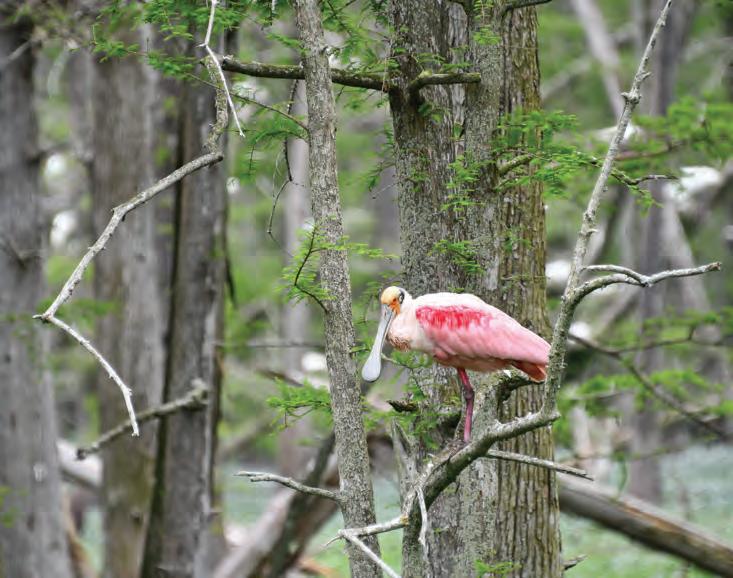

Chicot State Park
We spent two blissful days exploring this area, starting with the 6,400-acre Chicot State Park. The park’s centerpiece is man-made Lake Chicot, with its picture-perfect cypress and tupelo trees rising above the dark, still waters. Long and skinny, the stocked lake nurtures record-breaking Largemouth Bass, crappie, and Bluegill, and on any given day, fishermen gently rock in their boats waiting patiently to catch the big one. Our boys set up camp on the North Landing’s fishing pier and tried out new lures while lizards scurried around searching for patches of sunlight on the railings.
We then drove the scenic road along the lake’s western edge to the South Landing, passing cyclists on their way back to the campground and children investigating the kids’ hiking trail, illuminated by strings of lights in the trees. We stopped to view the stilted cabins hovering over the water before circling back to the park’s main hiking trail, a twenty-mile loop that rings the entire lake and is a favorite of mountain bikers. On our particular Monday, though, we were the only visitors in sight. Grabbing our water bottles, we plunged into the bottomland hardwood forest that hugs the banks of the lake. Our dog, overjoyed to be in the woods, set a vigorous pace, and we jogged along to keep up, rewarded every so often with glimpses of the glistening lake.
JUN 24 // COUNTRYROADSMAG.COM 52 WILD TIMES 52 3 NATURAL HAVENS AT THE HEART OF THE CAJUN PRAIRIE // 54 WHERE TO FIND CHIPMUNKS IN LOUISIANA • JUNE 2024
In addition to the North and South Landings, the state park has a less developed East Landing. All three sections offer a boat launch and dock, and boats can be rented at the South Landing. For those who take to the water, the park offers an eight-mile canoe trail. With nearly 200 campsites, fifteen cabins, and two lodges, it’s also one of the best places to stay overnight in Evangeline Parish.
Another option, which is the route we took, is to find a friend with a camp in the area. On the way to the camp, we pulled in to Teet’s Food Store in Ville Platte and browsed their extensive smoked meats section before picking up several for dinner.
Louisiana State Arboretum
The next morning, we splurged on sweet treats from Mikey’s Donut King before returning to Chicot State Park, this time taking the spur road to the Louisiana State Arboretum. Dating back to 1961, the Arboretum was the first of its kind established in the South. From the parking lot, we crossed a bridge leading to the Visitor’s Center, a small nature center tucked into the woods and surrounded by native plantings. After viewing the interactive exhibits, we picked up a trail map and headed into the forest. Caterpillars and red-tailed skinks were abundant, as were snakes sunning themselves on logs.
At more than 600 acres, the Arboretum encompasses varied landscapes along its five trails, and you can find nearly every type of Louisiana native tree and plant. The Bald Cypress Trail led us to boardwalks along the edge of Chicot Lake, while the PawPaw Loop Trail wound its way up a hill through an area ripe with pawpaw trees. Along the Walker Branch Trail, another boardwalk carried us across a swamp where croaking frogs serenaded our journey. Along each trail, signs identified the area’s vegetation, from the red-and-white Christmas lichen to sycamores, maples, beeches, and more. At the far end of the Arboretum stood the Caroline Dorman lodge, named in honor of the naturalist who first suggested the idea of an Arboretum. Many of the original plantings here came from Dorman’s home, Briarwood, in northern Louisiana. A second, free entrance to the Arboretum stands right beside the Caroline Dorman Lodge.
PJF Farm & Lodge
We left the Arboretum right after lunch to make our tour time at PJF Farm. Although the entrance is a twenty-minute drive away, PJF Farm is actually adjacent to Chicot State Park and only separated by railroad tracks. Family-owned and operated, the land is home to rice crops and crawfish farms and is a conservation and recreation area with four lakes and the second largest rookery in the state. Access to the property is by membership or day-pass, and the site offers several options for experiences—including hunting and fishing memberships, kayaking tours, and annual and day-passes for photography. You can also experience PJF by staying overnight in one of the on-site cabins or the lodge.
Upon arrival for our scheduled tour, we were greeted by owner Anita Fontenot.
Fontenot’s father, Percy, acquired the property that she runs today with her son and daughter. The family told us the story of how Percy grew up poor but was a great entrepreneur. He started off selling flying squirrels and frogs as a teenager and later ran a chicken hatchery and general merchandise store with his wife. Along the way, Percy transitioned into banking and finance, and in 1960, he began owner financing small parcels of land from the sheriff of Evangeline Parish until he’d eventually amassed around 4,000 acres.
Fontenot’s son, Doug Frugé II, manages the 1,600 acres dominated by rice fields and crawfish farms. He drove us around the property, explaining how once the rice is harvested, the fields will be flooded in order to bring the crawfish in..
“Rice and crawfish are big staples,” explained Fontenot. “They sustain us enough to pour back into conservation. We then restore the land, and people come from all over the country and world to visit. We’d like to make this a destination.”
Fontenot has big plans for the future, including remodeling the Visitor’s Center, adding equestrian activities, and developing more trails. But for now, one of the biggest tourist draws is the bird rookery. “As a young girl, I’d ride back here with my dad and see the birds,” said Fontenot. “My dad would say, ‘These birds are going to be big someday.’” Today, photographers travel from all over to visit the site, which has thousands of nesting wading bird species, including Great Blue Herons, Great Egrets, Great Cormorants, Anhingas, and Roseate Spoonbills.
When Frugé stopped the truck to let us view the rookery, we were amazed by the noise and activity throughout the cypress trees. The entire area was a flurry of white plumage as egrets busily built their nests. Pockets of pink revealed Roseate Spoonbills clamoring for space, while giant alligators waited silently in the water, watching the activity above.
“It’s a paradise in disguise, where you can rest, retreat, and restore,” said Fontenot. “It’s a place of solitude, where you can come enjoy the outdoors.”
Her words seemed to sum up not only PJF Farms, but Chicot State Park and the Arboretum, too. The three highlight all that is special about Evangeline Parish, which we found to be a recreational oasis hidden in the center of the state. •
evangelineparishtourism.org.











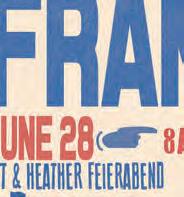




















Premiere - Sunday, June 16 at 8PM
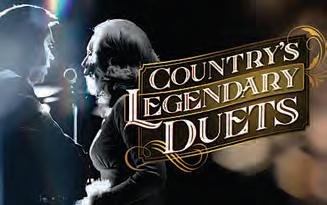

Monday, June 17 at 8PM Saturday, June 1 at 7PM

//JUN 24 53
| CONTACT LYNN WOOD ARTSFORALLSTFRANCISVILLE@GMAIL.COM JULY 8-12 YOUNG SONGBIRDS www.lpb.org Season
www.lpb.org/livestream


INTO THE FOREST
A Little Gem
IN THE FELICIANAS, A HIDDEN NATURE PRESERVE IS HOME TO RARE SPECIES



Over twenty years ago, I first laid eyes on St. Francisville when our college hrecreation group traveled through the area to reach the waterfalls at the hClark Creek Natural Area. Since then, my family and I have explored nearly every inch of the picturesque town, from its historic homes and much-missed button shop, to the record-setting bald cypress trees that stand sentinel in Cat Island National Wildlife Refuge. So, when my youngest boy’s Cub Scout troop announced the next campout would take place at Mary Ann Brown Preserve in St. Francisville, I was floored. Was it possible there was a place in St. Francisville I’d never even heard of before?
It’s a point of pride that I’ve made it through three boys in Cub Scouts and never once attended a Cub Scout camping trip, or as I like to call them, “dad-supervised Lord of the Flies.” But I was curious about this Feliciana nature preserve. So, as soon as the boys returned, I planned a family trip to check out the little-known property.
Owned and maintained by the Nature Conservancy, the land that is now Mary Ann Brown Preserve was donated by Baton Rouge businessman L. Heidel Brown and his wife in memory of their daughter. Similar in topography to the nearby Tunica Hills area, the Preserve features nearly two and a half miles of hiking trails through 110 acres of hardwood forest, the kind that once covered the hills of the Felicianas. Visitors have been greeted by white-tailed deer, rabbits, beavers, and even ambling box turtles. This is also the only region in the state where you can see chipmunks.
“It’s a little gem,” said Will deGravelles, Director of Land Protection and Stewardship for the Nature Conservancy in Louisiana. “We acquired it in the mid-nineties, so we’ve had it for a long time, but it’s a little bit off the beaten path and still not well known.”
Down the road from Audubon State Historic Site, where famed artist John James Audubon worked as a tutor while painting his birds, the Preserve’s parking lot is readily accessible but easy to overlook. Once inside the fence, though, the well-maintained trail guided us deep into the trees, across a leaf-blanketed floor underneath a canopy of pine, mature beech, and Southern magnolias.
DeGravelles explained that the land here was formed by loess, wind-blown silt that was mostly deposited on the east side of the Mississippi River in previous ice ages. The silt originated from rock ground up by massive glaciers, which was flushed into the Mississippi River’s floodplain when the glaciers receded during warming periods. Over the course of hundreds of years, the loess soils were picked up and deposited, forming what we now know as the Tunica Hills. A small stream on the property cuts through the sandy soil, its path carving a deep ravine with steep sides cradling the water below. The loop trail crisscrosses the stream several times, providing interesting shifts in the moderate walk.
“My favorite part is that it’s always a little different in every season—the views, aesthetics, wildlife, birds,” said deGravelles. “I encourage people to go experience it in
JUN 24 // COUNTRYROADSMAG.COM 54
Story by Kristy Christiansen • Photos by Paul Christiansen

each season. Some of our other preserves are that way too, but it’s truer here than at any other.”
The Nature Conservancy protects twenty-one properties in Louisiana. All but five are closed to the public due to sensitive species and natural communities, or to accessibility issues at remote locations. Fortunately, Mary Ann Brown Preserve is open every day of the year during daylight hours.
“The Nature Conservancy is regularly offered land donations that we can’t take,” said deGravelles, detailing how the organization must carefully select its conservation priorities due to the intensive demands of land management. The Nature Conservancy also acquires land, which it then sells, donates, or transfers to other agencies to manage. An example is the Bluebonnet Swamp, which is today overseen by the Recreation and Park Commission for the Parish of East Baton Rouge (BREC). In Mary Ann Brown’s case, though, the Nature Conservancy not only accepted the land donation but also decided to keep it under its own management.
“Mary Ann Brown is partly valuable because of its location near Baton Rouge, which has so few nature preserves of that type,” said deGravelles. He explained how the area is a Southern Mesophytic Forest, a habitat where plants grow on rich, ‘mesic’ soils, or medium conditions of moisture. “The land is not particularly rare, but it’s valuable in terms of wildlife and the forest in those loess hills. And it does have a couple of rare species, such as the Carpenter’s groundcherry.” Calliphysalis carpenter, or Carpenter’s groundcherry, is a perennial plant in the nightshade family named for Louisiana naturalist William Marbury Carpenter.
Unfortunately, we missed both the Carpenter’s groundcherry and the elusive chipmunks on our visit, but we did see blooming wild roses and an abundance of birds flitting through the trees. The trail’s end brought us to a pavilion with bathrooms and a scenic pond, complete with a pond house. It was the perfect spot to prepare an afternoon picnic while the boys took to the pond to see what lurked beneath its waters. •
DeGravelles noted that any groups involving children, such as boy scouts, churches, or school groups, are welcome to reserve the campsite by calling 225-338-1040 or emailing lafo@tnc.org.
Camping is free with a refundable deposit.
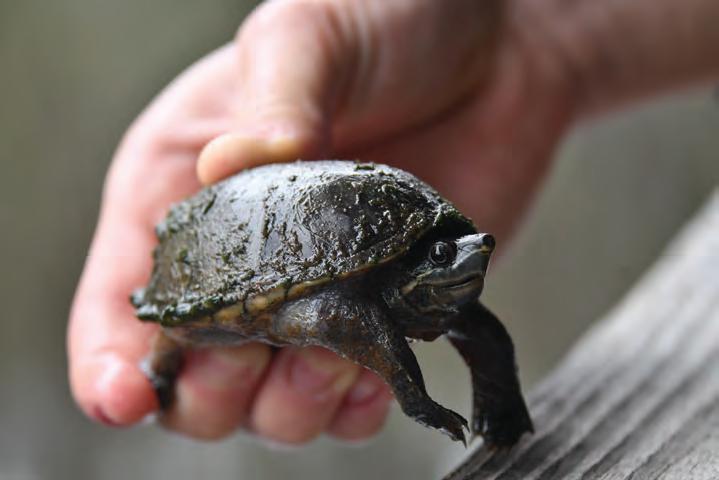


//JUN 24 55
SPECIES
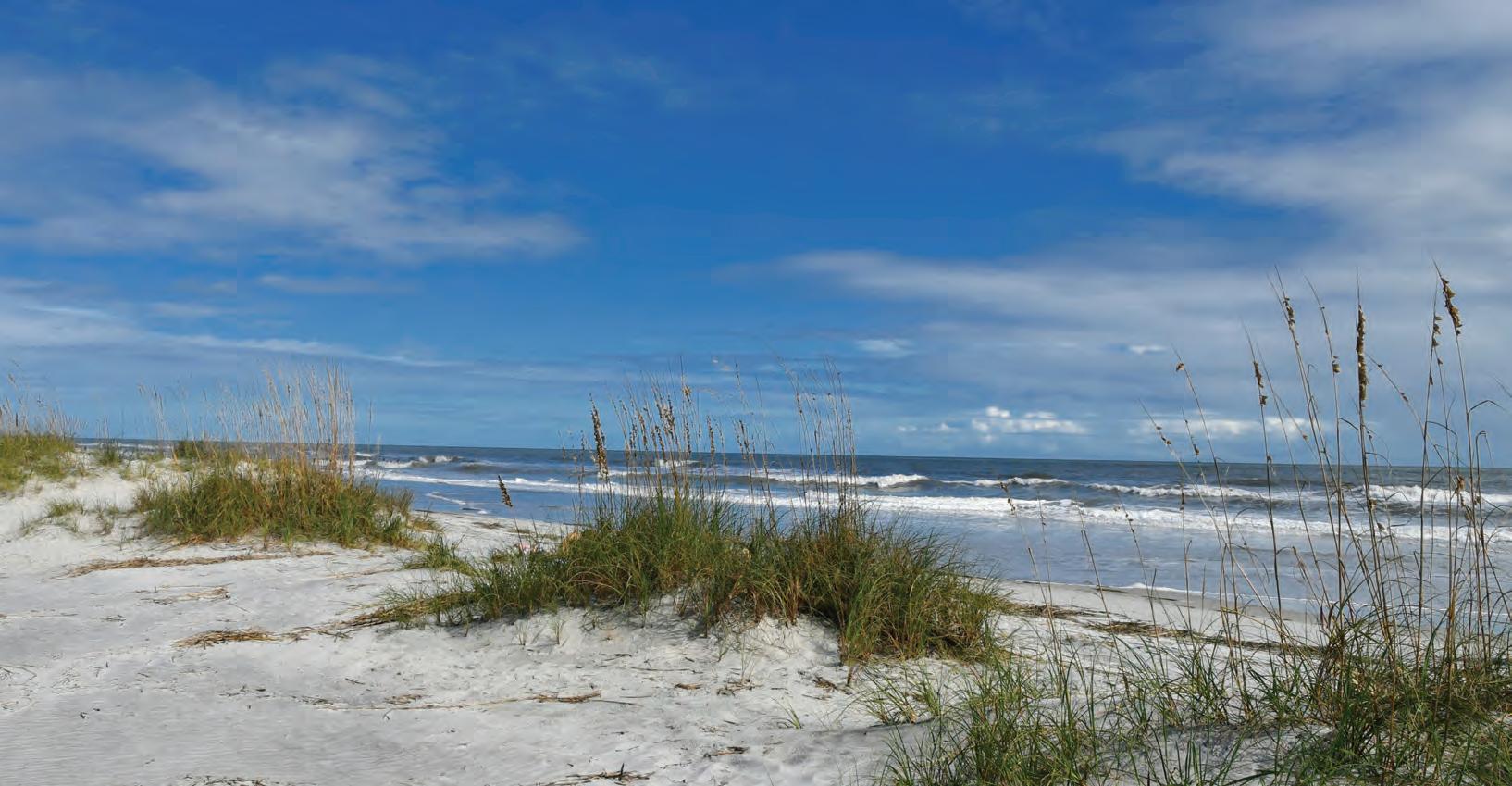
Directory of Merchants
Abita Springs, LA
Women’s Center for Healing 24
Baton Rouge, LA
Alzheimer’s Service of the Capital Area 16
Allwood Furniture 15
Becky Parrish Advance
Skincare 54
BREC 36, 37
Blue Cross Blue Shield 13
Calandro’s Select Cellars 11
East Baton Rouge Parish Library 60
Elizabethan Galler y 47
Lagniappe Antiques 50
Louisiana Office of Tourism 34
Louisiana Public Broadcasting 53
LSU Museum of Art 19, 45
LSU Press & The Southern Review 20
Pennington Biomedical Research Ctr. 6
Tigers Trail RV Resort 51
WRKF 89.3 FM 54
Brookhaven, MS
Brookhaven Tourism Council 29
Donaldsonville, LA
Ascension of our Lord 47
Franklinton, LA Heritage Hill Farm 38
Grand Isle, L A Grand Isle Tourism Department 49
Hammond, LA
Tangipahoa Parish CVB 59
Jackson, MS Visit Mississippi 5
Lafayette, LA
Allwood Furniture 15
J & J Exterminating 38
Laplace, LA
LA River Parishes 26, 27
Mandeville, LA
Visit the Northshore 14
Mansura, LA
Avoyelles Arts Council 44
Avoyelles Tourism Commission 9
Morgan City, LA
Cajun Coast CVB 47
Natchez, MS
Katie’s Ladies Apparel 24
Monmouth Historic Inn 24, 29
Natchez Chamber of Commerce 23
Natchez Convention Promotion Commission 25
Natchez Olive Market 49
Old South Trading Post 25
New Roads, L A
Arts Council of Pointe Coupée 50 City of New Roads 37
Pointe Coupée Parish Tourist Commission 17
New Orleans, L A Historic New Orleans Collection 39
Opelousas, LA
St. Landry Parish Tourist Commission 36
Plaquemine, LA
Iberville Parish Tourism Department 21
Port Allen, L A
West Baton Rouge Museum 44
West Baton Rouge Convention and Visitors Bureau 12
Port Arthur, TX Visit Port Arthur 33
Scott, LA
Bob’s Tree Preservation 10
Shreveport, LA
Shreveport Bossier Convention and Tourist Bureau
Shreveport Bossier Sports Commission 2, 3
Sorrento, L A
Ascension Parish Tourism Commission 51
St. Francisville, L A Arts for All 53
Cross Quilter 50
Poppin’ Up Plants 50
Louisiana Hospitality Group 7
Magnolia Cafe Inc. 43
Town of St. Francisville 43
Walker Percy Weekend 57
Vicksburg, MS Visit Vicksburg 31
Zachary, LA
Lane Regional Medical Center 30
JUN 24 // COUNTRYROADSMAG.COM 56


// JUN 24 57
Mermaiding Mediums
THROUGH GYOTAKU, ARTIST HOLLY GARVIN BRINGS MARINE WORLDS TO THE SURFACE
By Mimi Greenwood Knight
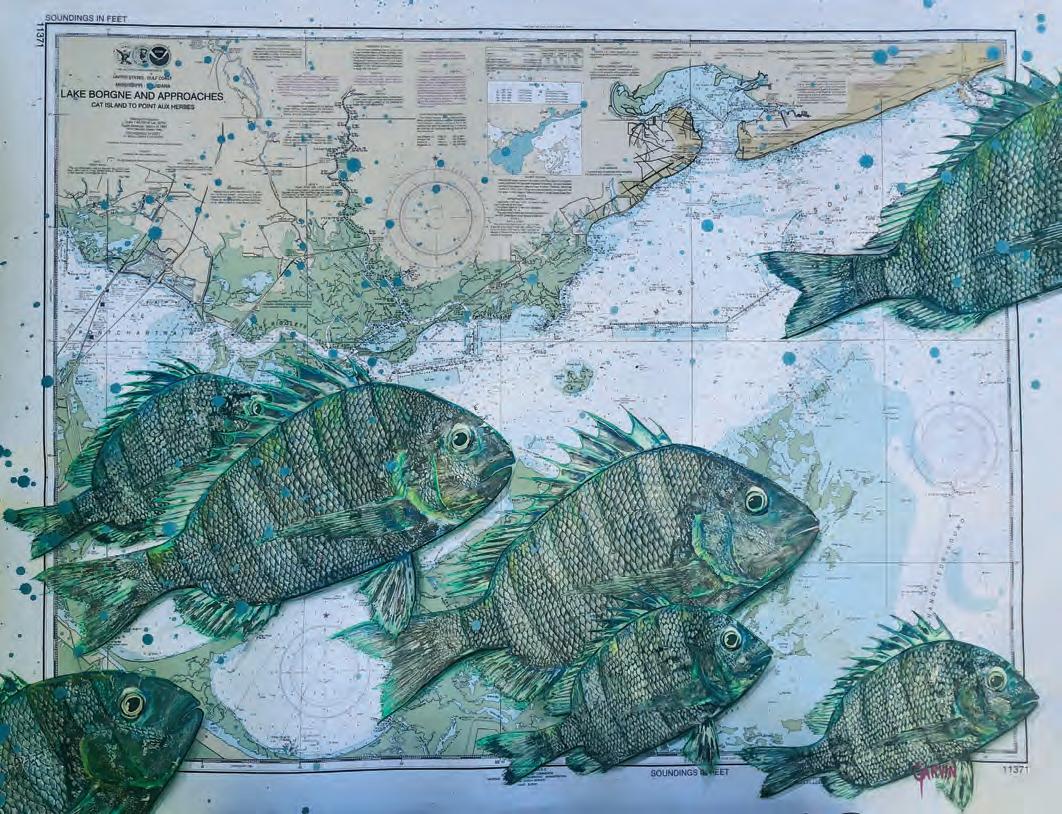
As a former hydrographer for the U.S. Navy, Holly Garvin has made a career thinking about what lies beneath the surface of hwater bodies. She uses sonar to produce high resolution images of the seafloor that are used to create nautical charts, which aid in the safety of navigation for the Navy, recreational boaters, mariners in the shipping industry, and the Department of Defense’s military operations.
As an artist, she reaches into those very waters herself, and shares what she discovers beneath through marine-inspired artwork often utilizing the Japanese printing technique of Gyotaku (pronounced Gee-oh-tak-oo) to memorialize the fish she catches in the Gulf of Mexico and elsewhere.
Garvin’s fascination with underwater worlds began when she was a little girl growing up on a small island, only accessible by boat, between Michigan and Canada. There, life revolved around fishing and boating.
“My mom was an artist, so the time my sister and I spent with her was spent doing creative, artsy things,” she said. “My dad owned a bait shop on the shore of Lake St. Clair. My job as a little girl was to stand on a stack of milk crates and fish the dead minnows out of the fish tank. I’d sink my arm all the way in, let the minnows swim across it, and imagine I was living among them.”
Canada was so close Garvin says she could hear music from the mainland. A highlight of each day was the arrival of ships just feet from her back door on the St. Clair River. “Because the shipping channel bottlenecked right in front of our house, every hour or two, these thousandfoot-plus ships passed so close I could stand in my yard,
wave to the crew, and see them waving back,” Garvin said. “As a little girl, I was convinced the best life and the best adventures were on those ships.”
When it came time to select a college major, Garvin wasn’t ready to leave the water. She chose to study marine science at Coastal Carolina University in South Carolina, a degree she says encompasses marine biology, marine geology, marine chemistry, and marine physics. She was quickly recruited by the Navy, which sent her to the University of Southern Mississippi for her hydrography training.
Over the next fifteen years, Garvin squeezed in time for her artwork between deployment on one naval vessel or another, living out of a suitcase for much of the year. Happily, with advancements in technology, she’s now transitioned into remote work. “I’m still a hydrographer, but I’m able to map remotely on my laptop,” Garvin said. “So, I can be home in my PJs doing the same job I did on a ship in the middle of the ocean.”
That “home” is actually encompassed by two small cottages over 1,000 miles from each other, one back in Michigan and one on the Mississippi Gulf Coast. Garvin has a boat at each and conducts much of her creative process right on the water. Typically, this includes catching a fish, covering it in ink, printing it, cleaning it off (the ink is non-toxic), and eating it for dinner.
Gyotaku, or “fish rubbing,” began in the 19th century as a way for Japanese fisherman to record their catches for bragging rights or simple documentation. Over time, what started as simple record keeping developed into an artform. The process Garvin and other Gyotaku artists employ involves coating a fish or other sea creature with sumi ink. Garvin sometimes creates temporary
structures to support the fish in the position she wants, splaying out its fins. Then, she carefully lays rice paper on top of the sea creature, delicately pressing the paper with her hands until it records the fish in detail, down to the tiniest scale. Next, she paints in the eyes and sometimes adds underwater details. When she’s in Mississippi, Garvin specializes in printing regional saltwater fish such as redfish and sea bass. In Michigan, she records freshwater fish such as walleye or pike. Many times, she’s even printed octopus.
While Gyotaku is traditionally restricted to black ink on white rice paper, Garvin has found ways to “funk it up,” incorporating other colors and materials including collage and sparkly elements inspired by the fishing lures that hung ceiling to floor in her family’s bait shop. She often merges her two passions, the science of hydrography and the art of Gyotaku, by applying her fish rubbings directly onto her nautical charts. “I might catch a fish in a certain spot, then print it on a chart of that location,” she said. “I love the idea of combining boating, science, water, and fish—all the things I care about in one piece of art.”
Garvin also accepts commissions, such as one from the owners of a Rhode Island sushi restaurant who recently shipped her a dozen fish common to their region to print and frame. “I love to paint pictures of someone’s fishing boat on a map of their favorite fishing spot,” she said. Another commissioned piece depicts every naval vessel on which a certain sailor served, printed onto a nautical chart that was meaningful to them. Another commission was for a retiring Louisiana tugboat captain, a rendering of his tug with the names of his grandchildren on its tires.
After her father died, Garvin studied the GPS from his boat and painted it on a nautical chart of Lake Saint Claire, the lake they had grown up on, then used colorful thread to track navigation lines of his frequent routes.
On any given day, Garvin may answer a knock at her door and find a fisherman with an ice chest of fish they’ve caught and would like her to print. Or she’ll receive a package of fish packed in dry ice and shipped from another state. Her newest art experiment involves fish she buried in the backyard, whose bones she hopes to cobble into artwork. “I’m thinking about fishbone mobiles, but we’ll have to see where it takes me,” she said.
Whether she’s creating traditional Gyotaku prints, painting a marine-inspired mural, memorializing the life and adventures of a specific fisherman, or mapping the ocean floor, the mysteries of the deep are never far from Holly Garvin’s mind. •
Garvin’s work can be seen at her studio space on the third floor of The Shops of Century Hall in Bay St. Louis and at popups around Coastal Mississippi, as well as on her Instagram @mermaiding_mediums
JUN 24 // COUNTRYROADSMAG.COM 58 Sponsored by Tangipahoa Parish Tourism
PERSPECTIVES: IMAGES OF OUR STATE
Artwork by Holly Garvin.

// JUN 24 59
ADVENTURE BEGINS AT YOUR LIBRARYTM
















 —Elise Riley
—Elise Riley









































































































































































































































































